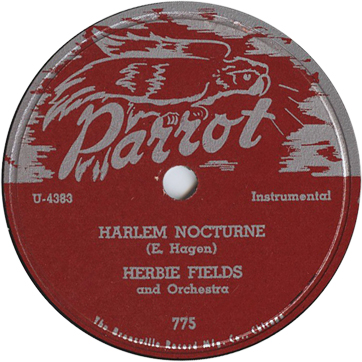
Our special thanks to Donn Fileti of Relic Records for his extensive additions and corrections to this discography.

Revision note. We have added to our biography of pianist Henry Gray, who died in Baton Rouge, Louisiana, on February 17, 2020; he was 95 years old. We have an earlier date for Savoy's first acquisition from Parrot/Blue Lake: it dawned on us that this took place while the label was still active and Al Benson still owned it. Savoy 1165, with two Joe Williams sides recorded for Blue Lake, came out in July 1955. We've discovered that Parrot did not merely lease masters from Swing Time for distribution—there was a formal alliance between the companies from September 1953 through January 1954, during which time they shared a national sales manager. An advertisement for Parrot 1000 and Parrot 782, from Cash Box on August 29, 1953, has led us to realize that the Bessie Griffin single (Parrot 1000) is from 1953 and was released in the company's second official batch.
Parrot Records was the creation of noted Chicago DJ Al Benson (1908-1978). Born Arthur Leaner in Jackson, Mississippi, he arrived in Chicago in 1923. (There is a biographical profile in "Al Benson—The Godfather of Black Radio in Chicago" by the late Charles Walton, available on the Jazz Institute of Chicago website.) In his earlier days, Benson sang, produced shows at a theater in Jackson, worked as a probation officer, and preached. Al Benson began his career as a DJ in 1943, with a new gospel show on Chicago radio station WGES. His skill at selling commercial time on his church program landed him an R&B show at WGES toward the end of 1945. Quickly he became one of the biggest powers in the R&B business.
Benson began doing freelance recording in the spring of 1948 (when he taped at least 6 tracks at a live session at the Pershing Ballroom, edited them, and sold them to Aristocrat). He was in the studios a few months later, recording four numbers by the Benson All-Star Orchestra (see the Eddie Johnson pages for details), followed in the fall by a session with the Four Shades of Rhythm.
Benson opened his first company — it was called Old Swing-Master, after his DJ handle — in January 1949. Benson was really a front man; the outfit had come into being so his business partner, Egmont Sonderling, who owned Master Records and the United Broadcasting Studios, could issue jazz and R&B masters that Vitacoustic had recorded at his studio and failed to pay for. The label sustained itself by ingesting material acquired from defunct local labels like Rhumboogie, Marvel, Planet, and Sunbeam. Just the releases by the Benson All Star Orchestra, Old Swing-Master 15 and 16, and the Four Shades of Rhythm, Old Swing-Master 23, came out of Al Benson recording projects. And, so far as we can determine, those projects were done before the label was launched. Benson may have done a little freelance recording for sale to other labels while involved with Old Swing-Master; at least the session done at some point in 1949 by the Blues Rockers (later sold to Aristocrat) is thought to be his work. By the end of 1949, Old Swing-Master became inactive except as a conduit for some material Miracle had turned over to Sonderling to settle debts. Sonderling decided to phase out his involvement in the record business, closing down his pressing operation and acquiring radio station WOPA. Consequently Old Swing-Master shut down in June 1950.
Benson couldn't stay away from recording for long. In March 1951, he supervised a session by jazz violinist Eddie South, which he sold to the Chess brothers (see our Eddie Johnson page for details). The session includes Benson himself singing (well, reciting) "I Can't Give You Anything but Love." In 1952 he started a series of recording sessions at Universal Recording, in the hope of selling the material to established companies; a U4300 matrix series was opened for this effort. The Chess brothers were his best (as far as we know, his only) customers, purchasing masters by Willie Mabon, Danny Overbea, and Joe Williams and issuing them on their Chess and Checker labels. Our King Kolax discography presents details of the Williams and Overbea sides.
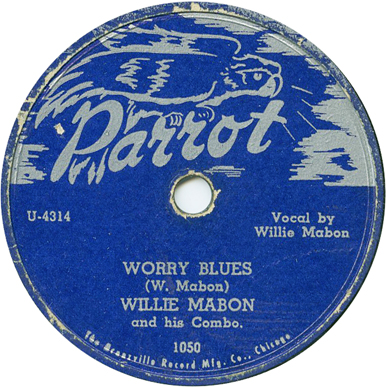
Benson seems to have had Parrot in mind well before he had amassed the wherewithal to launch his own record company. The very first items to appear with a Parrot label are in the same U4300 matrix series out of Universal.
Our year-by-year lists takes their sequence in part from the matrixes, in part from the numbers on the tape boxes (as preserved on list of tapes transferred to Chess around 1959), in part from the release numbers, and in part from known recording dates. As we do not know exact recording dates for some of the sessions, and the matrixes are not always in sequence with the recording dates that we do know, this yields a somewhat vague ordering. The placement of the Blue Lake issues, with their separate matrix series, within the Parrot sequence poses special difficulties. The earlier Blue Lakes apparently had matrix numbers in the Parrot series originally, but hardly any of these can be recovered.
Nearly all Parrots and Blue Lakes were recorded in Chicago, at Universal Recording. The material that Al Benson purchased from Swing Time in the Fall of 1953 was recorded in Los Angeles (see the section on the Swing Time deal). The Jimmy Rushing session of December 1953 was recorded in New York City. Some sources have claimed, we think incorrectly, that the Herbie Fields was done there as well.
Whenever possible, we have taken the names of the artists and the titles from the physical artifacts; i.e., the records. Matrix numbers verified from the record are marked in bold type.
In November 1952, Al Benson made preparations for launching his own record company. He had decided to call it Parrot and adopted a label design, but had to put the operation on hold after recording a hit and lacking the means to distribute it.
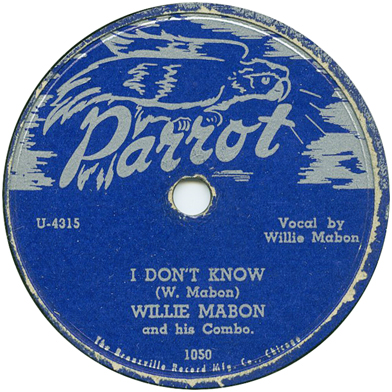
Parrot 1050, "I Don't Know" by Willie Mabon, was released early in November 1952. Its labels put the familiar Parrot logo on a blue background unknown from any later release. Because "I Don't Know" was an extremely popular number, extant copies of Parrot 1050 tend to show wear. Benson had been working with the Chess brothers, and he quickly made the obvious concession to practicality. Probably within a couple of weeks "I Don't Know' was out on Checker 1050 (most likely this was just a Parrot pressing with a Checker label pasted on; Parrot and Checker 1050 were both 78-only). It obvously didn't belong to the 750 series; as the 750 series ground on, more than a decade elapsed, and no one remembered the rebranded Parrot any more. So an-inseries Checker 1050 appeared, on 45 rpm only, in July 1963. This was by Gloria Brown.
As soon as the Parrot pressings were exhausted—before the month was out—"I Don't Know" was on Chess 1531. Chess 1531 hit #1 on the Billboard Rhythm & Blues chart and remained on the chart for 15 weeks. The Parrot release date comes from Bernd Kratochwil's article on the Parrot label in the German magazine Rockin' Fifties (Teil 3.1, 1998). The trade papers didn't bother to cover the Parrot release, but the first mention of Chess 1531 (attributed to someone called "Little Mahon"!) came in the "This Week's Territorial Best Sellers to Watch" box in Billboard, November 22, 1952, p. 41.

During the first half of 1953, two more singles, Parrot 772 and 775, were assigned numbers in the Checker release series. But we've found no evidence of a Checker 772 or a Checker 775. Checker 779, on the other hand, coupled two Browley Guy sides that had obviously been recorded by Benson, because were eventually sold to Relic Records with other Parrot and Blue Lake material. But we've never seen or heard of a Parrot 779. Though Benson was applying numbers from another company's ongoing series (Checker started at 750 in 1952) to his own releases, 779 marked the watershed. Starting at 780, Checker and Parrot releases would be completely independent of one another.
We have not included any other sessions in the U4300 matrix series, because after a few months it stopped being reserved for material that Benson recorded. To the lasting confusion of discographers, in January 1953 Chess began slotting in sessions by its own artists, including Muddy Waters, Little Walter—and Danny Overbea after he had signed with the Chess brothers.
The preliminary Parrots featured a piano-playing bluesman, two vocal groups, and a jazz combo.
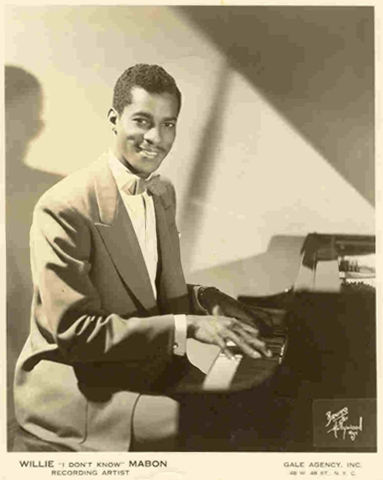
Willie James Mabon (born October 24, 1925, in Hollywood, Tennessee) was the piano-playing bluesman. He cut his first solo sides for JOB in August 1949; these were actually released as a single on Apollo, under the name Big Willie. But Apollo waited until he had scored hits for other labels. Though most of his club gigs during the period were solo or trio affairs, he next recorded with Earl Dranes and The Blues Rockers for Aristocrat. The first session took place at some point in the second half of 1949 (under Al Benson's direction), leading to one release in January 1950, and the followup was done for the Chess brothers in March 1950, but it led to no releases on either Aristocrat or Chess. The band was then signed by Parkway in April, but no recordings ensued, and by August of that year Mabon had returned to working as a solo perfomer. When Mabon did his October 1952 session with Benson, he was on the brink of becoming famous for his incisive lyrics. What put him on the map was his reorganized version of a Cripple Clarence Lofton number, "I Don't Know" (see our Session pages for Lofton's 1943 recording). "I Don't Know" was a major hit, though not for Parrot.
Mabon remained with the Chess brothers through 1956, but his sales dropped over time and his exit from the label was not a happy one. He did one session for Federal in 1957. In 1960, he worked a session that was intended for release on the LaSalle label; it also featured Tom Archia on tenor sax. That same year he cut two singles that were released on Tommy Jones' Mad imprint, and he recorded an unsuccesful return session for Chess. In 1962, he was with the Formal label; in 1963 and 1964, he did four sessions for the USA label, one of them with a Red Saunders combo. He took one last shot at recording in Chicago for Checker in 1969. Later on he settled in Europe. Willie Mabon died in Paris on April 19, 1985.

The Parrots were an old-fashioned vocal harmony group, accompanied by what sounds like one of Chicago's top-of-the-line lounge trios, at a time when many still used piano, guitar, and bass. It might be Robert "Prince" Cooper's trio, or Duke Groner's, or it could be a popular but less-recorded outfit—there isn't enough soloing by the trio members to support a reliable judgment. The session added a drummer who liked to attach a few doodads to his kit, judging from "Weep Weep Weep."
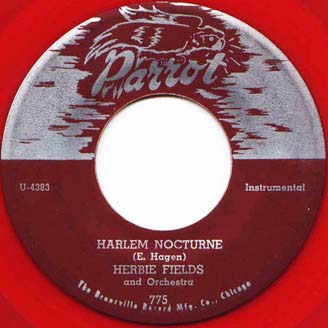
Herbie Fields (born on May 24, 1919 in Elizabeth, New Jersey) was a New York-based multi-instrumentalist who performed on clarinet and alto and tenor saxophone. He ran with the best jazz musicians in the world in the early 1940s, appearing on some of the private recordings cut at Minton's by his friend Jerry Newman. Fields was a good enough tenor saxophonist to jam with the likes of Coleman Hawkins, Don Byas, and Dexter Gordon, but he was never quite able to reach their level of artistry. Fewer questions were asked about his clarinet and alto sax work; his technical mastery of the alto sax was particularly impressive. He recorded in 1944 for Signature; in 1945, while a member of Lionel Hampton's band, he made three sessions for Savoy. In 1946 and 1947 he did a series of recordings with a big band for Victor. In the late 1940s and early 1950s, he worked with combos that were often billed as R&B units. After a long dry spell, he cut another big-band session for the Decca subsidiary Coral in 1952.
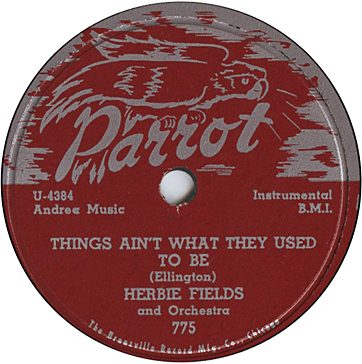
Some say the Herbie Fields sides were recorded in New York City (jørgen Grunnet Jepsen's discography adds that they were from a broadcast, but the sonics don't bear that out). Bernd Kratochwil has suggested that they were cut in April 1953, while Herbie Fields was working a four-week engagement at the Preview Lounge in Chicago. This is the most plausible date, though in the list of Parrot tapes acquired by Chess in 1959 the file number on the tape box for the Herbie Fields session is 1854, which would put the date in June. But some other Parrot tapes that were consolidated on June 10, 1953 at Universal Recording may actually have been recorded earlier.
On his Parrot sides, Fields played alto, tenor, and baritone sax. His baritone work was also excellent and would have drawn a lot of attention had he chosen to feature the instrument more often.The personnel given in Lord's Jazz Discography and in earlier sources was Lee Katzman on trumpet, Eddie Bert on trombone, Joe Black on piano, Rudy Cafro, electric guitar, Dan Martucci, bass, and Phil Arabia, drums. Shirley Klett has shown that this was actually the lineup for a six-day gig at a club in Providence in September 1952, and that Eddie Bert never worked with Fields on any other occasion! According to Klett, Rudy Cafaro confirmed being on Parrot 775; Joe Gatto, who worked with Fields earlier, confirmed that Joe Black was on piano; Lee Katzman denied being on trumpet on the record, and Leonard Gaskin believed that the trumpet player was actually Jimmy Nottingham. So the revised lineup is Jimmy Nottingham (trumpet), unidentified (trombone), Joe Black (piano), Rudy Cafaro (electric guitar), unidentified (bass), and unidentified (drums). If there is a further rub, it's that Jimmy Nottingham is known to have worked with Fields from early 1950 through early 1951, and his presence in Fields' April 1953 combo is unverified.
"Harlem Nocturne" (Parrot 775), which showcases Field's command of the alto sax, is a juke box jazz number competitive with the sides that Tab Smith was laying down for United, or that Earl Bostic was cutting for King. It was released in July 1953, receiving a review in Billboard on July 25 (p. 38). It was an early success for the new company; it spent one week on the Billboard pop charts, at #24 during the week of September 12, 1953. Where "Harlem Nocture" was a movie composer's tribute to Johnny Hodges, "Things Ain't What They Used to Be" was actually written for him—again, Fields scintillates on the alto.
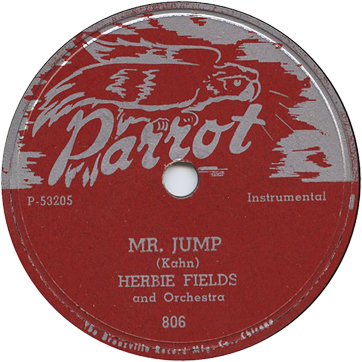
On "Mr. Jump," whose title tells all, Fields plays tenor sax and baritone sax in the ensembles via overdubbing. Cafaro, the trombonist, Nottingham, and Fields (on tenor) are the soloists. Released the in the summer of 1954 on Parrot 806, it did not enjoy the same level of sales. On the ballad side, "I Love You," Fields is featured on baritone sax, which he plays with a strong dark tone and a wide vibrato.
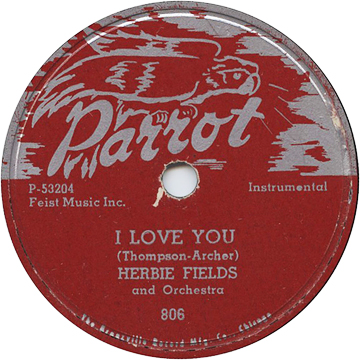
After Parrot, Herbie Fields cut more sides for Decca in 1954 (in New York) and 1955 (in Los Angeles). He resettled in Miami, where he cut an LP for RKO Unique with his local combo in 1956. His last recording was a 1958 LP for RKO Unique that included a string section. Herbie Fields committed suicide in his Miami home on September 17, 1958.
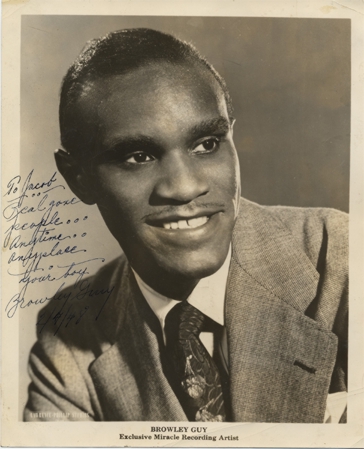

Browley Guy, whose name has been variously misrendered as "Brawley," "Briley," or "Brownley," was born around 1919, as he was a 1936 graduate of Wendell Phillips High School in Chicago. Guy had previously appeared on Miracle with Sonny Thompson and his Sharps and Flats, Eddie Chamblee's group and Leon Abbey's trio (1947 - 1949). After Miracle, which had had high commercial hopes for him, folded, he was signed by Leonard Allen and Lew Simpkins, cutting two sessions for States in 1952—the first with the Guy Brothers Orchestra (which was really Browley Guy, two of his brothers, and the Red Saunders band) and the second with a Paul Bascomb group. A crooner, Guy led an old-fashioned vocal ensemble that was particularly known for schmaltzy ballads, though their uptempo stuff was much hipper. "I Like Barbecue" and "Marie" from his first session for States are quite listenable. On his session for Al Benson he used a lounge trio (piano, guitar, and bass) for accompaniment. Guy's last session was done with a somewhat more modern-sounding edition of the Skyscrapers, for Mercury in 1956.

We know of 14 tracks in all from this preliminary phase. The formal launch of the new label took place in July 1953, and the first sessions to be released exclusively on Parrot took place in May or June.
| Matrix | Artist | Title | Issue | Recording Date | Release Date |
| U-4314 | Willie Mabon and his Combo | Vocal by Willie Mabon | Worry Blues | Parrot 1050 Checker 1050 Chess 1531 |
c. October 1952 | November 1952 (late November 1952) |
| U-4315 | Willie Mabon and his Combo | Vocal by Willie Mabon | I Don't Know | Parrot 1050 Checker 1050 Chess 1531 |
c. October 1952 | November 1952 (late November 1952) |
| U 4315A | Willie Mabon and his Combo | See Me Cry | unissued | c. October 1952 | |
| U 4315B | Willie Mabon and his Combo | L.A. | unissued | c. October 1952 | |
| 4352 | The Parrots | Weep, Weep, Weep | Parrot 772 | March 1953 | April 1953 |
| 4353 | The Parrots | Please Don't Leave Me | Parrot 772 | March 1953 | April 1953 |
| U-4383 | Herbie Fields and Orchestra | Harlem Nocturne | Parrot 775 | April 1953? | July 1953 |
| U-4384 | Herbie Fields and Orchestra | Things Ain't What They Used to Be | Parrot 775 | April 1953? | July 1953 |
| P-53204 | Herbie Fields and Orchestra | I Love You | Parrot 806 | April 1953? | prob. summer 1954 |
| P-53205 | Herbie Fields and Orchestra | Mr. Jump | Parrot 806 | April 1953? | prob. summer 1954 |
| U4385 tk. 2 | Browley Guy and the Skyscrapers | Watermelon Man | Checker 779 | June 10, 1953 | July 1953 |
| U4386 tk. 4 | Browley Guy and the Skyscrapers | You Look Good to Me | Checker 779 | June 10, 1953 | July 1953 |
| U4387? tk. 7 | Browley Guy and the Skyscrapers | Blow Joe | (Relic 7027) | June 10, 1953 | |
| U4388? tk. 4 | Browley Guy and the Skyscrapers | I'll Be Seeing You | (Relic 7027) | June 10, 1953 |
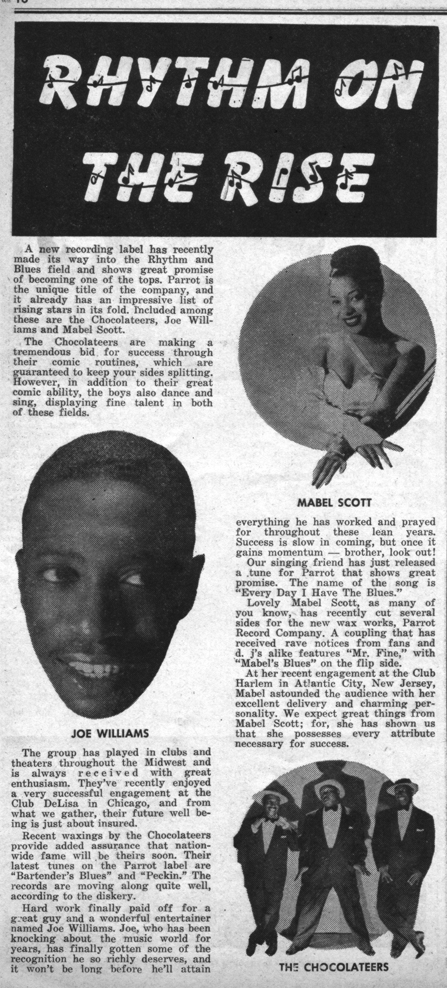
After these fits and starts, Parrot opened a continuous number series, independent of Checker, with 780 and 781. Parrot began displaying such wares (with trade advertisements that proclaimed "New Label") in July 1953. However, advertisements for Parrot 775, which was part of the joint venture, were also appearing that month (July 25, to be exact). In December 1953, a long article about the new record label came out (it is reproduced at left, courtesy of the Simon Evans / Man in Japan collection). Oddly, this still mentioned the the same artists as the "New Label" advertisement (Mabel Scott and The Chocolateers) but added singer Joe Williams, who started recording for Parrot in September. And the only Joe Williams title to be mentioned was "Every Day I Have the Blues," which was indeed recorded by Al Benson, but in 1952, before he launched Parrot (see our King Kolax page for details). Not so oddly, the article avoided mentioning that Al Benson owned the label—there was a good deal of sensitivity about DJs being involved in the record business, and Benson had previously caught flak for his role in Old Swing-Master.
Members of different vocal groups that recorded for Parrot or Blue Lake told Robert Pruter (Doowop: The Chicago Scene) that Al Benson "seemed to run the company alone, almost as a hobby. He was president, administrator, A&R man, producer, and in Chicago, distributor." It looks like he took things too easy. When two members of The Fascinators, a band from Detroit, complained to Benson that they could not hear their record in their hometown, Benson gave them some copies of the record and added the address of a distributor! (See The Fascinators' session below, in the 1955 listing.)
In an interview with Charles Walton (see "Al Benson-The Godfather of Black Radio in Chicago" in Bronzeville Conversations), DJ Lucky Cordell recalled that Benson would not only select the records that each of his DJs was to play, he would physically stack them in the desired order:
Benson's most obvious weakness, to me, was that he did not have the ability to delegate authority; he had to run it himself. You cannot run your agency, do your radio program, interfere with all the DJs and their programming, run your newspaper and so on. He had someone running his newspaper but he was forever interfering with him. If he had the ability to delegate authority, the man could have been filthy rich.
Benson seems not to have monitored his matrix numbers closely. Unissued tracks were sometimes left without one. Benson started 1953 with a U4300 series that he had used for material sold to Chess and Checker, but the series was quickly taken over by the other company, and he dropped it for good after the Browley Guy session. When it was time for Parrot's formal launch, at least three of Benson's sessions tapped into a common matrix series that Universal used with various small labels, including Chance and JOB; in June 1953 it had reached U2550. But then he tagged two more items from the Mabel Scott session with numbers in a later series and did the same with two items from the Herbie Fields session.
In August, Benson settled on the 53100 series, in which the first two digits were to represent the year of recording and the last three were to represent the sequence of releases. This system was adhered to for the remainder of 1953; while he was at it he attached 53100 series numbers to a couple of Mabel Scott sides recorded in June. From May or June through the end of the year Benson laid down 126 tracks that are listed here.
According to Donn Fileti, the E prefix on a few items recorded in 1953 stands for Eagle Records. Eagle was intended to become a Benson subsidiary, but plans for it were abandoned. (Of course, collectors can prove us wrong by producing a 78 or a 45 with an Eagle label on it!) E53135-E53138 are on the same master tape and presumably came from the same recording session.


The first sessions for the new label included Red Saunders' band backing two of the acts that they accompanied at the Club DeLisa. The Chocolateers were a three-man comedy ensemble. "Peckin'" is an eccentric Swing dance number, well suited to Red's band, and the arrangement leaves some spots for Red's musicians. "Bartender Blues" is strictly a slapstick routine with band accompaniment (there is a loud clatter from the tom-toms whenever one of the Chocolateers pretends to go upside another's head). The number was advertised as "Bartenders Ball," the label of Parrot 781 gives the title as "Bartender Blues." The remaining two sides from this session (which was apparently not among those dealt to Chess in 1959) have never seen the light of day.
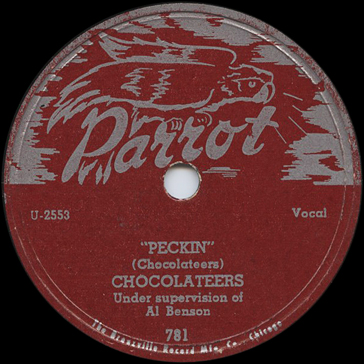

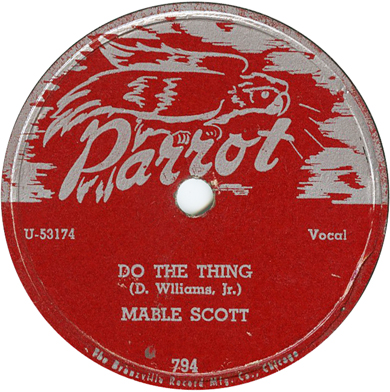

Mabel Scott was a glamor-girl singer based in Los Angeles. Born Mabel Bernice Scott in Richmond, Virginia, on April 30, 1915, she performed in Europe during the early years of World War II, then sang briefly with Jimmie Lunceford's big band. She made her first recordings in 1948 for the Los Angeles label Exclusive Records; her biggest hit with them was "Boogie Woogie Santa Claus." The Parrot sides were made during an engagement in Chicago: as duly noted in the Chicago Defender, Mabel Scott was the star attraction at the Club DeLisa for the week of May 16, 1953, in a revue called a "A May-Hey Day." On Scott's Parrot sides, the Red Saunders band is joined by guest trumpeter King Kolax. The standout title, "Mr. Fine," is an ironic ode to an abusive boyfriend. Mabel Scott continued to record for Decca and King and in the mid-1950s was appearing in Las Vegas as a pianist and entertainer. Her last records were made for an Australian label in 1955, while she was touring Down Under with a revue that also included the Chicago-based doowop group The Moroccos (see our Al Smith page for more on their involvement). For a brief period in the late 1950s, she was married to blue balladeer Charles Brown (1922 - 1999). Eventually she became an active church member and gave up performing. She died in Los Angeles on July 19, 2000.
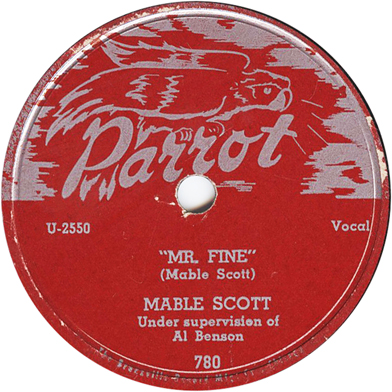

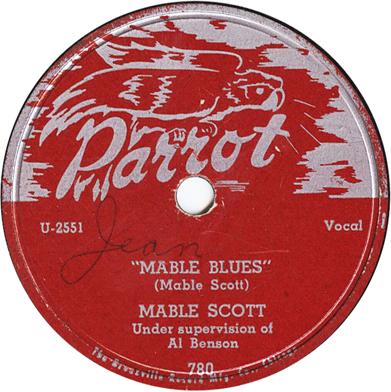

The session done by blues guitarist L. C. McKinley poses a lesser dating problem. The recording sheets from Universal indicate the date as June 10, in the same style and handwriting as the Browley Guy, Chocolateers, and Mabel Scott sessions. However, Leadbitter, Fancourt, and Pelletier's blues discography has given May 19, 1953 as the date for this session. Bob Koester reports that around 1962, a Blue Lake 78 by L. C. McKinley was in the possession of United Distributors in Chicago. However, the only gap in the Blue Lake release number series is 110, and even dedicated collectors like John Tefteller have never seen a Blue Lake 110. The first confirmed release of anything from the session was on a Relic CD in 1989.
L. C. McKinley, whose rarely used first name was Larry, was born in Winona, Mississippi on August 10, 1913. He arrived in Chicago around 1940. In 1951 and 1952, he recorded as a sideman with pianist Eddie Boyd for JOB; that's his guitar work on Boyd's biggest hit, "Five Long Years." McKinley was obviously a disciple of Aaron Thibeaux "T-Bone" Walker, both in his guitar attack and in the textures of his vocals. What's less Walker-like about McKinley's session for Parrot (which was his first as a leader) is the way tenor saxophonist Lorenzo Tucker (well, maybe that was his last name—Leadbitter, Fancourt, and Pelletier call him Lorenzo King) provides most of the fills and solos. Tucker basically carries "Rosalie Blues," while McKinley's guitar picking plays a secondary role.
L. C. McKinley went on to record as a leader for States in January 1954 (one single, two more sides unissued at the time). In 1955 he had a somewhat more extended stay at Vee-Jay: two sessions that led to two singles. He worked regularly as a sideman at the 708 Club on East 47th Street for much of the 1950s. His last recording as a leader was "Nit Wit" for Bea & Baby in 1959. He died in Chicago on January 19, 1970.
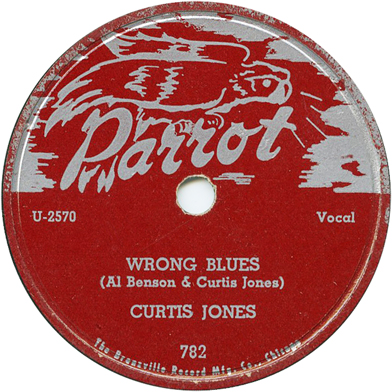
Kratochwil gives the date for Curtis Jones' sides in the U2500 series as May 19, 1953. That makes eminent sense, as they were made by the same band: Curtis Jones (piano), L. C. McKinley (guitar), Lorenzo Tucker (tenor sax), Ransom Knowling (bass), and Lawrence "Judge" Riley (drums).
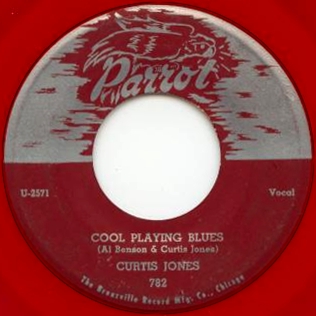
Pianist Curtis Jones was a blues veteran by this time. He was born in Naples, Texas, on August 18, 1906, and moved to Chicago in the early 1930s. Before World War II, he recorded frequently in sessions organized by Lester Melrose. Jones' first session for Parrot, done on May 19 and shared with L. C. McKinley, produced his last commercial single. "Cool Playing Blues" features the leader in typically relaxed voice and McKinley's guitar support is pure T-Bone. Lending the proceedings a somewhat old-fashioned flavor, the bass player and drummer had been on countless sessions for the Melrose combine during the 1940s.
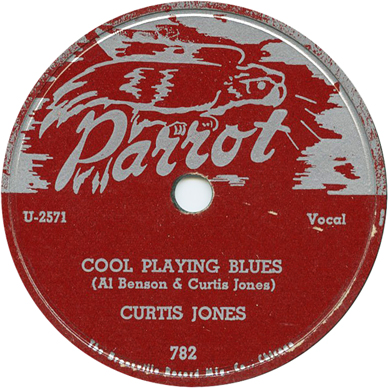
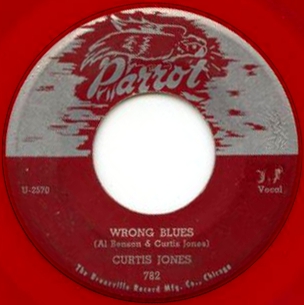
Curtis Jones returned to Universal Recording for his second and final session on August 10, 1953. Al Benson chose not to issue anything from it, but two tracks eventually appeared on a Delta Swing LP that also included unissued sides from the Chance vaults; these have been subsequently reissued on Oldie Blues and Document. The other two sides are still unissued after 50 years. Jones employed very nearly the same band as on his first session: Lorenzo Tucker (tenor sax), L. C. McKinley (electric guitar), Alfred Elkins (bass), and Judge Riley (drums). After his Parrot sessions, Curtis Jones went through a dry spell as far as recording was concerned. But when the blues revival began, he made LPs for Prestige/Bluesville and Delmark, then moved to Europe in 1962. He died in Munich on September 11, 1971.
Two further sessions have always proven difficult to date. They are neither on the Chess tape list nor among the Relic Records holdings, and their matrix numbers are off the main Parrot and Blue Lake series. We previously placed them in 1954, but the availability of Cash Box online (finally!) has required us to change our thinking.

According to Horace Clarence Boyer's book How Sweet the Sound: The Golden Age of Gospel., gospel singer Bessie Griffin came to Chicago in 1951. She was born Arlette B. Broil on July 6, 1922 in New Orleans. A contralto who was sometimes regarded as a rival to Mahalia Jackson, though her vocal quality was lighter and lent itself to pyrotechnics, she sang back home with the Southern Harps and the Gospel Consolators and for a time had her own radio show. Her first solo recordings were made for Sittin' in With in 1948.
Her extremely rare single on Parrot 1000 misspells her name as "Griffen." We'd thought it was a 1954 release, but Parrot advertised it in Cash Box on August 29, 1953, alongside 782 by Curtis Jones (see p. 25). So it was in the company's second official batch of releases; it was also the first green-label gospel Parrot. She sings solo on both sides, with bare piano accompaniment by one Eloise Suddath. The condition of the instrument (a plunky old upright) is inconsistent with an outing at Universal, or at any recording studio worthy of the name,. Our surmise is that she made the record as a demo (which would also explain why it didn't end up in Parrot's legacies either to Chess and to Relic). Bessie Griffin's vocal brilliance makes any such considerations insignificant. She gradually builds intensity through the stanzas of the "Story of Job," then seems to start "What Jesus Means to Me" where the previous number left off.
Bessie Griffin next joined Albertina Walker's Caravans for a spell, contributing blazing leads to two songs on the group's January 1954 recording session for States. But she didn't stay in the group long, intent on pursuing a solo career.
Bessie Griffin finally got a chance to record regularly when she signed with Specialty in 1956. Her later output included LPs on Decca (DL-74947, It Takes a Lot of Love) and Savoy (MG 14233, The Gospel Soul of Bessie Griffin, issued in stereo during the late 1960s.) She also recorded for Liberty, Nashboro, and Spirit Feel, and played a preacher in the 1974 movie Together Brothers. She died in Los Angeles on April 10, 1989.
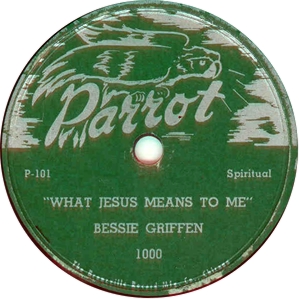
Then there are the oddest of the oddities, Parrot 6000 and 7000. Collector Brent Campbell turned up a copy of the previously Parrot 6000, which was subsequently acquired by jazz violin scholar Anthony Barnett and placed in the AB Fable Archive Collection. A second copy showed up on ebay in 2007. Meanwhile, just one copy of Parrot 7000 is known, in the collection of Bill Sabis. Parrot 6000 is by the Leon Abbey Trio with Al Benson singing (OK, OK, talking through the words) on one side. Parrot 7000 uses the same lineup, but puts Benson's "singing" on both sides of "Fool That I Am," a ballad that had been a hit for Gladys Palmer on Miracle. The material could have been recorded during the period before the official launch of Parrot. The slender evidence of the P100 matrix numbers—which put Parrot 7000 after 6000, and 6000 after the Bessie Griffin single—points to 1953.
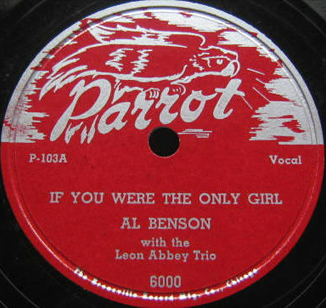
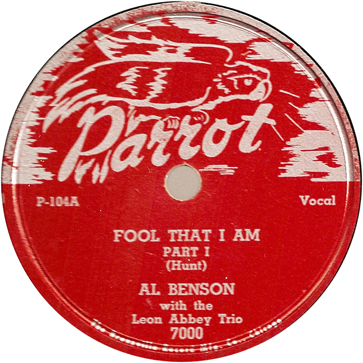
The much traveled violinist Leon Abbey was born in Minneapolis on May 7, 1900. Not really a jazz player himself, he nontheless spent most of his career working with jazz musicians. Abbey broke in playing light music with J. Rosamund Johnson's orchestra (1920-1925). On January 8, 1925 he cut two sides accompanying blues singer Clara Smith: "You Better Keep the Home Fires Burning" and "If You Only Knowed." In 1925 and 1926 he led a band called the Savoy Bearcats that enjoyed a long residence at the Savoy Ballroom in New York City and recorded three sessions for Victor in August 1926. In 1927 the band spent a year based in Buenos Aires, with excursions through Argentina, Uruguay, and Brazil, but when Abbey obtained a gig in Paris, the former Bearcats returned to New York and he had to put together a new group. He spent the next 11 years in Europe, not counting two trips to India. He recorded some unreleased sides in England in 1928 and did a further session in Sweden (in 1938) that was released. As World War II loomed, Abbey returned to the United States, where he directed Ethel Waters' band in 1940.
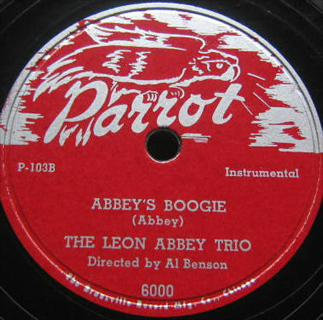
After touring for a while with his own band, Abbey settled in Chicago. From 1947 onward he worked regularly in a trio with Barrington Perry (piano) and Robert Lee "Rail" Wilson (bass). Worthy of note is the fact that Al Benson used Perry and Wilson in his Benson All Star Orchestra, which around September 1948 cut the very first studio session he is known to have supervised (see our Eddie Johnson discography for details). Abbey's trio accompanied crooner Browley Guy on a 1949 session that Miracle left in the can; some of his best jazz work is on these sides, which we hope will be issued some day. The Defender for March 15, 1952 has Abbey's combo at the Pershing Lounge; he was also doing a 15-minute spot on a local radio program at the time. In the mid-1950s Leon Abbey operated his own nightclub in Chicago. He continued to work with his trio until 1964, when he retired. He died in Minneapolis on Sepember 15, 1975.
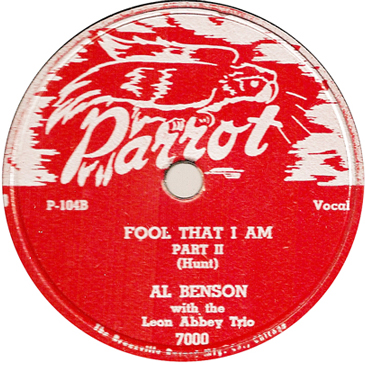
Tenor sax player Nature Boy Brown is better known to us as J.T. Brown, the name he used on most of his other recordings. He was born John T. Brown in rural Mississippi on April 2, 1910. Brown worked down South with the Rabbit Foot Minstrels before moving to Chicago. There his bleating tenor sax made him a popular sessionman, working behind such bluesmen as Roosevelt Sykes, Eddie Boyd, St. Louis Jimmy, and Elmore James. He recorded a fair number of sides as a leader. His first session under his own name was a sprawling affair done in 1949 for J. Mayo Williams: the 8 sides variously appeared on Wiliams' Harlem label, Ivan Ballen's Apex label, and on Decca. Brown hit a high point at the opening-day session for United, in July 1951—his first single sold well in the early going. He picked another for the same label in January 1952 (both included trumpeter King Kolax). Unfortunately, his decision to use one Freddy Underwood, a non-Union alto saxophonist, on the January 1952 session got Leonard Allen and Lew Simpkins into major trouble with Musicians Union Local 208 and iced his prospects with that company. Brown joined Elmore James' touring band, the Broomdusters, in June 1952 and appeared on three of their sessions for the Bihari brothers' labels Meteor and Flair; he also got three instrumental sides and one vocal as a leader. He appeared as a sideman for a January 1953 JOB session featuring bluesmen J. B. Lenoir, Sunnyland Slim, and Johnny Shines.
This Parrrot session of August 10, 1953 took place when Brown was on hiatus from the James band, whose leader would go on long retreats to his home in Mississippi. Meanwhile, Brown was pulling them into the Chicago nightspots that year, notably at Ralph's Club (2157 West Madison) and Jimmy's New Apex Lounge (in suburban Robbins), so one can understand why Benson wanted to record him. But there must have been second thoughts, as these sides lay unreleased until Relic put them out in 1989. We don't know why: Brown is in good form vocally on "I'm Wise" and tenoristically throughout. Brown is accompanied by trumpet and alto sax (as on his ill-fated session from 1952), piano, bass, and drums. We think that Brown's old band-mate King Kolax joined in on trumpet. And the rhythm section could well have been Curtis Jones, Alfred Elkins, and Judge Riley from the first session of the day—but some comparative listening is still required.
J. T. Brown went on to record for a session for JOB around January of 1954; he also did one side for Ebony that year that was practically a field recording. Eventually, he received forgiveness from Leonard Allen at United, where he was able to return for a session in 1956, but the company was in decline by then and the tapes were left in the can. In the late 1950s, Brown often gigged with Elmore James when the guitarist was in town. In 1959 he recorded a single under his own name for the tiny Atomic-H label. J. T. Brown died in Chicago on November 24, 1969, not too long after a memorable performance of his "Black Jack Blues," on a Blues Horizon album with the British group Fleetwood Mac.
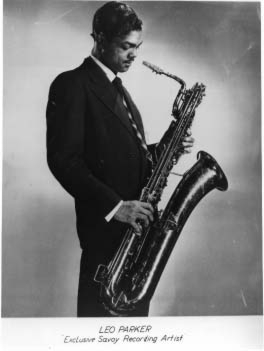
Leo Parker (born on April 18, 1925 in Washington DC) had risen to prominence in the Billy Eckstine band of 1945; he was the first bebopper to play the baritone sax, and a prime inspiration to Mac Easton of the Red Saunders band. After reeling off a string of recordings for Savoy and Apollo in the late 1940s, he dropped to a much lower profile in the early 1950s, as he struggled with a serious heroin habit. Still, he was able to record in Chicago for Chess (see our Eddie Johnson page), United, and Parrot.
In the summer of 1953, Parker was interested in settling in Chicago; on August 20, he and his agent appeared before the Board of Musicians Union Local 208, asking permission for him to join. (He was allowed to do so, with the interesting restriction that he not be allowed to work the Flame Lounge for an entire year! Was some effort afoot to bring him in and push out Melvin Moore's house band, which had been in residence at that nightspot for over a year?) His Parrot session, with a pianist (also responsible for a spot of celeste on "Smoke Gets in Your Eyes"), bassist, and drummer still unidentified, was mysteriously left in the vault by Al Benson and remained unknown until it appeared on a Chess Vintage Series LP in 1972. The list of Parrot masters acquired by Chess gives us the correct matrix numbers on these sides for the very first time (we'd already guessed that they ran from 53107 to 53110), and confirms that they were recorded the same day as the J. T. Brown and the second Curtis Jones sessions.
Leo Parker did not stay that long in Chicago, and he was out of circulation for long periods during the remainder of the decade. Shortly after cutting a comeback LP for Blue Note, Leo Parker died of cancer in New York City, on February 11, 1962.


The standard date for the Coleman Hawkins sessions is clearly wrong. Following all preceding discographies, John Chilton's book The High and Mighty Hawk put them on May 27, 1954, while Hawk was headlining at the Beehive in Chicago. But the releases on Parrot 783 and 784 took place in September or October of 1953. And their matrix numbers are early in the 53100 series, sandwiched between a batch of sessions from August 10 and another bach of sessions from September. The date wasn't May 27, 1953, either. Coleman Hawkins was pictured in the Chicago Defender of June 4, 1953, annoucing a gig at the Beehive slated to start on June 12 of that year (Hawk's contract for 4 weeks was accepted and filed by Local 208 on June 18). Hawk moved to the Toast of the Town on August 7; members of his band on that job—Laurell Howell, Tom Phillips, and guitarist Leo Blevins—were hauled in front of the Board of Local 208 on August 20, 1953 because of some dispute arising out of Hawk's gig. (Unfortunately, Local 208's Secretary, William Everett Samuels, who had a gift for taking down beefs using the speech patterns of the contending parties, was on vacation, and his stand-in didn't bother to note what the dispute was about.)
Our conclusion: Hawk's Parrot sessions took place in August, during the Toast of the Town engagement. The gig was over by the end of the month, judging from the fact that Leo Blevins next picked up a job as a leader at the Paris Club (contract posted September 3). (The matrix numbers 6994-7001 were affixed to these tracks after Savoy purchased them in 1956; Al Benson attached Parrot matrix numbers only to the four sides that he decided to release.)
Coleman Hawkins, the father of the jazz tenor saxophone, should need no introduction here. Born in St. Joseph, Missouri, on November 21, 1904, Hawk broke in with Mamie Smith's Jazz Hounds in 1920. He began recording with Fletcher Henderson's big band in 1923 and by the middle of the decade was a star soloist. The 1950 - 1954 period was a down time for Hawk, who, like many other Swing-era stars, was having a tough time getting recorded; his 12 sides for Parrot are one of his biggest bodies of work from this period. Since Al Benson usually cut 4 sides to a session, and sometimes reduced his target to 2, he must have been thinking of putting out an LP on Hawk. But if that was Benson's plan, nothing came of it. (Incidentally, Benson committed one of the all-time bloopers when he rendered "I'll Follow My Secret Heart" as "I'll Follow My Sacred Heart"!)
Six of the Hawk releases (including all 4 that were released on Parrot) back him with organ, piano, guitar, bass, and drums. We thought the organist was Lonnie Simmons, who was in the midst of a long-running gig at the Club DeLisa at the time, and would record his own session for Parrot in a couple of months. But Craig Browning notes that the organist sounds like the legendary Les Strand (who was credited, in an entry in Leonard Feather's encyclopedia, with making his debut on a Coleman Hawkins recording for "Peacock"). Comparing these sides with Les Strand's 1957 LP for Fantasy, and Lonnie Simmons' own session for Parrot, Browning says that Simmons "plays with more block chords and heavier vibrato than does Les Strand" (email, December 21, 2004). The guitarist solos on "Blue Blue Days"; he appears to be Leo Blevins, who was on Hawk's Toast of the Town gig. On "What a Difference a Day Made" Hawk's accompaniment swells to include a rather square choir, though unlike their counterparts on Charlie Parker's "Old Folks," they sing nothing but scat syllables. The choir, still restricted to nonwords, resurfaces on the second ballad, "I'll Follow My Secret Heart." The pianist gets a solo on this number. "I'll See You Later" is a straightahead jazz performance. Strand clogs the texture a bit, and his solo is definitely pre-Jimmy Smith, but Hawk keeps the number aloft. The tracks later titled "On My Way" and "Last Stop" are also from this session; they are instrumentals mercifully sans choir.
The six tracks that were given matrix numbers 6994 through 6999 by Savoy later on came from a different session than those later numbered 7000 through 7003 (including all 4 sides that Parrot issued at the time). As first released, on Savoy MG-12013, they were grouped together on the B side of the LP. As Browning notes, the piano is out of tune on 6994 through 6999, in tune on the other tracks. These are strictly quartet sides by Hawkins with a different pianist, bass, and drums; and, out-of-tuneness aside, they are oddly balanced, as though they'd been recorded on portable equipment in an empty club. We thought these might have been made with the house rhythm section from the Beehive. However, Chris Trent has now identified the pianist on the quartet sides as Sun Ra, who was doing his first work for Parrot (see below for his contributions as an arranger). The playing on two Ra piano solos dated September 23, 1953 (these have been released on a 14-CD box from Transparency) is noticeably similar, though the solos were not played on the same piano. The bassist and drummer remain unidentified.
Hawk is the dominant figure, soloing eloquently on his Parrot sessions. (All 12 tracks can be heard on Classics 1416, Coleman Hawkins 1953-1954, a 2006 CD that was among that label's last.) We just think Al Benson would have done better musically—and saved on session expenses—by sticking to Sun Ra on piano, with bass and drums, the winning formula on six of the sides. Hawk would soon rebound from this period of lowered exposure; in his fifties, he would record extensively over the next decade, often working with modernists like Thelonious Monk, Randy Weston, and Max Roach. His health began to decline in 1965 and he died in New York City, on May 19, 1969.

The Crume Brothers were a gospel-singing family from Chicago that occasionally branched out into secular R&B. At various times, Dillard Crume, Jr., sang and played guitar, keyboards, and (later on) electric bass; Leroy Crume sang tenor and played guitar; Arthur Crume sang and played rhythm guitar; and Rufus Crume sang and played bass. On February 7, 1952, Leroy Crume posted a 2-week contract with Musicians Union Local 208 for a gospel show on radio station WSBC. We don't know exactly which members of the Crume clan were on their Parrot sides; nor is there confirmation that any of the 6 sides they recorded for Parrot (in a long session split between their sacred music and the distinctly profane stylings of Jo Jo Adams) were ever released. (Note that when we list two artist identifications or titles for unissued sides, the first comes from the list of Parrot masters acquired by Chess and the second is from Donn Fileti's sources.)
It is possible that "Reverend Crum & the Golden Keys," who cut "He'll Fix It for You" on Atlantic in 1955, were the same folks, though this needs verifying. Dillard "Croom" Jr. and the "Croom" Brothers were responsible for a secular release on Vee-Jay ("It's You I Love b/w "Rock n' Roll Boogie") in 1958. Arthur Crume also recorded for Vee-Jay with one of the later editions of the well-known gospel group. Some of the Crumes sang with the even more renowned Soul Stirrers for Specialty in the late 1950s, after the departure of Sam Cooke. In 1969, the Crume Brothers recorded for Checker as the Soul Stirrers; in 1973, three of the Crumes went to Jewel Records as the core of a latter-day Soul Stirrers aggregation (Dillard produced and arranged their LPs). On the R&B front, in 1964 the Crume Brothers cut two R&B singles for Atlantic, and from 1965 to 1971 they recorded gospel under their own name for Checker. During the Checker years, Dillard even moonlighted playing electric bass on "Egg of the Hen" and "All Money Spent," from a Koko Taylor session in 1966. (What we know about the Crumes comes from the notes to Charly CRB 1106, R&B Volts from the Vee-Jay Vaults.)


Jo Jo Adams was born in Alabama on August 18 of an unknown year (Dick Penny has estimated it as 1918). During the 1940s and 1950s, he was one of Chicago's best known nightclub entertainers. Locally renowned for his rough voice, his street-wise swagger, and his astonishing wardrobe of loudly colored tuxedos, "Doctor Jo Jo" was a recurring attraction at the Club De Lisa and the Ritz Lounge in the 1940s. Between 1946 and 1952 he recorded for Melody Lane/Hy-Tone, Aladdin, Aristocrat (where he was backed by Tom Archia's band), and Chance. A standup blues shouter, he was frequently employed as a Master of Ceremonies for shows, which in the top night spots he played often took the revue format. Throughout 1953 he was ensconced at the Flame Show Lounge (809 East Oakwood), presiding over the Jo Jo Show, a revolving set of acts. Joe Williams, who would soon make his own sessions for Al Benson, was one of them.
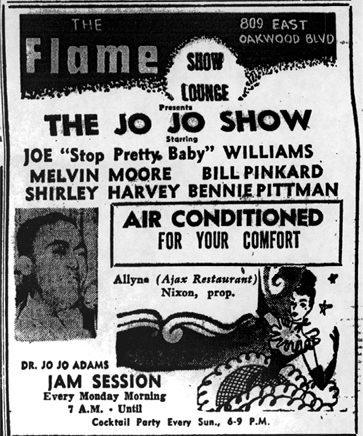
This Parrot session from September turned out to be Adams' very last. Four tracks were laid down, one of which was apparently rejected. The two chosen for release, "Call My Baby" b/w "Rebecca," were midtempo jump blues, both in the same key. Jo Jo's vocal style is somewhat lacking in passion, but there is more than adequate compensation in the daring instrumental backing. This was provided by an uncredited Red Saunders unit, playing equally uncredited and extremely unconventional arrangments. These are obviously the work of a cat who, as Sonny Blount, had been associated with the Club DeLisa since 1946; he had just recently changed his name to Sun Ra when this session was made, and was around 18 months away from launching his Arkestra.
After this session, Jo Jo Adams continued to emcee at the Flame Lounge for most of the next three years, surviving a couple of ownership changes (we know his birthday because the Flame threw a party for him on August 18, 1955). His nearly continuous run was spelled by two appearances at Budland and a couple of stretches at the Club DeLisa.
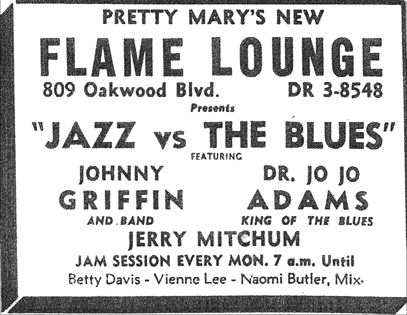
The last incarnation of the Flame Lounge closed its doors around the end of 1956. Jo Jo Adams next took up the MC role at Budland, where he was in residence most of the time from June 1957 through April or May 1959. His last run as MC was at the Green Door, for several months in 1959. As the floor shows died out and rock and roll and soul music made his blues sound increasingly dated, Adams continued on the scene but found work increasingly difficult to get. Jo Jo Adams died on February 27, 1988. Dick Shurman, who saw him shortly before he died and made a futile attempt to interview him, described him as "a true casualty of the streets."
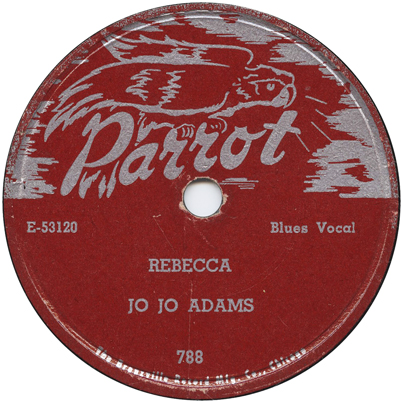


Born Joseph Goreed in Cordele, Georgia (on December 12, 1918), ballad and blues singer Joe Williams was an established local attraction in Chicago by the time he recorded for Benson. After years of serious dues paying and a couple of very obscure reacordings for tiny labels, he had become a headliner at the Club De Lisa, cutting a number of sides for Columbia and OKeh with the Red Saunders band (1950-1953). He had also made a 1952 session with King Kolax that Benson sold to Checker Records.
For his September 28 session, Joe was once again backed by a Red Saunders ensemble (and as was customary Benson gave Red no credit on the label). We believe that two sides were originally given the matrix numbers 53125 and 53126, and were done not long after the Jo Jo Adams session—which also included a Red Saunders ensemble. According to Bob Porter, a tape box among the holdings of Savoy Records included "It's Raining Again" and "Always on the Blue Side" and bore the date September 28, 1953 on the outside. The Chess tape list actually puts Joe Williams tracks in the same tape box as the four numbers by the Pelicans (the box number is 2059), but by 1958 or 1959 the Williams numbers had been removed. The other four titles by Wiliams and Saunders use the same ensemble, and sound similar, but there is a good chance they were actually cut at the December 31 session, along with instrumentals by the band.
Arrangements for the Joe Williams numbers were again provided by Sun Ra. We have a well-founded suspicion that the Joe Williams numbers with no composer listed—"It's Raining Again" and "Always on the Blue Side"—were actually composed by The Ra as well.
Joe Williams got his big break around Christmas 1954, when he left Chicago to join the Count Basie Orchestra. His second rendition of "Every Day I Have the Blues" (Clef 89149) became a Top 10 R&B hit when it was released in June 1955 (see the Clef ad in Cash Box, June 11, 1955, p. 24). With his record hitting on Clef, other companies were hoping to sell some Joe Williams sides. Chess/Checker re-advertised his 1952 version with King Kolax, and pulled in some further sales on it. And Herman Lubinsky of Savoy made Al Benson an offer for two Joe Williams sides. "Time for Moving" (retitled from Blue Lake 1002) and "Blow Mr. Low" (previously unissued) were released on Savoy 1165. It was pushed out in some haste at the end of July 1955 (see the review in Cash Box, August 6, 1955, p. 28; the company ad was on p. 24 of the same issue). We'd not known previously that the Savoy single came out while Parrot and Blue Lake were still active. "Time for" and "Mr. Low" would appear again on a Regent LP with all of the sides Williams had cut for Al Benson (with King Kolax for Checker and Red Saunders for Blue Lake), but so far as we know the other Blue Lake sides were sold to Savoy in 1956.
Joe Williams continued to perform and record extensively until shortly before his death, in Las Vegas on March 29, 1999.

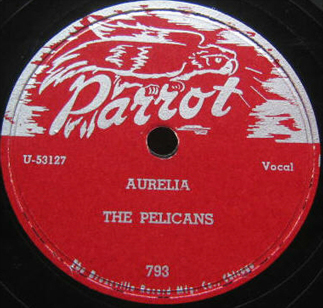
A vocal group called the Pelicans recorded the same day as Joe Williams and Red Saunders. They were the first doowop ensemble to record for Benson since he launched Parrot as an independent operation. The Pelicans were led by Roger Heard and came from Detroit. Of their four sides recorded on September 28, 1953, two found release at the time: "Aurelia" and "White Cliffs of Dover." "Aurelia" is a deep sounding ballad and it got a few plays in Chicago, Detroit, and New York. There was a real person behind the song, Aurelia Brown. Heard was dating her and put his romantic inclinations into the ballad. His efforts bore fruit because they eventually got married. Regarding "White Cliffs of Dover," the Pelicans became one of the earliest groups during the 1950s to turn this World War II pop icon into an R&B tune. The group's deep vocal stylings to a bongo-driven Latin beat were a pioneering effort at R&B reconstitution—or is that destruction?—of standards.
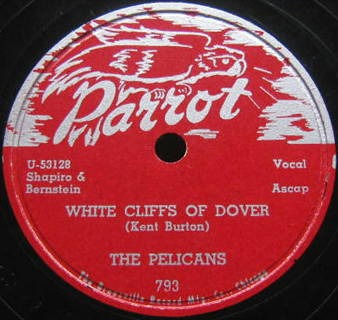
The Pelicans were not accompanied by the Red Saunders unit that one might expect. "White Cliffs of Dover" uses just a rhythm section, with the guitarist getting the most attention. On "Aurelia," however, a tenor saxophonist who owes a lot to Coleman Hawkins accompanies Heard's pleading vocal and takes a brief solo. This is Paul Bascomb, making his debut on Parrot. Bascomb and his rhythm section weren't entirely in their comfort zone backing this vocal group—the balances on the two released sides are awkward—but they would orient themselves soon enough. The other players on the date were Roland Faulkner (guitar), probably Malachi Favors (bass), and Vernel Fournier (drums). Norman Simmons was Bascomb's regular pianist at the time, but we aren't at all sure that he was on this date.
Tenor saxophonist Paul Bascomb was a veteran Swing and R&B tenor player out of the Hawk lineage. Born in Birmingham, Alabama, on February 16, 1910, Bascomb came to the fore in the mid-1930s when he attended Alabama State University and built the Bama State Collegians up into a big band (which later moved to New York City and renamed itself the Erskine Hawkins Orchestra). During the late 1940s, Bascomb led bands based in New York. From 1950 to 1952, he was in residence in Detroit, at a club called El Sino—a locale duly commemorated, though not correctly spelled, in one of his 1955 titles for Parrrot (see below). His excellent Detroit unit recorded in Chicago for States at three different sessions in 1952. In January 1953, Paul Bascomb took up residence in Chicago, buying a house at 4722 South State Street. His initial attempt to join Local 208 in Chicago was rebuffed on January 22, for reasons that seem inexplicable today; an established musician was obliged to take a day job and (in order to avoid angering the Union) to refuse offers from several different clubs. Finally, on June 4, 1953, he was allowed to join the Union local in Chicago (for a cash payment of $50, according to minutes of Local 208 Board meetings now housed in the Chicago Public Library).
Bascomb quickly recruited a band and took a 2-week gig at the Capitol Lounge (contract accepted and filed on June 18). The next month he took a gig at the Strand Show Lounge, 63rd and Cottage Grove (the contract was accepted and filed by the Union on July 16). According to Norman Simmons (in conversations with Art Zimmerman, and in an interview published in Cadence, March 2000), Bascomb really took over an existing band that had been organized by Gus Chappelle (who doubled on trombone and vibes) along George Shearing lines. Under Chappelle's leadership the band had been in residency at the Strand the previous year (Chappelle's first contract with the Strand was accepted and filed by Local 208 on May 15, 1952). When Bascomb became the leader the other musicians were Simmons (piano), Roland Faulkner (electric guitar); Malachi Favors (bass); and Vernel Fournier (drums). There is an extant photo of this band with up and coming baritone saxophonist Pat Patrick replacing Faulkner; Patrick was attending Florida A&M University at the time, so he was only available for a while during the summer.
Paul Bascomb's first studio work since moving to Chicago was an uncredited appearance backing Dinah Washington on a session for Mercury, which took place on August 13, 1953 and produced two sides. Our thanks go to Yves François Smierciak for identifying this as a Bascomb product (the leader takes tenor sax solos on both sides). On the Mercury date, Chapelle was absent and Bascomb's regular band was beefed up with two trumpets and an alto sax. Since a baritone sax was present, and not a guitar, the session was obviously done while Pat Patrick was in the band.
On August 27, 1953, the Strand Show Lounge ran an ad in the Defenderannouncing "Paul Bascomb and His Great Little Band, Beginning Wed., Sept. 9th." A Defender ad from September 24, 1953 has Paul Bascomb's Quintette, plus Bobby Dalton "direct from Zizzy [sic] Johnson's Revue Detroit" playing at the grand opening of the Club Relax (6239 Cottage Grove; Bascomb's contract had been posted on September 17). Bascomb seems to have divided his time between the Strand and Club Relax for a while (indefinite contracts with both establishments were accepted and filed by Local 208 on October 15, 1953). On November 5, Bascomb posted yet another contract with the Strand; he seems to have left Club Relax around this time, being replaced on the gig by pianist King Fleming. According to Bob Bolontz, "Rhythm and Blues Notes," Billboard, November 28, 1953, p. 51, the return engagement at the Strand started November 18.

On October 11, 1953, Benson taped his way through no fewer than 12 gospel tracks, by three different ensembles. Just two sides, by the Victorettes, are known to have been issued; another couple could have slipped out without our knowing it.
The Victorettes, an all-female ensemble, interested Benson enough to be called back for a second session in the summer of 1954. According to gospel expert Bob Marovich, they grew out of a "church choir" called the Victory Singers, founded by Mary Etta McNairy in Chicago in 1948. Directed by Jeannette Sims (possibly McNairy's sister, though this is yet to be confirmed), the choir "appeared in concert and on local Chicago radio shows and began touring other cities in the midwest" (according to McNairy's obituary in the Michigan Chronicle). Sims and McNairy moved to Detroit in 1950 and reorganized the Victory Singers with new members from the Detroit area. The group was renamed the Victorettes; in addition to touring throughout the country, they had a weekly Sunday radio broadcast ("Southland Spirituals") on radio station WJLB. Mary L. Morris, Mary McNairy's grandniece, told Bob Marovich that she was the Victorettes' "mascot" and often sang with the group.
Marovich suggests that Parrot recorded the Victorettes because, although the group was now based in Detroit, its two principal singers (Mary McNairy and Jeannette Sims) were still quite popular in the Chicago black church community and were likely invited back to sing at local programs. In any event, Benson had already begun recording Detroit-based talent two weeks earlier, when he brought in the Pelicans.
The Victorettes' only release, on Parrot 107, is a rare creature today. Having finally heard both sides, we can say that they were one of the best groups working at the time. The Victorettes, who recorded with 5 or 6 singers, were a sweet-voiced ensemble with clean execution; no grit or hard-gospel procedures. One of the leads was a coloratura soprano. On the ensemble number "Jesus Has Promised" her high notes, even a single note on a single word, like "you," take flight about the ensemble. "When Night Comes" is a vehicle for dual leads, which we assume were by McNairy and Sims; both reach high, but the second lead soon reveals herself as the coloratura. They were accompanied by the standard combination of organ and piano.
For information on the other two groups recorded on October 11—the Sunset Four Gospel Singers, and the Oliver Lynch Singers (first name misspelled "Olive" in more than one source)—we will be most appreciative. Hayes and Laughton's Gospel Discography suggests that the Sunset Four were a later edition of a group that had previously recorded as the Sunset Jubilee Singers (for Hub and Duke in 1946, and for OKeh in 1951) but also as the Sunset Four (for Haven in 1946). However, there is no assurance that the quartet that recorded for Benson was a continuation of the same group, as the other Sunset sessions had all taken place in New York.

The Rockettes, who cut one session for Benson, were a doowop quartet who (unusually for that time) employed a female lead on some of their numbers. She can be heard on "Love Nobody"; "I Can't Forget" has a tenor lead. Unfortunately we know nothing more about either of them. The Rockettes were accompanied by a Red Saunders unit with Sonny Cohn (trumpet), Leon Washington (tenor sax), Earl Washington (piano), the same guitarist who was on the Jo Jo Adams session, Jimmy Richardson (bass), and of course the leader (drums). Cohn's highly charged trumpet lead on "Love Nobody" closely resembles his work on the Jo Jo Adams session; on "I Can't Forget" the horns have much less to do and the solo space goes to the guitarist. The list of tapes dealt to Chess assigns the Rockettes tape a file number that places their session in the October 11 marathon (the Sunset Four tape was numbered 2084, the Victorettes 2085, the Rockettes 2086, and the Oliver Lynch Singers brought up the rear with 2087).

Velma Dortch is a mystery woman. Cash Box announced that she was a "singstar" and Al Benson had signed her to Parrot (October 24, 1953, p. 27). But nothing came out under her name. Unless by some off chance she was the female lead of the Rockettes, we figure she didn't get recorded at all.
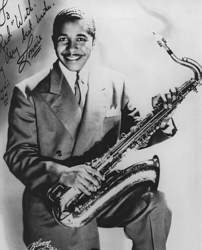
Lonnie Simmons began his musical career as a tenor saxophonist, recording with the Savoy Sultans in New York City. After moving to Chicago in the early 1940s, he was featured more and more often on the organ. In 1949 he led a band at the Beige Room for several months (on July 25, 1949, Down Beat's Chicago Band Briefs column noted that "Lonnie Simmons' band seems to be there permanently"). From 1950 through 1956 he was a nightly attraction at the Club DeLisa. For this November 1953 session, he overdubbed his own Swing tenor sax lines over his organ trio; he seemed rather fond of the simulated vibraphone sound that he could get out of his Hammond B-3. Simmons would record very little afterwards, though he appeared on two pop outings for Mercury behind Jean Swan in 1956 (see our Red Saunders discography for these). Not long after leaving the DeLisa, he acquired a stready gig, which he basically held for the rest of his life, playing organ in an Italian restaurant in Chicago.
Lonnie Simmons recorded four sides at his October 15 session. "I Can't Get Started" and "Black Orchid" were released on a Parrot single. "Lonnie's Blue" (identified on the master list from c. 1959 as "original ballad") appeared on a Chess Vintage Series LP in 1972. What the Chess tape list calls "Love of Mine" (possibly "This Love of Mine," which had been made famous by Frank Sinatra, and was being recorded by a lot of people in 1952 and 1953, including the Chess brothers' house tenor saxophonist Eddie Johnson) remains unissued.
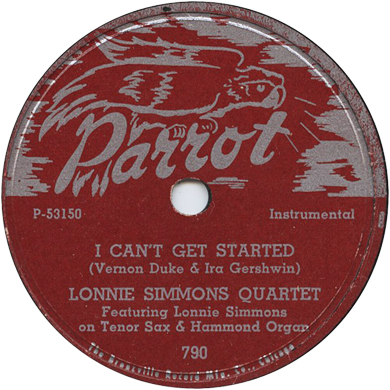


Later in October, Paul Bascomb was back, with his entire Strand Lounge band, for the "Jan" session. Norman Simmons had recently written and arranged a Latin-flavored jazz number piece that he called "Jan." Leonard Allen at States wasn't interested in recording it. Simmons had even written lyrics for the piece, in case a vocal recording would be more attractive to the company. Al Benson, however, did express interest, so Bascomb asked to be let out of his contract with States (which hadn't scheduled a session for Bascomb for over a year—or maybe it was Mercury he addressed the request to?) so he could cut the number for Parrot.
Its place in the matrix series indicates that "Jan" (an instrumental with a rhumba beat that covered both sides of a 78) was cut in October 1953. According to the Chess tape list, the tape box carried file number 2114, putting it a few days after the Lonnie Simmons session, which got box number 2094. Norman Simmons has said that "Jan" was done early in the year, but this doesn't check out, and not just because of the number on the tape box. Paul Bascomb was blocked by Local 208 from working in Chicago until June 4, 1953, and didn't put together his Strand band until July.

For the "Jan" session, we know the complete lineup, thanks to the recollections of Norman Simmons and the late Vernel Fournier: Paul Bascomb (tenor sax), Gus Chappelle (trombone), Norman Simmons (piano), Roland Faulkner (electric guitar), Malachi Favors (bass), and Vernel Fournier (drums) were joined by one "Pepe" on congas (this may be the Peppi Brown who later worked with Malachi Favors in a trio led by pianist Andrew Hill). "Jan" is one of the first recordings that Malachi Favors made, and the first one on which he can be heard to advantage, contributing a mighty ostinato. Benson released "Jan" on Parrot 792, and gave it what, by his standards, was a big push. But in his Cadence interview (March 2000, p. 11), Norman Simmons complained that Al Benson didn't take full advantage of the record's commercial prospects:
Well, the guy who recorded it... he doesn't care what happens to his records. He only presses a certain amount and that's it. ["Jan"] got to be number seven on the charts, but he just stopped pressin' them. But that record established me as an arranger. From then on, I was kind of known for that.
By the way, we have no idea which chart "Jan" reached number 7 on. Shortly after "Jan" was released, Benson told a writer for Cash Box (January 16, 1954, p. 23) that the record had sold 7,000 copies in Chicago —which may or may not have been true, but is hardly the same thing.

The Five Thrills were the most prolifically recorded vocal group on Parrot, for reasons that largely escape us. Most of their "original" tunes were thinly disguised covers of records of the day (for instance, "Rocking at Midnight" rips off "Good Rockin' Tonight" by Roy Brown and Wynonie Harris and "Ride Jimmy Ride" rips off "Mailman Blues" by Lloyd Price) and their other material lacked any sort of distinctiveness. The Five Thrills were Levi Jenkins (bass and piano), Gilbert Warren (lead/tenor), Oscar Robinson (baritone), and brothers Fred Washington (baritone) and Obie Washington (second tenor). Gilbert Warren would improve markedly, but his work on some of October sides wouldn't have gotten him through a cattle call for American Idol; his lead work on the ballad "All I Want" is painfully out of tune. Nonethless, the group got to play some prominent clubs, notably Martin's Corner (1900 West Lake) along with singer Gloria Valdez. Gloria's husband, Paul Bascomb, was responsible for backing them on their Parrot sessions.
The group's first session, which produced 8 sides, was apparently done on a different date, later in October. The instrumental lineup is just Bascomb, an unidentified trumpet player, piano, guitar, bass, and drums. The horns are used sparingly (though Bascomb's tenor sax can be heard on "Ride Jimmy Ride," which was selected for release on Parrot 796, he sits out most of the tracks). We think Vernel Fournier was at the drums and Roland Faulkner on the guitar, but the pianist may not have been Norman Simmons, and the bassist stays in the background.
The Chess tape list from around 1959 indicates that the two parts of "Jan" came from a different tape box from the Five Thrills items. (Oddly, Chess was given a session sheet but not the actual tapes, leading the compiler to give a box number for "Jan," while tagging the Five Thrills items as "not recorded." But of course the tapes by the Thrills did survive after all.) According to the Chess list, the vocal group was initially called the 5 Esquires. Only approximate titles were given, most of which were changed on release: 53153 as "Nothin' but Feeling," 53154 as "Our Love to Be the Same"; 53155 as "Mailman Blues"; 53156 as "Midnight Blues"; 53159 as "My Baby's Gone"; and 53160 as "Heartaches." Paul Bascomb fans would be especially interested in the never-released 53158, titled "Lizar's [sic] Blues" on the Chess list. Donn Fileti's documents indicate that it was an instrumental. In fact, "Liza's Blues" was a number that Paul Bascomb had previously recorded with his Detroit band for States, on August 25, 1952.

Benson continued his activities in the studio during November 1953, but until the session by Albert King at the end of the month, nothing that was recorded saw release. Either the performances or the sonics must have been unsatisfactory; in any event, the only surviving documentation for the next two studio outings is the Chess tape list.
At some point in November, Benson cut four gospel tracks with an artists (or artists) that the Chess list does not identify. (Again Chess apparently just got the list of tracks for a tape that was left out of the batch.) One of the titles may be "God Shall Wipe All Tears Away," which had been recorded for Aristocrat by the Reverend "Singing Sammy" Lewis, back in 1949. Lewis was on the scene; in 1954 he would record for Vee-Jay, and in 1956 he made a stop at United. But his presence here is entirely conjectural; tapes need to be found and auditioned before we can say anything further.
Next, Benson brought in one of his top jazz artists, pianist Ahmad Jamal. Born Frederick Russell Jones in Pittsburgh, on July 2, 1930, he quickly acquired the nickname Fritz. He went as "Freddy" during World War II, when a Germanic name lacked appeal. After converting to Islam, he would drop his birth name entirely (to the extent, at times, of vehemently denying he'd ever been called Fritz Jones).
Having already made a name for himself in Pittsburgh, Fritz Jones arrived in Chicago in 1950; as they would do later to Paul Bascomb, the leadership of Musicians Union Local 208 put him through the wringer before allowing him to contract for gigs locally. Even after he finally obtained clearance from the local, some time went by before he was able to find gigs as a leader. On December 16, 1950, the Defender ran an ad and a photo with caption for bassist Israel Crosby's band appearing at Jack's Back Door (5859 South State). The photo named Fritz Jones on piano and Johnny Thompson on tenor sax. Crosby had filed an indefinite contract for the gig on October 19, 1950. While looking for jobs for his trio, Jones also spent some time playing piano in the Freeman brothers band.
In April 1951, he finally landed an engagement as a leader; his indefinite contract with Jimmy's Palm Garden was accepted and filed by Local 208 on April 19. On this occasion his name was listed as "Frederick" Jones. As Fritz Jones, he posted an indefinite contract with Harry's Show Lounge on June 7; and on July 5 when he filed a new indefinite contract with the same venue. On July 5, the Local 208 Board heard a complaint from bassist Tommy Sewell, who had just been fired from Jones' trio, obviously while it was working at Harry's:
Members Fritz Jones and Thomas Sewell appeared before the Board, as notified, with reference to Sewell's complaint that Jones had no reason for dismissing him from his group. (Board meeting minutes, p. 3)
Sewell was bitter because he had been working with Jones for several years, and took a day job after they arrived in Chicago and were unable to get steady work. He claimed that he had been given notice because Jones' wife didn't like him.
Jones stated he had no personal likes or dislikes for Sewell. He explained that he gave Sewell notice because he refused to cooperate with the style of music that he wanted to play. He stated that Sewell insisted on playing solos on his bass violin in a BeBop way. The last week of his notice he was late on every set, and did everything possible to humiliate and embarrass him. (p. 4)
The Local 208 Board found in Jones' favor. Sewell stayed in Chicago, at least for the next couple of years, but never worked with Jones again.
Eddie Calhoun replaced him—soon, if not immediately. On August 2, 1951, Local 208 accepted and filed Fritz Jones' contract with the 113 Lounge; the management at the 113 was evidently pleased, because on September 20, he filed a new contract for 5 months. Sam Evans' Cash Box column ("Kickin' the Blues Around," September 29, 1951, p. 17) referred to "a trio of young men, with a new and creative approach that is pleasing to the ears of jazz lovers of all ages." The members were Fritz Jones, Ray Crawford, and Eddie Calhoun. During his residency at the 113, Jones signed a recording contract with OKeh's newly revived Chicago operation. On October 25, still going as Fritz Jones, he recorded 4 sides with Ray Crawford on guitar and Eddie Calhoun on bass.
On January 17, 1952, Fritz Jones posted a contract for 4 weeks with options at the Blue Note. But just over a month later, he and his wife filed a name change petition with a Cook County court, which stated:
That the place of nativity of Frederick Russell Jones is the state of Pennsylvania and that the place of nativity of Virginia Wilkins Jones is the state of Illinois. That the age of F. R. J. is 21 years and that the age of V. W. J. is 25 years. That F. R. J. has resided in the state of Illinois for 2 years and that V. W. J. has resided in the State of Illinois for 25 years last past... Their names may be changed to Ahmad Jamal and Maryam Mezzan Jamal... Witnessed by Eddie A. Calhoun, February 18, 1952.
The petition, which nails down a significant event in Jamal's life, was unearthed by Alexia Kinni, a graduate student at Rutgers-Newark under the supervision of Lewis Porter.
On April 17 Ahmad Jamal filed his first contract under his new name (for 2 weeks at the Pershing Lounge, a venue he would eventually make famous, and vice versa; he would post an extension for 4 more weeks on May 1). Meanwhile, pre-release advertisements and record sleeves from OKeh had been referring to the "Fritz Jones Trio." But when the first release from the October session, OKeh 6855, came out in March or April 1952 his new name was on it. On May 5, Ahmad Jamal made a second four-tune session for OKeh with the same trio.
Ahmad Jamal filed another, indefinite, contract with the Pershing Lounge on January 22, 1953, as his OKeh deal was about to run out. In September 1953, the Jamal trio was back at the Pershing Lounge after a short engagement in New York City (Ted Watson, "Chicago Night Life Gets Lift from Name Artists," Pittsburgh Courier, September 12, 1953, p. 19; Watson, writing in Pittsburgh, was still referring to Jamal as Fritz Jones).
OKeh had thrown in the towel on its Chicago operations, and like Red Saunders, another ex-OKeh artist, Jamal moved over to Parrot. Benson obviously expected a lot out of the pianist, who cut 6 titles for him in November 1953, we assume with his working trio. The tapes were still extant in 1958 or 1959, because the Chess list includes a file number for this session, but something must not have gone right. Jamal would return in January 1954 for another session, at which his trio remade "But Not for Me" and "Excerpts from the Blues." The November 1953 session was unknown to discography until the Chess tape list resurfaced.

After concentrating on jazz, vocal groups, and gospel for a time, Benson turned his attention back toward the blues in November.
From our point of view today, the biggest name among the Parrot bluesmen is Albert King. The guitarist and singer was born in Indianola, Mississippi, where he may or may not have been related to B. B. King, on April 25, 1923. But he was an unknown when he made these sides—the very first under his own name—on November 30. King was backed by rhythm guitarist John Brim, pianist Johnny Jones, and unidentified bass and drums. Dick Shurman astutely noted that the tracks "demonstrate that while Albert's relatively unadorned vocal style and acidic guitar tone were fairly well defined, he hadn't yet developed much dynamics or distinctiveness in his songs." While King sings "Little Boy Blue" with assurance, he was not going to become a star performing a song that Robert Johnson played but never recorded. King failed to break in on the Chicago scene with these sides and worked in Arkansas for a time before moving his base of operations to St. Louis, where he would make his next recordings as a leader for Bobbin in 1958. Albert King found his niche in the 1960s when he signed with Stax Records, where he became one of the giants in the blues field. King died in 1992.

Another artist who needs no introduction here is Mr. Five by Five, Jimmy Rushing, born in Oklahoma City on August 26, 1903 (though some sources have said 1902). Rushing first recorded in 1929 with Walter Page's Blue Devils; he attained nationwide prominence beginning in 1936 with the Count Basie band. Rushing had been leading a 7-piece jazz group at the Savoy Ballroom in New York City, but it broke up in 1952, and his Parrot recordings were cut with the Frank Culley combo. "Floorshow" Culley—his handle was "Cole Slaw" Culley before he cut "Floorshow" for Atlantic in 1949—was an alto and tenor honkologist active on the R&B circuit. On the Parrot single, Rushing sings his signature number, "Mr. 5 X 5," and shouts a slow blues with rather gimmicky stop-time vocal breaks, "Clothes Pin Blues." (The unaccompanied stop-time vocal lines might sound more persuasive without the heavy reverb that was added to so many recordings in those days.). The main instrumental soloist on both sides is Frank Culley on tenor sax; trumpet, piano, guitar, bass, and drums complete the lineup. Jimmy Rushing recorded regularly up to his death in New York City on June 8, 1972.
The Jimmy Rushing sides are claimed by Leadbitter, Fancourt, and Pelletier 1994 to have been made in Chicago. But Culley's home base was New York City, and Rushing's other recordings during the period were all made in New York. We got the original matrix numbers, which confirm the New York origin, from a copy in the collection of Richard Reicheg. (The matrix numbers that discographies give for this session were attached by Chess at some point in the early 1960s, when the Chess brothers were thinking about reissuing the tapes.) Further confirmation of a New York session on December 27, 1953 comes from the "Stars over Harlem" column in Cash Box (January 9, 1954, p. 21):
Chicago Al Benson whizzed in quick and quiet like and spent two days recording and making the rounds with disc jockey-writer Joel Turnero who previewed a whole stack of new Parrot waxings via WNJR.
According to the columnist, who accurately gave artists and at least one title for each, Benson brought copies of Parrot 791, 792, 793, 794, and 796 to WNJR. Two or three of three were pre-release pressings.
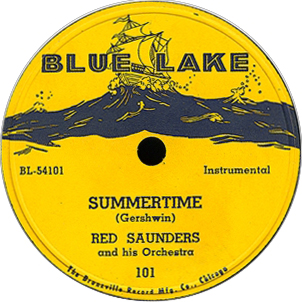
The final session of the year produced the first single to come out on Al Benson's new Blue Lake label. It featured the Red Saunders band playing what, for it, were aggressively modernistic treatments of "Summertime" (redone to a Latin beat) and "Riverboat." Sun Ra was once again responsible for the arrangements.
Three instrumentals are known from this session: "Sumertime" and "Riverboat" were released on Blue Lake 101, while "Lawdy Miss Lucy" was held back and did not appear on record until 1972, when it was used on a Chess Vintage Series LP.
Were any vocal features for Joe Williams included? Because all 6 Joe Williams sides in the company vaults were sold to Savoy in 1956 there is no way to know what their original matrix numbers were. We are inclined to think that at least two of the Williams tracks were actually done at the December 31 session. Meanwhile, only two out of the six came from a tape box with September 28 on it (or so Bob Porter notes his liner notes to a Savoy reissue LP). The December 31 session seems to have occupied a 6-item stretch in the 53100 matrix series, from 53179 through 53184, so more than two of the Williams items could have been done then (with a somewhat smaller ensemble than was used on the instrumentals).
When most of the remaining master tapes were leased to Chess in 1959, "Summertime" and "Riverboat" were in tape box 2453, along with "You Ought to Quit It" and "Lovin [sic] Daddy Blues" by Ann Carter. But the notation on the list attributed the vocal items to Joe Williams! That strongly suggests that some Williams items were once in the box. What's more, the box number is too high for the December 31 date, which would yield a tape box number around 2250. We suspect that the instrumentals were put in with the two Ann Carter items, themselves recorded in February 1954, after the Joe Williams tapes were sold.
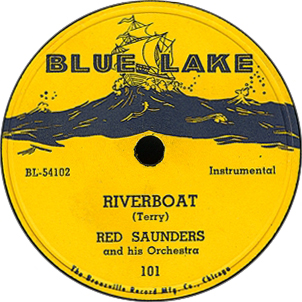
A source of some trouble for us is a session by the gospel group, the Willie Webb Singers. Four sides were issued with Parrot matrix numbers, but these are not from the main Parrot matrix series, and the session cannnot be found on either the Chess tape list or the among the tapes that were sold to Relic Records. The Webb singles are poorly documented in general. Willie Webb was important enough, however, to be covered in Horace Clarence Boyer's book How Sweet the Sound: The Golden Age of Gospel.
Willie Webb was born in Mississippi in 1919. He moved to Chicago at a young age and in the mid-1930s became a charter member of the Roberta Martin Singers. Webb was a virtuoso pianist and organist. In 1949, he formed a mixed group called the Willie Webb Singers, in which he did not usually feature himself as a lead vocalist.
In 1950, Webb was the choir director of the 44th Street Baptist Church. We know because on October 19 of that year he filed a claim with the Board of Local 208 against the minister, the Reverend Elijah Thurston, and Sylvia Hoston, a member of Local 208 who presumably played piano or organ there.
Webb and his group made their first records for Gotham, with four sides recorded in September 1950; a follow-up in March 1951 yielded another release on the same label. Because they were issued with green Parrot labels and most of Al Benson's gospel activity took place in 1953, this is the best guess we can make about the date of Willie Webb's sides for the company.
On Parrot 105, "Climbing High Mountains" and "God Is Good to Me" feature a powerhouse contralto lead, joined by a second strong contralto on "God Is Good"; unfortunately, she is not credited on the label. Accompaniment is by a small female gospel choir, with Webb at the organ plus a pianist. On 106, we hear Willie Webb singing the tenor lead on "He's a Wonder"; presumably still taking care of the organ playing, with the same accompaniment. On "He Will Be There" Webb hands off the lead vocal to the same excellent contralto. The Parrot sides make a case for the Willie Webb as one of the top gospel ensembles in a city that had so many good ones.
After these two Parrot releases, the Willie Webb Singers unfortunately did not record again till 1959, when they taped 6 never-released sides for Chess. Webb was still known to Chicago churchgoers during that period, as is shown by his appearance in a supporting role at a Mother's Day gospel extravaganza. His last known release was a single on Bud Brandom's B&F label, which came out in 1961. Willie Webb died in Chicago on May 15, 1999.
| Matrix | Artist | Title | Issue | Recording Date | Release Date |
| U-2550 | Mable [sic] Scott | Mr. Fine | Parrot 780 | May 1953 mastered June 10, 1953 |
July 1953 |
| U-2551 | Mable [sic] Scott | Mable's Blues | Parrot 780 | May 1953 mastered June 10, 1953 |
July 1953 |
| U-53173 | Mable [sic] Scott | Fool Burro | Parrot 794 | May 1953 | December 1953 |
| U-53174 | Mable [sic] Scott | Do the Thing | Parrot 794 | May 1953 | December 1953 |
| U-2552 | Chocolateers | Bartender Blues | Parrot 781 | May 1953 mastered June 10, 1953 |
July 1953 |
| U-2553 | Chocolateers | Peckin' | Parrot 781 | May 1953 mastered June 10, 1953 |
July 1953 |
| Chocolateers | Waitin' for Jane | unissued | May 1953 | ||
| Chocolateers | Little Willie | unissued | May 1953 | ||
| U25?? | L. C. McKinley | Rosalie Blues | (Delta Swing LP 379) | May 19, 1953 mastered June 10, 1953 |
|
| U25?? | L. C. McKinley | All Alone Blues | (Relic LP 8025, Relic CD 7016) | May 19, 1953 mastered June 10, 1953 |
|
| U25?? | L. C. McKinley | Pain in My Heart | (Delta Swing LP 379) | May 19, 1953 mastered June 10, 1953 |
|
| U-2570 | Curtis Jones | Wrong Blues | Parrot 782 | May 19, 1953 mastered June 10, 1953 |
August 1953 |
| U-2571 | Curtis Jones | Cool Playing Blues | Parrot 782 | May 19, 1953 mastered June 10, 1953 |
August 1953 |
| P-100 | Bessie Griffen [sic] | Story of Job | Parrot 1000 | 1953 | August 1953 |
| P-101 | Bessie Griffen | What Jesus Means to Me | Parrot 1000 | 1953 | August 1953 |
| P-103A | Al Benson with the Leon Abbey Trio | If You Were the Only Girl | Parrot 6000 | 1953 | 1953 |
| P-103B | The Leon Abbey Trio | Directed by Al Benson | Abbey's Boogie | Parrot 6000 | 1953 | 1953 |
| P-104A | Al Benson with the Leon Abbey Trio | Fool That I Am Part I | Parrot 7000 | 1953 | 1953 |
| P-104B | Al Benson with the Leon Abbey Trio | Fool That I Am Part II | Parrot 7000 | 1953 | 1953 |
| 53-100 tk. 2 | Curtis Jones | Louise | unissued | August 10, 1953 | |
| 53-101 tk. 4 | Curtis Jones | Boogie Blues | unissued | August 10, 1953 | |
| 53-102 tk. 4 | Curtis Jones | Upside Down Blues | (Delta Swing LP 379) | August 10, 1953 | |
| 53-103 tk. 6 | Curtis Jones | Flaming Blues | (Delta Swing LP 379) | August 10, 1953 | |
| 53-104 tk. 2 | Nature Boy Brown | I'm Wise | (Relic LP 8025, Relic CD 7016) | August 10, 1953 | |
| 53-105 tk. 4 | Nature Boy Brown | Look Out | (Relic LP 8025, Relic CD 7016) | August 10, 1953 | |
| 53-106 tk. 4 | Nature Boy Brown | Blue Blues Boogie | (Relic LP 8025, Relic CD 7016) | August 10, 1953 | |
| P 53107 | Leo Parker | Smoke Gets in Your Eyes | (Chess CHV 413) | August 10, 1953 | |
| P 53107 [alt.] | Leo Parker | Smoke Gets in Your Eyes [overdubbed version] |
(Chess CHV 413) | August 10, 1953 | |
| P 53108 | Leo Parker | Anything Can Happen | (Chess CHV 413) | August 10, 1953 | |
| P 53109 | Leo Parker | Tippin' Lightly | (Chess CHV 413) | August 10, 1953 | |
| P 53110 | Leo Parker | Blue Sails | (Chess CHV 413) | August 10, 1953 | |
| P-53111[7002] | Coleman Hawkins and Orchestra | I'll See You Later | Parrot 783 | August 1953 | c. September 1953 |
| P-53112[7003] | Coleman Hawkins and Orchestra | Vocal Chorus | What a Difference a Day Made | Parrot 783 | August 1953 | c. September 1953 |
| P-53113[7001] | Coleman Hawkins and Orchestra | I'll Follow My Sacred [sic!] Heart | Parrot 784 | August 1953 | c. October 1953 |
| P-53114 | Coleman Hawkins and Orchestra | Blue Blue Days (Goin' Down Home) | Parrot 784 | August 1953 | c. October 1953 |
| ? | Coleman Hawkins and his Orchestra | On My Way | (Savoy MG 12013) | August 1953 | |
| [7000?] | Coleman Hawkins and his Orchestra | Last Stop (Blues) | (Savoy MG 12013) | August 1953 | |
| [6994] | Coleman Hawkins and his Orchestra | Flight Eleven | (Savoy MG 12013) | August 1953 | |
| [6995] | Coleman Hawkins and his Orchestra | Modern Fantasy | (Savoy MG 12013) | August 1953 | |
| [6996] | Coleman Hawkins and his Orchestra | Confessin' | (Savoy MG 12013) | August 1953 | |
| [6997] | Coleman Hawkins and his Orchestra | September Song | (Savoy MG 12013) | August 1953 | |
| [6998] | Coleman Hawkins and his Orchestra | They Can't Take That Away from Me | (Savoy MG 12013) | August 1953 | |
| [6999] | Coleman Hawkins and his Orchestra | Should I? | (Savoy MG 12013) | prob. August 1953 | |
| P 53115 | Crume Brothers | Two Wings (Give Me Wings) | unissued | c. September 1953 | |
| P 53116 | Crume Brothers (no artist listed) |
How I Got Over (gospel number) |
unissued | c. September 1953 | |
| P 53117 | Jo Jo Adams (no artist) |
It's Been So Long (jump blues) |
unissued | c. September 1953 | |
| P 53118 | Jo Jo Adams (no artist) |
Corrine (no title) |
rejected | September 1953 | |
| E-53119 | Jo Jo Adams | Call My Baby | Parrot 788 | September 1953 | November 1953 |
| E-53120 | Jo Jo Adams | Rebecca | Parrot 788 | September 1953 | November 1953 |
| P 53121 | Crume Brothers | You Better Run | unissued | September 1953 | |
| P 53122 | Crume Brothers | Pray (no title) |
unissued | September 1953 | |
| P 53123 | Crume Brothers | Fare Thee Well | unissued | September 1953 | |
| P 53124 (P 53121) |
Crume Brothers | Sending Up the Prayer (Sending Up My Prayers) |
unissued | September 1953 | |
| P 53125 [?] | Joe Williams | It's Raining Again | (Regent 6002) | September 28, 1953 | |
| P 53126 [?] | Joe Williams | Always on the Blue Side | (Regent 6002) | September 28, 1953 | |
| U-53127 | The Pelicans | Aurelia | Parrot 793 | September 28, 1953 | January 1954 |
| U-53128 | The Pelicans | White Cliffs of Dover | Parrot 793 | September 28, 1953 | January 1954 |
| P 53129 | The Pelicans | Make You | (Parrot LP 2120 [boot]) | September 28, 1953 | |
| P 53130 | The Pelicans | Let Me Tell You | (Parrot LP 2120 [boot]) | September 28, 1953 | |
| U 53131 | Sunset Four Gospel Singers | My Name Is Written There | unissued | October 11, 1953 | |
| U 53132 | Sunset Four Gospel Singers | Glory, Glory, Hallelujah | unissued | October 11, 1953 | |
| U 53133 | Sunset Four Gospel Singers | Where Shall I Go | unissued | October 11, 1953 | |
| U 53134 | Sunset Four Gospel Singers | Jesus in the Battle | unissued | October 11, 1953 | |
| E-53135 | The Rockettes | Love Nobody | Parrot 789 | October 11, 1953 | November 1953 |
| E-53136 | The Rockettes | I Can't Forget | Parrot 789 | October 11, 1953 | November 1953 |
| E 53137 | The Rockettes ("female solo") |
Boogie Woogie Blues | unissued | October 11, 1953 | |
| E 53138 | The Rockettes (no identification) |
Blues for My Baby | unissued | October 11, 1953 | |
| E 53139 tk. 1 | Oliver Lynch Singers | Roll Your Burdens Away | unissued | October 11, 1953 | |
| E 53140 tk. 5 | Oliver Lynch Singers | Come in the Room | unissued | October 11, 1953 | |
| E 53141 tk. 2 | Oliver Lynch Singers | I'm Gonna Make Heaven My Home | unissued | October 11, 1953 | |
| E 53142 tk. 1 | Oliver Lynch Singers | Got His Eyes on You | unissued | October 11, 1953 | |
| E-53143 tk. 2 | The Victorettes | Jesus Has Promised | Parrot 107 | October 11, 1953 | ? |
| E-53144 tk. 1 | The Victorettes | When Night Comes | Parrot 107 | October 11, 1953 | ? |
| E 53-145 tk. 2 | The Victorettes | I'll Live On and On | unissued | October 11, 1953 | |
| E 53-146 tk. 2 | The Victorettes | Higher Ground | unissued | October 11, 1953 | |
| P 53147 | Lonnie Simmons Quartet | Love of Mine | unissued | October 15, 1953 | |
| P 53148 | Lonnie Simmons Quartet | Lonnie's Blue (original ballad) |
(Chess CHV 415) | October 15, 1953 | |
| P-53149 | Lonnie Simmons Quartet | Featuring Lonnie Simmons on Tenor Sax & Hammond Organ | Black Orchid | Parrot 790 | October 15, 1953 | November 1953 |
| P-53150 | Lonnie Simmons Quartet | Featuring Lonnie Simmons on Tenor Sax & Hammond Organ | I Can't Get Started | Parrot 790 | October 15, 1953 | November 1953 |
| U-53151 | Paul Bascomb and his Orchestra | Jan (Part I) | Parrot 792 | October 1953 | December 1953 |
| U-53152 | Paul Bascomb and his Orchestra | Jan (Part II) | Parrot 792 | October 1953 | December 1953 |
| U 53153 | The Five Thrills | My Saddest Hour | unissued | October 1953 | |
| U 53154 | The Five Thrills | All I Want | (Relic LP 5087) | October 1953 | |
| U 53155 | The Five Thrills | Ride Jimmy Ride | (Relic LP 5087) | October 1953 | |
| U 53156 | The Five Thrills | Rockin' at Midnight | (Relic LP 8020) | October 1953 | |
| U-53157 | Five Thrills | Feel So Good | Parrot 796 | October 1953 | January 1954 |
| U 53158 [on tape box] | Paul Bascomb | Liza's Blues (instrumental) | unissued | October 1953 | |
| U-53159 | Five Thrills | My Baby's Gone | Parrot 796 | October 1953 | January 1954 |
| U 53160 | The Five Thrills | So Long Young Girl | (Relic LP 5087) | October 1953 | |
| U 53161 | unidentified gospel artist | God Shall Wipe Away Tears | unissued | November 1953 | |
| U 53162 | unidentified gospel artist | I Love the Name Jesus | unissued | November 1953 | |
| U 53163 | unidentified gospel artist | Power in the Blood | unissued | November 1953 | |
| U 53164 | unidentified gospel artist | Pass Me Not | unissued | November 1953 | |
| U 53165 | Ahmad Jamal | But Not for Me | unissued | November 1953 | |
| U 53166 | Ahmad Jamal | Excerpts from the Blues | unissued | November 1953 | |
| U 53167 | Ahmad Jamal | It Ain't Necessarily So | unissued | November 1953 | |
| U 53168 | Ahmad Jamal | Beat Out One | unissued | November 1953 | |
| U 53169 | Ahmad Jamal | I Don't Want to Be Kissed | unissued | November 1953 | |
| U 53170 | Ahmad Jamal | Alphabet Song | unissued | November 1953 | |
| U 53171-53172 | See | Purchased | Sessions | ||
| U 53173-53174 | See | U2550-2551 | Above | ||
| U 53175 | Albert King | Little Boy Blue | (Relic LP 8024) | November 30, 1953 | |
| U 53175 tk. 2 | Albert King | Little Boy Blue [alt.] | (Relic CD 7015) | November 30, 1953 | |
| U 53176 | Albert King | Hand Me Down Blues (Poor Man Blues) | (Relic CD 5013) | November 30, 1953 | |
| U 53176 tk. 2 | Albert King | Hand Me Down Blues [alt.] | (Relic CD 7015) | November 30, 1953 | |
| U 53177 53178 on some labels and Chess list |
Albert King | Be on Your Merry Way | Parrot 798 | November 30, 1953 | March 1954 |
| U 53178 53177 on some labels and Chess list |
Albert King | Bad Luck Blues | Parrot 798 | November 30, 1953 | March 1954 |
| ? | Albert King | Murder | (Chess LP 1538) | November 30, 1953 | |
| PNY100 [10616] |
Jimmy Rushing with Frank Culley Combo | Mr. 5 x 5 | Parrot 797 | December 27, 1953 [New York City] |
March or April 1954 |
| [10617] | Jimmy Rushing with Frank Culley Combo | Lonesome Daddy Blues | (Chess CHV 412) | December 27, 1953 [New York City] |
|
| PNY101 [10618] |
Jimmy Rushing with Frank Culley Combo | Clothes Pin Blues | Parrot 797 | December 27, 1953 [New York City] |
March or April 1954 |
| [10619] | Jimmy Rushing with Frank Culley Combo | Wiggin' Blues | (Chess CHV 412) | December 27, 1953 [New York City] |
|
| 54-101 (BL-54101) [53179?] |
Red Saunders and his Orchestra | Summertime | Blue Lake 101 | December 31, 1953 | February 1954 |
| 54-102 (BL-54102) [53180?] |
Red Saunders and his Orchestra | Riverboat | Blue Lake 101 | December 31, 1953 | February 1954 |
| 53181[?] | Red Saunders and his Orchestra | Lawdy, Lucy | (Chess CHV 413) | December 31, 1953 | |
| 53182 [?] | Joe Williams | Detour Ahead | (Regent 6002) | September 28 or December 31, 1953 | |
| 53183 [?] | Joe Williams | Blow Mr. Low | Savoy 1165-A | September 28 or December 31, 1953 | July 1955 |
| BL-54103 53184 [?] |
Joe Williams | In the Evening | Blue Lake 102 | September 28 or December 31, 1953 | February 1954 |
| BL-54104 | Joe Williams | Tired of Moving Time for Moving* |
Blue Lake 102 Savoy 1165-B |
September 28 or December 31, 1953 | February 1954 July 1955 |
| U-750 | The Willie Webb Singers | Climbing High Mountains | Parrot 105 | prob. 1953 | prob. 1953 |
| U-751 | The Willie Webb Singers | God Is Good to Me | Parrot 105 | prob. 1953 | prob. 1953 |
| U-753 | The Willie Webb Singers | He Will Be There | Parrot 106 | prob. 1953 | prob. 1953 |
| U-754 | Willie Webb Vocal | He's a Wonder | Parrot 106 | prob. 1953 | prob. 1953 |

During his first year of operation, Al Benson did not content himself with recording new material. He struck a deal with Jack Lauderdale, the owner of the Los Angeles-based Swing Time label. We'd thought that what Lauderdale was after was more on-air promotion of his records in Chicago, and better distribution there. There was more to it. Cash Box noted on August 15, 1953, that "Jack Lauderdale, prexy of Swingtime Records, has opened a branch office here in Chicago. He's staying on here to get the new office going in full swing. Jack intends to makes this main headquarters. "Because," he claims, "I believe that the center of the Rhythm & Blues market will shift from the West Coast to Chciago in the very near future." (p. 19). The first Parrot release from Swing Time, Parrot 785, was advertised in Cash Box on September 26, 1953 (p. 24). Then Sy House, who for the past two years had been selling records for King in the Chicago market, announced he was leaving King to become the "National Salesmanager for both the Parrot Record Company and Swingtime Records" ("Sy House to Parrott [sic] & Swingtime," Cash Box, October 3, 1955, p. 17). And House would be based in Chicago. Cash Box for October 24 and October 31 covered his extensive sales trips.
The Swing Time deal encompassed a single by guitar-playing bluesman Lowell Fulson, who had been mainstay of the Swing Time operation since the label was created in 1949. Also included were a single by bluesman Alex "Playboy" Thomas, and two by R&B singerMarvin Phillips. The single by bluesman Ernest Lewis (known on some of his other recordings as West Texas Slim) also came from Swing Time. In all 10 sides were included
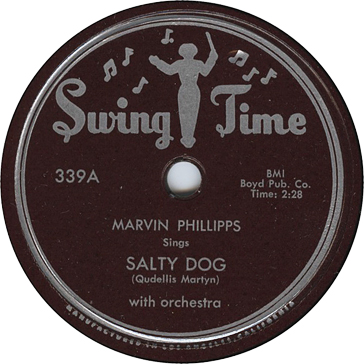
As always, Benson's matrix numbering practices were inconsistent. Two of the Marvin Phillips tracks ("Anne Marie" and "Honey Baby"—which Swing Time hadn't issued) were inserted into the 53100 series at 53171 and 53172. The Chess tape list put "Salty Dog" at 53173 and "Sweetheart Darling" at 53174. But Benson didn't show these numbers on the Parrot release, and they ended up being used for two Mabel Scott sides instead. (How tracks that were the property of another company were available for Chess and later Relic to acquire is an interesting question, but we won't try to answer it here!)
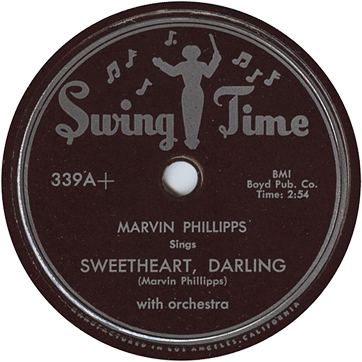

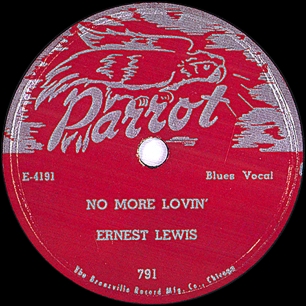
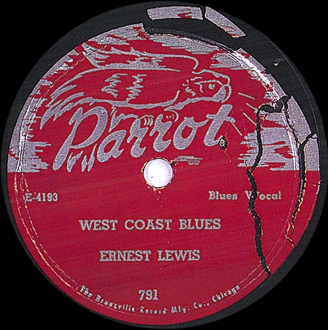
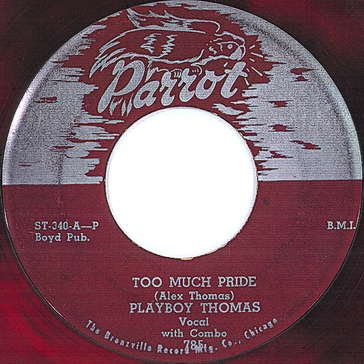
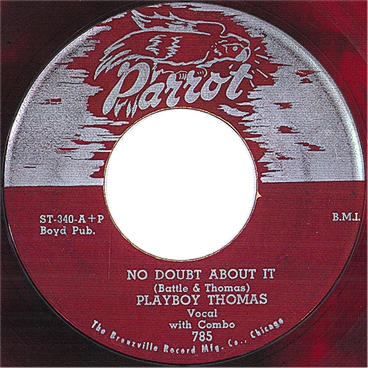
Benson released all of the 10 sides that are known to have been included in the Swing Time deal. The first batch of singles (Parrot 785 through 787) came out in September 1953. Sy House, the newly hired national sales manager for Parrot, visited distributors in the Northeast during October, talking up Parrot 785 in particular ("Sy House, Parrot, on Distrib. Tour," Cash Box, October 24, 1953, p. 14).
Parrot 791 followed in November (our thanks to Alex Podlecki for pointing us to a Billboard listing of 791 as a new release, November 21, 1953, p. 50). Parrot 795 would be the last, in January 1954. The deal appears to have been in force for five or six months.
Swing Time was in decline, when Lauderdale contemplating a permanent move to Chicago. His company would issue just 6 more singles after the Playboy Thomas on Swing Time 340, and neither Parrot 791 nor 795 ever appeared on Swing Time at all. The company was defunct by October 1954, when Swing Time artist Lowell Fulson jumped ship to Chess and one of the trade papers (as per that year's Gart volume) reported that Lauderdale had sold a bunch of R&B tracks with Christmas themes to Hollywood Records. Al Benson would not be motivated to license material from other labels in the future.
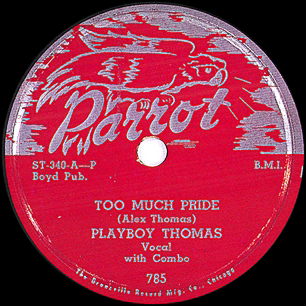

| Matrix | Artist | Title | Issue | Source | Recording Date | Release Date |
| Lowell Fulson and Orchestra | I've Been Mistreated | Parrot 787 | Swing Time 338 | 1952? | c. September 1953 | |
| ST 338 A+ | Lowell Fulson and Orchestra | Juke Box Shuffle | Parrot 787 | Swing Time 338 | 1952? | c. September 1953 |
| U-53171 | Marvin Phillips | Anne Marie | Parrot 795 | Swing Time unissued | 1953 | c. January 1954 |
| U-53172 | Marvin Phillips | Honey Baby | Parrot 795 | Swing Time unissued | 1953 | c. January 1954 |
| ST 339 A-P | Marvin Phillipps [sic] | Vocal with Orchestra | Salty Dog | Parrot 786 | Swing Time 339 | 1953 | c. September 1953 |
| ST 339 A+P | Marvin Phillipps | Vocal with Orchestra | Sweetheart Darling | Parrot 786 | Swing Time 339 | 1953 | c. September 1953 |
| ST-340-A-P | Playboy Thomas | Vocal with Combo | Too Much Pride | Parrot 785 | Swing Time 340 | 1953 | c. September 1953 |
| ST-340-A+P | Playboy Thomas | Vocal with Combo | No Doubt about It | Parrot 785 | Swing Time 340 | 1953 | c. September 1953 |
| E-4191 | Ernest Lewis [West Texas Slim] | No More Lovin' | Parrot 791 | Swing Time unissued | 1953? | November 1953 |
| E-4193 | Ernest Lewis | West Coast Blues | Parrot 791 | Swing Time unissued | 1953? | November 1953 |

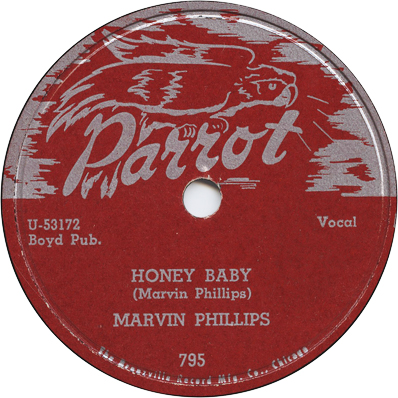
The Blue Lake subsidiary was formed just after New Year's Day, 1954. The first Blue Lake release, 101, was assigned matrix numbers in a new series: 54-101 and 54-102. (Because the session took place on December 31, 1953, the material on Blue Lake 101 appears at the end of the previous list; we think the original matrix numbers were 53179 through 53184. See also above for the material on Blue Lake 102, which was recorded on September 28 of that year, and probably fit into series at 53125 and 53126.) The matrix system got confused at this point, as the Parrot matrices did not switch over to 54xxx but continued the 53100 series. Could Benson have expected Blue Lake to release over 80 sides in 1954? That's what it would have taken for the Blue Lake matrix numbers to catch up with the Parrot matrix numbers.
As it turned out, the Parrot 53100 series was used right up to the session of March 14, 1955, whereupon Parrot suddenly introduced P 55224 on Parrot 814. After Blue Lake 112, which carried the Parrot-style numbers BL-55228 and BL-55229, Blue Lake went over to a BL-55100 series that appeared to pick up where the 54100s left off (matrix numbers from 55129 through 55142 are known). Meanwhile Parrot continued on through the 55200s to 55285.
Al Benson must have been keeping a more watchful eye on his finances in 1954; he recorded just 58 new sides, and got out of the business of leasing from other labels. Nonetheless, he was able to bring some significant new artists into his operation.
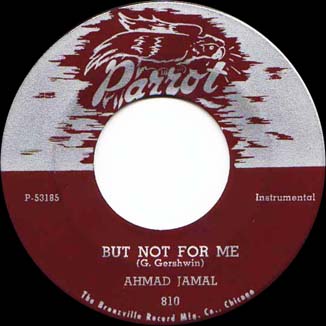
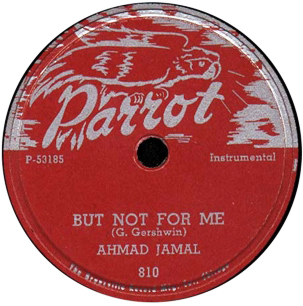
In January 1954, Parrot made its second try with Ahmad Jamal, producing significant jazz results. By this time Jamal's trio was holding forth at the Kitty Kat Club; his contract for 3 weeks with an option was accepted and filed by Local 208 on December 17, 1953; a contract for another 3 weeks was posted on January 7, 1954, and still another would be filed on March 4. Jamal's trio would keep on at the Kitty Kat for much of the year; they were still there in October.
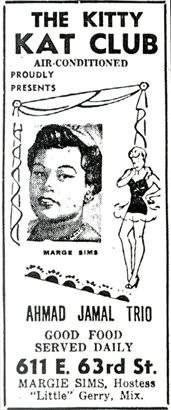
"But Not for Me," "Seleritus" (an original ballad), "Excerpts from the Blues" and "It Could Happen to You" were done with a trio that included Ray Crawford on electric guitar and the celebrated Chicago-born bassist Richard Davis. Jamal's style is recognizable on these numbers—so Sun Ra's later charge that Jamal ripped off his rendition of "But Not for Me" lacks credibility. A fifth item from this session, "Joon's Tune," was never released and is known to us only from the Chess tape list.
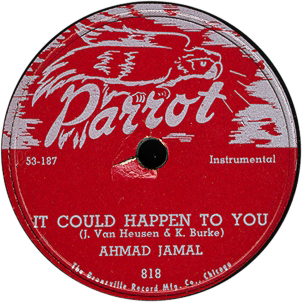

Al Benson was in no great hurry to issue the material: the first single release, on Parrot 810, seems to have appeared in December 1954, and was reviewed in Billboard on January 15, 1955 (p. 56). Yet he sensed enough commercial potential to call the trio back in May 1955 for the only LP to be released on the Parrot label—and again in November of that year for a follow-up session that was never released. Parrot 818 wasn't released till October 1955, by which time Benson was no longer operating an in-house music publisher and Bud Brandom's Frederick Music had taken over some of his artists. The single was mentioned in an advertisement for Parrots 815 through 818, which ran in Cash Box on October 8, 1955 (p. 25). In 1955, while still with Parrot, Jamal recorded an LP for Epic. In 1956, he went with the Chess brothers' new jazz subsidiary Argo. Major commercial success came to Ahmad Jamal in 1958, when his new trio with Israel Crosby on bass and Vernel Fournier on drums made the Live at the PershingLPs for Argo.
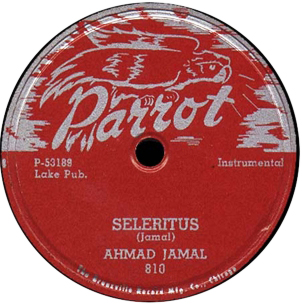

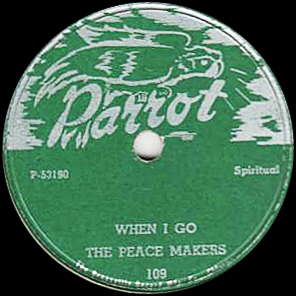
Next came a gospel session by the Peace Makers, of whom we know very little. Two sides were released on the super-rare green-label Parrot 109. Another two were probably recorded, judging from the matrix numbers, but the session was not included in the Chess tape list. We have located a photo of the group, but have no other information about them.


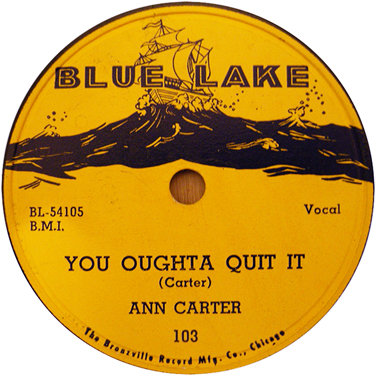
The single by tough R&B vocalist Ann Carter on Blue Lake 103 is another Benson rarity. On "You Oughta Quit It," which has appeared on two unauthorized reissue packages, and "Lovin' Daddy Blues," which has never been reissued, Carter was accompanied by what sounds like a Red Saunders unit with two trumpets and two saxes (alto and tenor). The Carter sides use a different front line from the Joe Williams sides cut on September 28, 1953, or the Williams vocals and Saunders instrumentals cut on December 31.
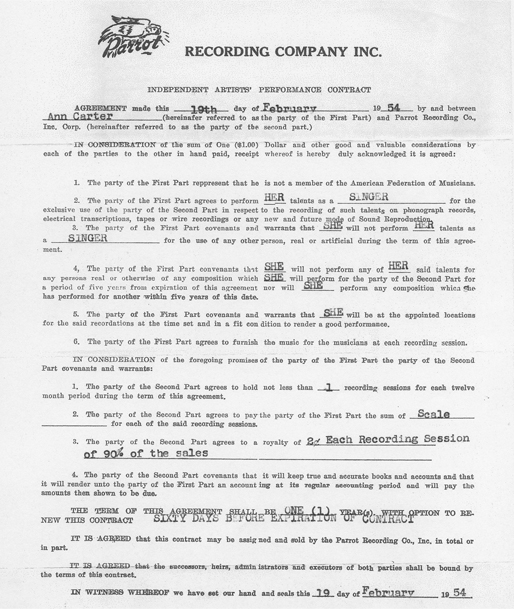
We now know that "You Oughta Quit It" and "Lovin' Daddy Blues" were recorded on February 19, 1954. At least, this is the date on Ann Carter's recording contract with Parrot, as well as her royalty agreement for the two songs she recorded (both of these were generously provided by her daughter, Barbara Berry). The copyright forms for the songs were received by the Library of Congress on February 22, 1954.
The Chess tape list puts the Saunders instrumentals and the Ann Carter vocals on a single four-tune tape. And they incorrectly refer to Joe Williams as the singer on the Carter titles. The tape box number is 2453. (The Victorettes tracks from August 12, 1954 are in box 2646 and the Ahmad Jamal session of January 1954 is in box 2266. The tape box number for a December 31, 1953 session would therefore be around 2250.) We think that after the Joe Williams titles from December 31, 1953 were removed, the instrumentals by the Red Saunders band from that date were tossed into the same box as the Ann Carter tracks recorded a couple of months later.
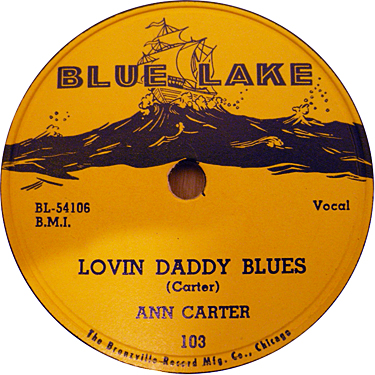
Ann Carter (according to her daughter, Barbara Berry, email communication, November 14, 2009) was born in Montgomery, Alabama, in 1915. She was the sister of Robert James Carter, the bass player and bandleader who recorded from 1946 to 1948 for Specialty, Sunbeam, and Universal. She was the niece of Sonny Carter, the "Romantic Gentleman of Song," who worked out of Detroit (later Los Angeles) and recorded for Dot Records. She moved to Chicago after marrying, but did not use her married name professionally. At the time of her Blue Lake session she was living at 3707 South Parkway, the same address as her brother.
Blue Lake 103 is rare on 78. Collector Richard Reicheg reports that he has never seen it on 45 rpm, leading him to surmise that a single pressing run of the 78 was the only one that Blue Lake made. Al Benson decided not to re-record Ann Carter, whose agent had been trying to get her a deal with the Los Angeles-based label Dootone, and released her from her contract on November 10, 1954.
According to Barbara Berry, Ann Carter continued to sing in clubs in the Midwest. She cut back her activities after opening a beauty shop, and scaled back further after her mother died in 1968. Ann Carter died in 1977.
Red Saunders would return to the studio again, for another Blue Lake session behind Lou Mac, who took over from Ann Carter in the tough female vocalist department, and Walter Spriggs. These were done several months later (the tape box number is 2914), and employed two smaller groups.
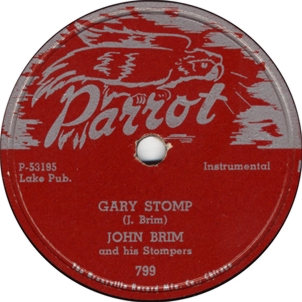
Guitarist John Brim was born in Hopkinsville, Kentucky, on April 10, 1922. He moved to Indianapolis in 1941 and Chicago in 1945; from 1952 onward he lived in Gary, Indiana. Along with his wife Grace (who played harmonica and later took up the drums), Brim made recordings for Detroit-based Fortune (1950), the Saint- Louis-based Random (1951), JOB (1951-52), and Checker (1953). "Rattlesnake," from Checker sessions in January 1953, brought together Brim's laid-back vocals with Little Walter's blazing harp work. Taken for granted in its day because it was an obvious knockoff on "Hound Dog"—it was actually withdrawn before release because Duke Records was behaving litigiously—it is now recognized as a classic of the Chicago blues. A second classic Checker session, in May 1953, produced the amiably salacious "Ice Cream Man," which was passed over for release altogether. No wonder Brim started looking for another label. The Parrot sides were done in March 1954 (we find this date, which was given on a 1971 Chess Vintage Series LP, much more plausible than the December 1953 date that appears on the Relic reissues). Making a very rare sideman appearance on this session was Jimmy Reed, whose first big hit for Vee-Jay had been recorded but not released yet, on harmonica. Eddie Taylor was the second guitarist, and Grace Brim was at the drums. With "Tough Times," Brim gave Benson something he rarely got out of his blues artists—a hit.
Brim didn't end up staying with Parrot, either. He recorded two sessions for Chess in 1955 and 1956, both of which led to releases, then for the next fifteen years he was out of the recording studio, though he continued to work in the clubs. He resumed recording in 1971 with a single on his own label, and much later recorded for Wolf (1989), Tone Cool (1994), and Anna Bea (1999). Grace Brim died in June 1999, and John died on October 1, 2003.
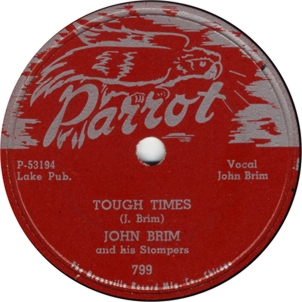
Jazz pianist and bandleader King Fleming was born Walter Fleming on the North side of Chicago, on May 4, 1922. In 1942-1943, not long after graduating from McKinley High School on the West Side, he led a popular Swing band in Chicago. After service in the Navy, he recorded in Los Angeles with groups led by Johnny Alston and King Perry before returning to Chicago in November 1946. Despite regular work in the clubs and occasional recording gigs as a session pianist, his Blue Lake session was his first as a leader. In November 1953 Fleming returned to Chicago after another stay in Los Angeles; the Blue Lake session was made before April 1954, and judging from the fact that there is a two-track gap in the 53100 matrix series at 53196 and 53197, we figure it was done after the second Ahmad Jamal and the John Brim, which would put it around March of 1954. He had begun leading a vocal-instrumental ensemble, with a female singer plus Fleming, the bass player, and the drummer singing his vocal arrangements. So far as we can determine just the two released tracks were recorded. Al Benson had begun saving money by recording two-tune sessions and paying the musicians half the Union scale for them. This was strictly contrary to Musicians Union rules, which prescribed a minimum of four sides per session; in July 1955 Benson would be called on the carpet by Local 208 for engaging in this practice. The condition of the piano raises a different possibility, however; Fleming might have produced the recordings himself, using an empty club, and sold them to Benson.
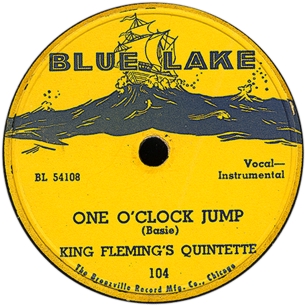
Fleming's combo on this occasion consisted of the distinctive Lestorian tenor saxophonist John Neely (1930-1994), bass player Russell Williams, and drummer Aubrie Jones. Jazz singer Lorez Alexandria (1925-2001) made her recording debut on this session; she sings solo on "Williams' Blues" and participates in the bop-oriented vocal ensemble on that number as well as "One O'Clock Jump." King Fleming performed regularly at the Kit Kat Club from 1955 through 1959, generally using a vocal-instrumental ensemble similar to the one we hear on his Blue Lake (Williams and Jones worked with him during much of this period; he collaborated with different saxophonists, and replaced Lorez Alexandria, when she went out on her own, with Ethel Duncan). He did some session work for Chess that produced enough for an LP but led to just one single under his own name; he also led a big band that used arrangements by a younger pianist named Muhal Richard Abrams. In 1957 his combo backed Lorez Alexandria on her first two LPs for King. King Fleming finally achieved his breakthrough on record when the Chess brothers signed him to their Argo label in 1960 and he went on to make three highly distinctive trio LPs for them. King Fleming's trio was still performing regularly in the Chicago area as late as 2009; he released a CD on Southport in 1996 and a second in 2000.
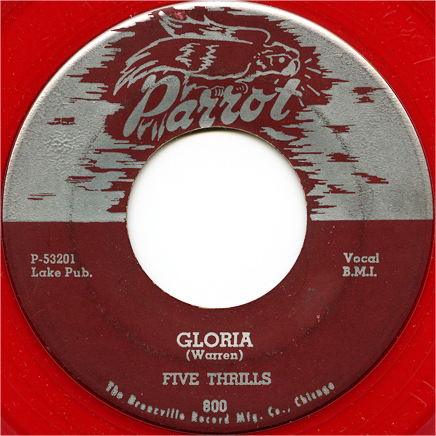
Al Benson wasn't through with the Five Thrills. He brought them back for a second session, probably in March. This time the regulation four tunes were cut; again a Paul Bascomb unit provided the accompaniment.
In January 1954, the Bascomb band had taken up a gig at the Heatwave (contract accepted and filed on January 21). In late March, Bascomb began 2 weeks at the Jewell Lounge, 5114 Prairie Avenue (contract posted April 1). He and his musicians would be back at the Heatwave in May (indefinite contract posted May 20, 1954). In the fall of the year, Bascomb would be working at Martin's Corner on the West Side. We are not sure who was in his band at this juncture. Stanley Dance, in his notes to Bad Bascomb, the reissue of Bascomb's United recordings on Delmark DL- and DD-431, mentioned that Bascomb's Chicago bands included Rozelle Claxton (piano), Johnny Avant (trombone), and Marshall Thompson (drums). There had been some turnover since Bascomb recorded "Jan" the previous fall, but we have no contemporary documentation of his personnel in March 1954. Besides the leader's tenor sax, what we hear on the seession is a pianist (perhaps Claxton), a guitarist (probably Roland Faulkner), a bassist, and a drummer (perhaps Marshall Thompson).
Two sides from this session were released in May on Parrot 800, and duly attributed to the Five Thrills. Compared to Parrot 796, the record is scarce today. Somewhere along the way Benson got a notion to change the vocal group's name to the Earls. So it was the group name under which the two previously unreleased sides have been issued. (The Chess tape list simply says Five Thrills and gives the titles as "It's a Shame" for P 53198 and "Bitter Dreams" for P 53199.) Benson made some kind of deal with the Chess brothers over these sides, probably in January 1955 when he was involved in some other joint ventures to record doowop groups. The original tapes for this session were stolen many years ago from the Chess vaults, and reissues have had to rely on a bootleg Parrot LP from the 1970s that marked the first release of the two sides attributed to the Earls.
When Benson picked up Sunnyland Slim (born Albert Luandrew in Vance, Mississippi, on September 5, 1906) he was adding a legendary name to his blues roster. Sunnyland inaugurated his recording career as a leader in August or September 1947 with sessions for Hy-Tone and Aristocrat. The Aristocrat was a historically crucial event, as it also introduced a guitarist named Muddy Waters to what was still a small, struggling independent label. Slim would cut one more session each for Aristocrat and Hy-Tone; sessions followed for Victor (as Doctor Clayton's Buddy), Opera (as Delta Joe—these were reissued on Chance), Tempo-Tone, Mercury, JOB (where he was a regular at sessions from 1949 through 1954, and probably owned a piece of the company), Regal, Apollo, his own Sunny label, Airway, and Vee-Jay. Benson put him on wax as activity was temporarily winding down at JOB, and Slim was getting ready to bail out of that enterprise. Meanwhile, Vee-Jay was unsure of the commercial prospects for down-home blues, and decided not to release any of the sides from Slim's February 1954 session (which were among the best that he had ever recorded).
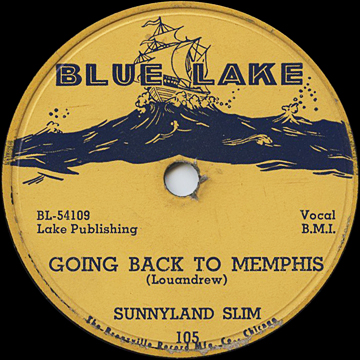
Featured on Slim's first single, Blue Lake 105, was "Going Back to Memphis." "Memphis" is an overheated, chaotic sounding version of "Rollin' and Tumblin'," and all the stronger for it. Deejay Sam Evans, who owned several shops, told blues historian Mike Rowe that he "just couldn't stock enough" of the record. Years earlier, Evans had said the same thing to Cash Box (July 10, 1954, p. 10). There is no consensus as to the musicians on this session: Snooky Pryor (harmonica) and Eddie Taylor (guitar) have been cited, and as both recorded with Slim for Vee-Jay and appeared on other sessions for Benson they are plausible choices. There are actually two guitars on the number (Floyd Jones, who had recorded with Slim for Chance and Vee-Jay, is a pretty good candidate for the lead player)—no bass or drums. And the somewhat rugged recording quality (metaliic piano, fuzz-toned lead guitar, and distorted amplified harp all piled on one another in a manner not characteristic of Universal Recording) makes one wonder whether Benson could have acquired the session from Joe Brown or some other entrepreneur now forgotten. A more pensive but still blazing rendition of "Devil Is a Busy Man" rounds out one of Benson's best blues singles.
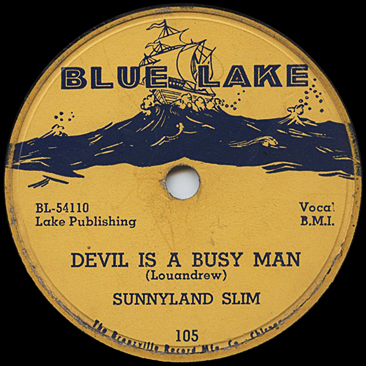
In what looks like a separate two-tune session, Sunnyland Slim cut a second single, Blue Lake 107. On "Shake It Baby" and "Bassology," both familiar tunes from his repertoire, Slim was accompanied by a harmonica player, two guitars, and a string bass. Somebody with a couple of maracas provided the shaking on "Shake It Baby." The recording quality is less congested than on the previous session, providing headroom for the cleaner, more fluent lead guitar. A reasonable guess would be that Eddie Taylor is the lead player and Floyd Jones is on second guitar. The bass player, whose slap playing is inevitably featured on the instrumental boogie "Bassology," appears to be Slim's old buddy Big Crawford. The only negative on this session is a harp player given to inane one-note accompaniments and rudimentary solos. This can't be Snooky Pryor, unless he was badly hung over, or had to be rushed to the dentist's office as soon as the session was finished.
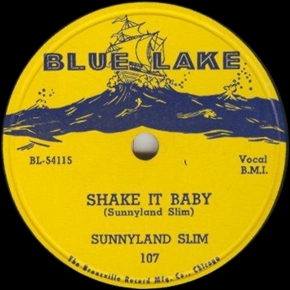
In October 1954 Sunnyland Slim was playing at the Fat Man's Corner (235 East 31st). Slim went to make one of his very best records for Club 51 in 1955, with a band that featured Red Holloway on tenor sax and Lefty Bates and Louis Myers on guitars. He recorded for Cobra in 1956. After a down period in the late 1950s, he resumed recording as a leader in 1960, with a plethora of singles and LPs to his credit. Revered as an elder statesman of the blues, he died in Chicago on March 17, 1995.
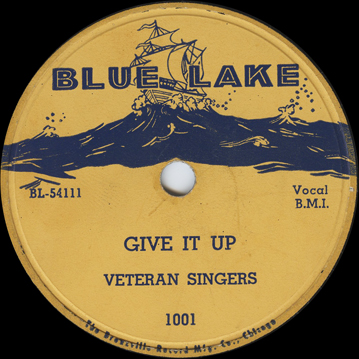
The Veteran Singers were a Detroit-based gospel group that Benson brought to Chicago to record for his operation. The male gospel quintet had previously cut two sessions (in Detroit) for United in March 1952. They would cut another two sides in Detroit for DeLuxe, but these have never been issued. The Veterans' lone single for Benson was released as both Blue Lake 1001 and Parrot 1001 (the Blue Lake is easier to find today). It's too bad that Benson waited over a year on it (it came out in January 1955 and was reviewed in Cash Box, February 5, 1955, p. 29). The record features two strong performances with a group sound rather like that of the Dixieaires or the Southern Stars. We wish we knew who was responsible for the smooth tenor lead on "Give It Up" and the more impassioned falsetto lead on most of "The Old Account." Accompaniment was by string bass (well played and prominent on the recording) and drums.
The single would be reissued in 1964 on the Vivid label, one of the shorter-lived subsidiaries of Vee-Jay. Vivid 103 carried new matrix numbers on each side: 64-002 for "Give It Up" and 64-004 for "The Old Account Was Settled." What the chain of transmission was, we have no idea.


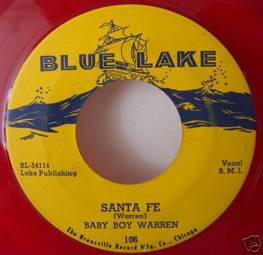
A more exotic addition to the blues roster was Baby Boy Warren, born Robert Henry Warren in Lake Providence, Louisiana, on August 13, 1919. Though he never acquired widespread fame as a blues artist, he has always had a loyal following. Based in Detroit rather than Chicago, he first got on wax in 1949-50 with the Staff label. His next session was on the J-V-B label. Though there is some doubt about where his Blue Lake sides were recorded, we think they were done in Chicago. (We know that Al Benson brought the Veteran Singers from Detroit to Chicago to record, probably around the same time; in 1955 he would do likewise with the doowop group The Fascinators.) We should note, too, that while just 2 tunes by an artist during this time period usually signal that the sides were purchased, Benson was by now in the habit of recording 2-tune sessions. Warren recorded only once more after his Blue Lake outing, for the Detroit-based Drummond label. He died on July 1, 1977.

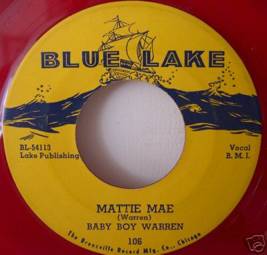
Whether it was before or after his sessions with Sunnyland Slim and Baby Boy Warren, Benson also began what was to be a profitable relationship with blues artist J. B. Lenoir (whose last name was pronounced "Lenore," and occasionally rendered that way on record labels). There's been a load of unclarity about the date of Lenoir's first Parrot session, but we can place it with some confidence in March 1954.
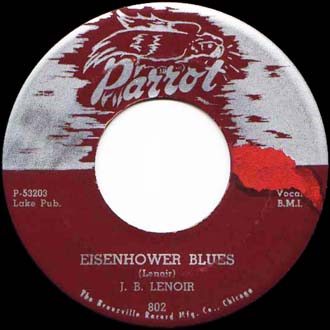
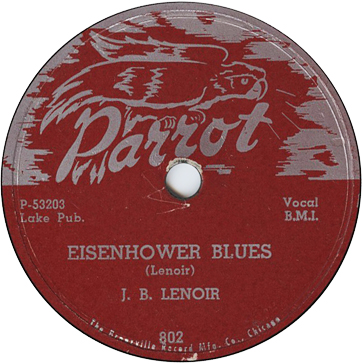
A guitarist known for his high-pitched singing, J. B. Lenoir was born in Monticello, Mississippi, on March 5, 1929, and arrived in Chicago in the late 1940s. His first recording session was done in December 1950 for Joe Brown, but all four sides were immediately sold to the Chess label, which put them out in 1951. Lenoir's 1952 recordings were released on Brown's own JOB label. Rather unusually for a bluesman, J. B. became known for topical, even protest songs. Indeed, his first session for Parrot was one of the most topical of his career. In the days before Jay Leno's nightly lampoons of Bill Clinton, a number like "Eisenhower Blues" that mentioned a sitting president must have been thought excessively topical. Not long after "Eisenhower Blues" was released, Benson rushed Lenoir back to the studio to remake the piece as "Tax Paying Blues," with all references to Eisenhower deleted. Or so we've been told. All this actually required was changing three occurrences of "I got the Eisenhower blues" to "I got the tax paying blues"; some suspicion lingers that the "remake" was actually just an alternate take made as the number evolved during the March 1954 session.
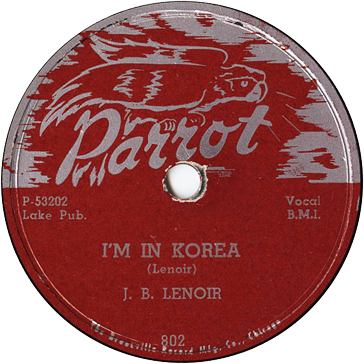
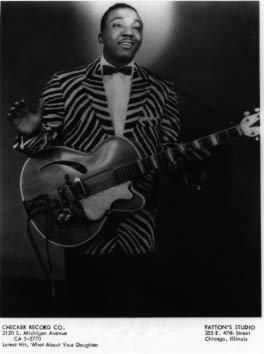
There's been a lot of confusion about this session because, the possible quick remake excepted, J. B. recorded a total of three times for Parrot with his working group. On the two 1954 sessions (plus remake), it consisted of Lorenzo Smith (tenor saxophone), Joe Montgomery (piano), and Al Galvin (drums); on the 1955 session, Smith's lone tenor sax would be replaced with a two-horn front line. Meanwhile, none of Lenoir's Parrot sessions used a bass player. By ear, it is only possible to distinguish sides made in 1954 from those made the next year.
To make matters worse, some J. B. numbers were dealt to Chess long before the big transaction of 1958 or 1959. Consequently, the big tape list from 1959 shows "I'm in Korea," from J. B.'s first Parrot session, as boxed with two numbers ("Fine Girls" and "I Lost My Baby") that were recorded at his next session on October 6, 1954 (then renumbered to make them appear to be from October 1955), and another title ("I Must Die") that is unproblematically from October 6, 1954. We'll do our best with these items, which have confused reissue programmers no end.
The Swans (a premier doowop group whose membership remains unknown) appear to have been backed by a rhythm section including Horace Palm (piano and organ), with guitar, bass, and drums. Their sides were never issued on Parrot. However, two sides by the Swans were assigned master numbers 7649 and 7650 in the Chess master book; if these are the same items (as appears likely) a recording date in mid-1954 is indicated.
We aren't likely to do better, because the original tapes of The Swans were stolen many years ago from the Chess vaults; reissues have had to use a bootleg Parrot LP that came out in the 1970s as a source. Apparently Benson was involved in some new joint venture with the Chess brothers; there is a better documented example from January 1955 that involved two other vocal groups, the Fortunes and the Clouds.
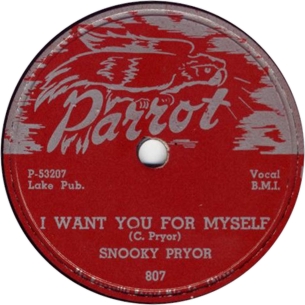
Maybe the last in the run of blues sessions was a 2-tuner by James Edward "Snooky" Pryor, who sang and played harmonica. Snooky Pryor was one of the founders of the bar-blues style in postwar Chicago. Born in Lambert, Mississippi, on September 15, 1921, he was working as a musician in Arkansas by the late 1930s. He came to Chicago in 1940. He first recorded for Marvel and Planet with Moody Jones in 1948. Al Benson knew Snooky's first recordings well, as he and Egmont Sonderling bought the Snooky and Moody material in 1949 and reissued it on Old Swing-Master. Sessions for JOB followed in 1949, 1952, and 1953.
Parrot recorded Pryor with Eddie Taylor (guitar), Moody Jones (bass), and Lazy Bill Lucas (piano). He is in good form instrumentally on both sides—"Crosstown Blues" shows how he has assimilated "Nine Below Zero" by Aleck Miller aka Sonny Boy Williamson #2—but his vocals are uncharacteristically sloppy. There was a lone session on Vee-Jay in 1956, which tried to force him into the Jimmy Reed mold, then Pryor did not resurface till 1963, when he made a powerful but amateurishly engineered session (it was done in Joe Brown's basement) for JOB. After retiring from the music business in the 1960s, he was "rediscovered" in 1971 by Living Blues, which brought him a resurgent career in the LP market directed at new White fans of the music; he remained active into his 80s, dying in Cape Girardeau, Missouri, on October 18, 2006.
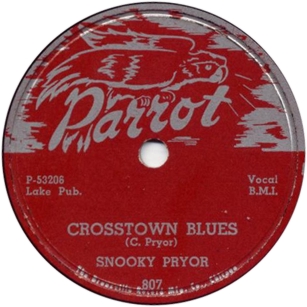

By far the most prominent vocal group that Al Benson would record was the Flamingos. When they were brought to Parrot by their manager Ralph Leon, they were the hottest group in Chicago, coming off two years of sustained recording at Chance Records and regular appearances in Chicago clubs and theaters.
The group that recorded four sides for Benson in July had changed leads since its last session for Chance. It now consisted of Nate Nelson (lead), Johnny Carter (first tenor and falsetto), Zeke Carey (second tenor), Paul Wilson (baritone), and Jake Carey (bass). As on their later Chance sessions, the group was backed a combo led by Al Smith. On this occasion, Smith brought either Lucius Washington or Cliff Davis (tenor sax), probably Willie Jones (piano and celeste), Lefty Bates (guitar), and Paul Gusman (drums).
Released in August, Parrot 808 coupled a jump ("On My Merry Way," composed by Walter Spriggs) and a yearning ballad ("Dream of a Lifetime"). For some reason, Cash Box didn't review it till January 1955 (January 22, 1955, p. 22). Another ballad side ("I Really Don't Want to Know") was held for the Flamingos' second release, on Parrot 811.


On August 12, Benson brought the Victorettes back into the studio, conferring on them the distinction of being the only gospel group he recorded twice. But the sides made that day have never been issued.
The "Jeannette Sims' Victorettes" released a single on the PS label (probably Paul Serrano's company) in the late 1960s. Mary L. Morris told Bob Marovich that Jeannette Sims died sometime in the late 1980s. According to her obituary in the Michigan Chronicle, Mary McNairy died in March 1997.

On October 6, J. B. Lenoir returned to the studio for Parrot. This time Benson was eager for more material, and the band cut six tunes, even though we can verify the matrix numbers on just the two items that were used for the next Parrot release. (The session is not on the 1959 Chess tape list, because everything had been dealt to the company earlier.) "Sitting Down Thinking" has been dated October 6, 1954 on a recent MCA reissue package, and the only horn on it is Lorenzo Smith's tenor saxophone, so we are confident that it originally bore one of the missing matrix numbers: P 53216 or 53217.
![J. B. Lenore [sic],](parrot821brc.jpg)
Lenoir had a stable working group and preferred to record with it, so the personnel are the same as on his previous session-plus-remake: Lenoir (vocals and guitar), Lorenzo Smith (tenor saxophone), Joe Montgomery (piano), and Al "Turn the Beat Around" Galvin (drums). Galvin has become notorious for getting the beat turned around—then, as soon as he had extricated himself from his previous predicament, getting it turned around again. But Lenoir's rhythm was so steady that the group's pulse came from his guitar, while Galvin's, er, adventures could be heard as implied polyrhythms.
The session produced a hit for Parrot when the company released "Mamma Talk to Your Daughter," which became J. B.'s signature tune. It was reviewed in Cash Box on January 22, 1955 (p. 22) and featured in a company ad on January 29 (p. 28). Parrot 809 is one of the easiest to find on the used market. Decades later, the song has strong legs in the Carolinas, as a Beach Music standard.
It turns out that two different versions of "Talk" were released on Parrot 809. The more common take goes into a tenor sax solo around 1:50 into the tune where the less common version goes into a guitar solo instead, and the more common take runs to 2:47 while the less common is around 15 seconds shorter. Our thanks to Richard Reicheg for alerting us to the variants.
Two other matrix numbers from this session are bogus: on the last Lenoir single for Parrot, released in November 1955, P 55275 and 55276 were assigned to "Fine Girls" and "I Lost My Baby" to make them appear to be newly recorded. Parrot 821 was released in a batch with 819 by The Orchids and 820 by Dusty Brown. All three were promoted in Cash Box on November 12, 1955 (pp. 26, 27), and advertised together on November 19 (p. 34) and December 3 (p. 31).
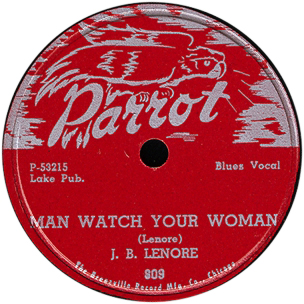
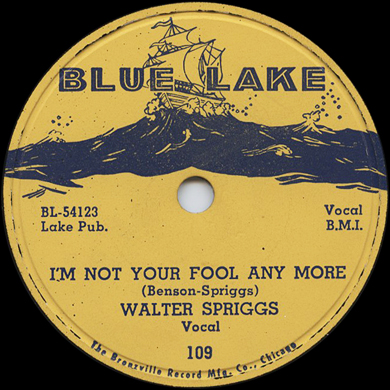
Most Blue Lake sessions from 1954 are difficult to date. But the next one was included in the 1958-1959 deal with Chess, so we have a tape box number for it. At 2914, the session was recorded after the one by the Victorettes (2646) and before those done by the Maples (3036) and Little Willy Foster (3139). We'll place it tentatively in October. Benson brought in a Red Saunders combo to back two singers.
Walter Spriggs was fairly active in the local clubs from 1952 to 1957. He wrote songs that were performed by doowop groups, most notably the Five Echoes, with whom he had an ongoing connection. And see above for one of his songs that was picked up by the Flamingos. Spriggs first recorded in New York City with the band led by tenor saxophonist Charlie Ferguson; the session date is unclear but was probably in the fall of 1952. Spriggs' Apollo 445 was released some time during the first half of 1953; if Spriggs did anything more for the label, it's untraced. He next recorded as a guest lead singer on the Echoes' August 1953 session for Art Sheridan's Sabre label. He reappeared on the Echoes' session of January 1954, on which he sang lead on two sides using the distinctly uninspired stage name of "Wally Wilson"; an alternate take has surfaced on which "Wilson" sang without the Echoes. As Chance and Sabre were winding on, Spriggs moved over to Al Benson's operation. On "I'm Not Your Fool Anymore," Benson teamed Spriggs up one more time with The Five Echoes (though he did not bother to mention the group on the label).
From the published information that we have, courtesy of Rob Ford, Walter Spriggs is almost certainly the 7-year-old resident of St. Louis, Missouri listed in the 1940 US census. That Walter Spriggs was born in Arkansas in 1933, the son of William and Ollie Spriggs, both of whom had been born in 1898, William in Arkansas and Ollie in Mississippi. He had two older sisters, Mary and Geraldine. Where Walter Spriggs got his musical instruction we do not know, but he sang and played piano, guitar, bongos, and drums.
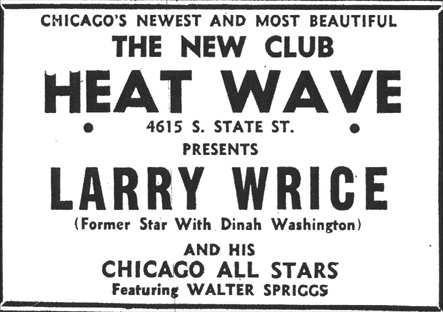
He was already appearing in Chicago in the fall of 1952, when one "Walter Sprague (Blues Singer)" was featured in a show at Martin's Corner, 1900 West Lake Street, accompanied by Deacon Brown's band (Chicago Defender, October 2, 1952). He also got billing in an ad (Chicago Defender, April 3, 1954, p. 24) for Club Heat Wave, 4615 South State Street, where he was working with Larry Wrice (drummer, ex-husband of Dinah Washington) and his Chicago All Stars. He spent some time in 1954 at the Club DeLisa, as we know from a photo of him taken there by organist Lonnie Simmons.
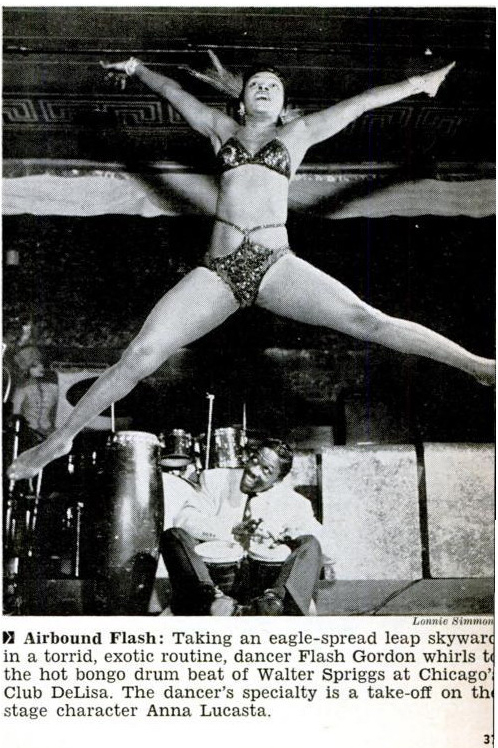


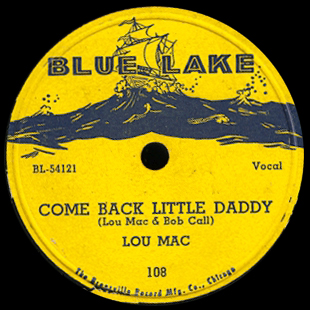
The other two numbers featured Lou McClinton, a tough R and B singer who was apparently a Benson discovery; her marquee name was Lou Mac. On Spriggs' two numbers, Red used a front line of Sonny Cohn (trumpet), Leon Washington (tenor sax), and Mac Easton (baritone sax). The Lou Macs replaced Cohn with guitarist Ike Perkins.
Lou Mac's first release, on Blue Lake 108, was reviewed in Cash Box on January 22, 1955 (p. 22). On January 29, 1955, it was featured in a Parrot/Blue Lake advertisement (Cash Box, p. 28).
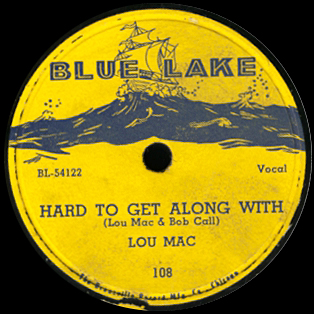
Perhaps it was in 1955 that Walter Spriggs began using the stage name Raymond Scott. A drummer under that name worked with Jimmy Reed, appearing on the January and March 1955 sessions that Reed and Eddie Taylor cut for Vee-Jay. The Scott name might have invited some confusion with the eccentric composer, birth name Harry Warnow, who had previously taken it. Jim O'Neal met the drumming Ray Scott and does not think he and Spriggs were the same person.
Spriggs, using his real name, joined the Kansas City Tomcats (led by guitarist Lucky Enois), a group that toured widely and recorded for Josie in New York City. His role in the Tomcats was lead vocalist (see http://doo-wop.blogg.org/kansas-city-tomcats-c28921836). Cash Box ran a picture of the group on October 22, 1955 (p. 28), with a blurb about their lightning signing by Jubilee/Josie's A&R man (Billboard announced the signing on October 29). Josie 786 by the Tomcats was advertised in Cash Box on November 5, 1955 (p. 23). It was reviewed in Billboard on November 19, 1955, p. 50, and in Cash Box on November 5, 1955, p. 30). It didn't sell anything like Josie 785 by the Cadillacs... A second Tomcats single, Josie 797, was released in 1956 and not covered in the trades.
On August 4, 1956, Walter Spriggs recorded a single for Atco, in New York with Jesse Stone's band; it was released in September. He would continue his association with Stone for a few years. The Atco carried the name Walter Spriggs. Returning to Chicago, Spriggs went as Ray Scott, operating Scotty's Rock and Roll Inn from 1955 through 1957. There he led a house band that included Luther "Guitar Junior" Johnson. Spriggs/Scott retained some level of affiliation with Chicago blues performers for a few more years; in 1959 Little Walter Jacobs recorded his song "Nobody but You." In 1958 and 1959 Spriggs seems to have spent more of his time in New York. Hedging his bets, he recorded twice in 1959 for a small label called Antler; one single came out under the Spriggs name, the other as by Ray Scott. One of the Spriggs sides featured a Jesse Stone tune. In 1960, Ray Scott and combo put out a rock and roll single on the Tri-Ess label, featuring "Silk, Satin & Lace" by Jesse Stone. Tri-Ess, for that matter, sounds like a joint enterprise of Spriggs, Stone, and somebody else whose last name started with S.
Scott/Spriggs spent a little time in Los Angeles, garnering a writeup in the LA Sentinel. (Paul McGee, "Success Beckons: The Great Scott — Portrait of a Man in a Hurry...!" May 30, 1963, p. A-8, A-9) that helped us resolve the confusion over his identity: "Ray Scott, versatile singer, dancer, musician and comedian, who was christened Walter Spriggs," was now aged 29, and was born in Arkansas. According to the McGee piece, Scott had arrived in LA from New York City for a three-week comedy gig at the Club Hideaway, where he had been held over. He had begun billing himself as "The Great Scott." Spriggs/Scott had been doing comedy since 1959, and was said to know George Kirby and Redd Foxx, both of whom he would have had multiple opportunities to meet and observe in Chicago. His most recent recordings were mentioned, including "Silk, Satin & Lace." The article further credited him with playing bongos on a Roy Hamilton song and with other recording work with Billy Williams and Johnny Ray, as well as "a tour of 27 countries of Europe." Of course, had Scott landed his own TV show or been in a movie, we would have heard more from other sources. What Scott did get out of the Hideaway gig and the Sentinel piece was a contract with Dooto, then the label of both Redd Foxx and George Kirby; he was shown signing on the dotted line in the July 6, 1963 issue of Cash Box (p. 41). On November 23, 1963, Cash Box ran an ad for Dooto 837, "Sex Is Funny."
In 1970, Checker released a single by Ray Scott. Since one side of Checker 1234, "The Prayer," is a Redd Foxx bit, it points to "our" Ray Scott. The last sighting we have is from New York once again, in 1974. Ray Scott was running a music publisher called Spriggs Productions, Inc. (BMI) out of his apartment at 400 Central Park West. When Jim O'Neal encountered that Ray Scott, a little later, he was opening for Johnnie Taylor in Chicago (and serving as MC). O'Neal, who verified that Scott's real name was Walter Spriggs, was unable to catch up with him for an interview, but Spriggs/Scott was living in Texas at the time.
Walter Spriggs was a performer of multiple talents who never got the big break he was expecting. We're pretty sure that his musical activities are still not completely documented.

The Maples were a one-time ad hoc gathering of vocal group singers who came together in November 1954. The Five Chances started working with singer Kenneth Childers, who was paying for his own sessions to get on record. Reggie Smith and Howard Pitman recalled the Five Chances (using the name Maples) making a recording with Childers. But it never got that far, according to Johnny "Chubby" Jones (who was the lead singer for the Five Chances at the time). Rather, Jones arranged to back Childers at the recording session with an ad hoc group consisting of himself, Albert Hunter (from the Clouds), and Andrew Smith (from the Fasinoles). The record was "I Must Forget You" b/w "99 Guys" and the group was dubbed the Maples.
Like many Benson-produced jump sides, "99 Guys" gets a superb instrumental break—courtesy of Von Freeman on one of the tenor saxophonist's first recordings. But the singing in the chorus is pure vocalized bebop—way too much unison for harmony fans.
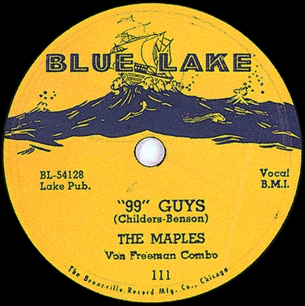
Earl Lavon Freeman Sr. was born in Chicago on October 13, 1923. (The year was long thought to be 1922, but an article by Howard Reich, "Rewriting History: Chicago Jazz Legend Von Freeman's Birth Year is Wrong," Chicago Tribune, January 10, 2011, reveals what the contents of the saxophonist's birth certificate, which also spelled his first name "Earle." See http://www.chicagotribune.com/entertainment/music/ct-live-0111-jazz-von-freeman-20110110,0,811601.column.)
Von Freeman played his first professional gig (in Gary, Indiana) at the age of 12. Freeman attended DuSable High School, where he studied under Capt. Walter Dyett. In 1940-1941 he was a member of Horace Henderson's big band. After playing in a Navy band during World War II, he returned to Chicago in 1945. From 1946 through 1950 he was a member of the house band at the Pershing Ballroom, along with his brothers George Freeman, who played electric guitar, and Eldridge "Bruz" Freeman, who was the drummer. Unfortunately, it so happens that on the best-known live recording from the Pershing, in which the house band backed Charlie Parker (October 23, 1950), Claude McLin was in the tenor sax chair. Another live recording from the Pershing, also from the Fall of 1950, does seem to include Von—but the recordist switched the machine off when Bird wasn't playing.
This session with the Maples may have been Von Freeman's first time inside a studio. It is definitely the first studio session he did as a leader. A year before the session with the Maples, the Freeman Brothers band (which again included George on guitar and Bruz on drums) held down a gig at Martin's Corner on the West Side (contract posted with Local 208 on November 19, 1953). An earlier incarnation of the Freeman Brothers band had included Ahmad Jamal on piano; at the time the Maples session was recorded the pianist was most likely Andrew Hill.
During the same period—roughly from mid-1954 through early 1955—Von and George Freeman were making a series of vocal and instrumental demos that ended up in the hands of Club 51 proprietor Jimmie Davis. They were trying to interest the boutique label in recording them, but despite the quality of some of the performances they submitted, Davis decided instead to use Eddie Chamblee and Red Holloway on his sporadic studio sessions.
In March 1959, Von Freeman appeared on an all-instrumental session for Vee-Jay, one of the last to be made under the leadership of Al Smith; nothing from it has ever been released. During the late 1950s and much of the 1960s, he was on the road backing blues singers or participating in R&B revues. He reestablished himself as a full-time jazz musician in 1969 and made his breakthrough recording as a leader when he cut an LP for Atlantic in 1972; Rahsaan Roland Kirk recommended him to the label. He subsequently recorded for Nessa, Daybreak, Columbia, and other labels. In later years, he established weekly jam sessions on Tuesday nights at the New Apartment Lounge (504 E. 75th Street). He finally gained a measure of fame in his 70s. Von Freeman died in Chicago, aged 88, on August 23, 2012 (see http://articles.chicagotribune.com/2012-08-13/entertainment/chi-von-freeman-dies-chicago-jazz-music-20120813_1_von-freeman-chicago-jazz-new-apartment-lounge).

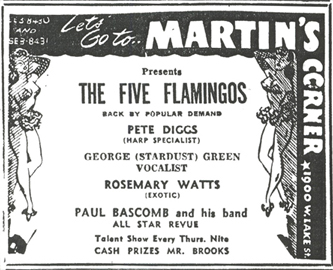
The Flamingos returned for a second batch of 4 tunes in November. They had been recently performing with Paul Bascomb's group at Martin's Corner on the West Side, but Al Benson preferred to use a studio band led by Al Smith on the date. A four-horn front line (Sonny Cohn, trumpet; Booby Floyd, trombone; Eddie Chamblee, tenor saxophone; and Mac Easton, baritone sax) lent a big-band atmosphere to the two uptempo numbers: "I Found a New Baby," which was held back from release, and "Get with It." The latter features a long solo by Mac Easton, festooned with his trademark corny quotes.


On "Ko Ko Mo" and the ballad, "I'm Yours," the group was accompanied by just Red Holloway, with Horace Palm (piano and organ), Quinn Wilson (bass), and Paul Gusman (drums). On "Ko Ko Mo," Palm reminds us that he wasn't much of an organist, while Gusman distinguishes himself in his prominent role on this Latin arrangement. The Kokomo celebrated in the song is a mythic tropical paradise, not to be confused with the mundane locale in Indiana.

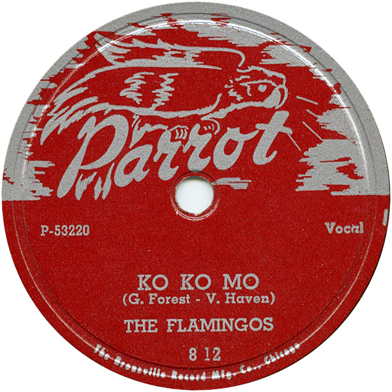
"Get with It" was used on Parrot 811, released in December 1954. Benson didn't wait around; he followed the next month with Parrot 812, "Ko Ko Mo" b/w "I'm Yours." (Parrot 812 was advertised in Cash Box on January 29, 1955, p. 28, then reviewed there on February 5, 1955, p. 28.) Al Benson apparently disliked the white-label DJ copies that were distributed by Columbia and RCA Victor as well as the smaller companies like United and States. We had thought that he never put out white-label Parrots or Blue Lakes, but a white-label Parrot 812 is extant.
Unfortunately for Al Benson, who had been able to release three strong singles on them, the Flamingos jumped ship after their second session for Parrot. The group's management was dissatisfied with Parrot's marketing efforts and its distribution network. In March 1955, as their Parrot releases were still selling, the Flamingos could be found in the studios recording for Checker. They would go on to lay down several hits for the Chess brothers, who bought the Flamingos' Parrot tapes in January 1956. In our discographical listing, the new matrix numbers attached by Chess, where these are known, are shown in square brackets. We had previously put the purchase in the last quarter of 1956, when a lot of other Parrot material would change hands, but matrix numbers in the early 8000s from Universal tell a different story.
"Get with It" was recycled as the B side to "A Kiss from Your Lips," newly recorded for Checker in January 1956. Checker 837 was advertised in Cash Box on May 5, 1956 (p. 38), reviewed on May 12 (p. 68), then readvertised on May 12 (p. 65), May 19 (p. 31), June 2 (p. 30), June 9 (p. 30), and June 16, 1956 (p. 30).
Chess also recorded a new version of "Dream of a Lifetime" for release on Checker 915. By 1958, the Flamingos had changed labels again, and were recording such hits as "I Only Have Eyes for You" for End in New York City.
| Matrix | Artist | Title | Issue | Recording Date | Release Date |
| P-53185 | Ahmad Jamal | But Not for Me | Parrot 810 | January 1954 | prob. December 1954 |
| P53-186 | Ahmad Jamal | Excerpts from the Blues | Parrot 818 | January 1954 | October 1955 |
| P53-187 | Ahmad Jamal | It Could Happen to You | Parrot 818 | January 1954 | October 1955 |
| P 53188 | Ahmad Jamal | Joon's Tune | unissued | January 1954 | |
| P-53189 | Ahmad Jamal | Seleritus | Parrot 810 | January 1954 | prob. December 1954 |
| P-53190 | The Peace Makers | When I Go | Parrot 109 | c. February 1954 | 1954 |
| P 53191 | The Peace Makers | unidentified title | unissued | c. February 1954 | |
| P-53192 | The Peace Makers | I Know What I Believe | Parrot 109 | c. February 1954 | 1954 |
| P 53193 | The Peace Makers | unidentified title | unissued | c. February 1954 | |
| BL-54105 | Ann Carter | You Oughta Quit It | Blue Lake 103 | February 19, 1954 | c. June 1954 |
| BL-54106 | Ann Carter | Lovin [sic] Daddy Blues | Blue Lake 103 | February 19, 1954 | c. June 1954 |
| P-53194 | John Brim and his Stompers | Vocal John Brim | Tough Times | Parrot 799 | March 1954 | April 1954 |
| P-53195 | John Brim and his Stompers | Gary Stomp | Parrot 799 | March 1954 | April 1954 |
| BL-54107 [53196?] |
King Fleming's Quintette | William's Blues | Blue Lake 104 | c. March 1954 | c. June 1954 |
| BL-54108 [53197?] |
King Fleming's Quintette | One O' Clock Jump | Blue Lake 104 | c. March 1954 | c. June 1954 |
| P 53198 | The Earls [Five Thrills] with Paul Bascomb | Laverne | Relic LP 5087, Parrot 803 [boot] | c. March 1954 | (December 1981) |
| P 53199 | The Earls [Five Thrills] with Paul Bascomb | Darlene (Girl of My Dreams) | Relic LP 5087, Parrot 803 [boot] | c. March 1954 | (December 1981) |
| P-53200 | Five Thrills | Wee Wee Baby | Parrot 800 | c. March 1954 | May 1954 |
| P-53201 | Five Thrills | Gloria | Parrot 800 | c. March 1954 | May 1954 |
| BL-54109 | Sunnyland Slim | Going Back to Memphis | Blue Lake 105 | early 1954 | July 1954 |
| BL-54110 | Sunnyland Slim | Devil Is a Busy Man | Blue Lake 105 | early 1954 | July 1954 |
| BL-54115 | Sunnyland Slim | Shake It Baby | Blue Lake 107 | early 1954 | late 1954 |
| BL-54116 | Sunnyland Slim | Bassology | Blue Lake 107 | early 1954 | late 1954 |
| BL-54111 | Veteran Singers | Give It Up | Blue Lake 1001 Parrot 1001 |
early 1954 | January 1955 |
| BL-54112 | Veteran Singers | The Old Account Was Settled | Blue Lake 1001 Parrot 1001 |
early 1954 | January 1955 |
| BL-54113 | Baby Boy Warren | Mattie Mae | Blue Lake 106 | early 1954 | prob. July 1954 |
| BL-54114 | Baby Boy Warren | Santa Fe | Blue Lake 106 | early 1954 | prob. July 1954 |
| P-53202 tk. 2 | J. B. Lenoir | I'm in Korea | Parrot 802 | c. March 1954 | April or May 1954 |
| U 53203 tk. 1 | J. B. Lenoir | Eisenhower Blues | (Relic LP 8017) | c. March 1954 | |
| P-53203 tk. 5 | J. B. Lenoir | Eisenhower Blues | Parrot 802 [1st issue] |
c. March 1954 | April or May 1954 |
| P-53203AA | J. B. Lenoir | Tax Paying Blues | Parrot 802 [2nd issue] |
April or May 1954 | May 1954 |
| P 53204 | See | Preliminary | Parrots | Above | |
| P 53205 | See | Preliminary | Parrots | Above | |
| 7649 [?] | The Swans | I Love You So | Relic LP 5088, Parrot 801 [boot] | mid-1954 | (1976; December 1981) |
| 7650 [?] | The Swans | Will You Be Mine | Relic LP 5088, Parrot 801 [boot] | mid-1954 | (1976; December 1981) |
| P-53206 | Snooky Pryor | Crosstown Blues | Parrot 807 | prob. May or June 1954 | prob. summer 1954 |
| P-53207 | Snooky Pryor | I Want You for Myself | Parrot 807 | prob. May or June 1954 | prob. summer 1954 |
| P 53208 | The Flamingos | On My Merry Way | Parrot 808 | c. July 1954 | August 1954 |
| P 53209 | The Flamingos | Dream of a Lifetime | Parrot 808 | c. July 1954 | August 1954 |
| P 53209 [alt.] | The Flamingos | Dream of a Lifetime | [Chess ACRR-702] | c. July 1954 | |
| P 53210 | The Flamingos | If I Could Love You | [Chess ACRR-702] | c. July 1954 | |
| P 53211 | The Flamingos | I Really Don't Want to Know | Parrot 811 | c. July 1954 | December 1954 |
| P 53212 tk. 4 | Victorettes | He'll Keep You | unissued | August 12, 1954 | |
| P 53213 tk. 4 | Victorettes | Tell the Angels | unissued | August 12, 1954 | |
| U 53214 or 53215 [P-53215 on label] |
J.B. Lenore [sic] | Man Watch Your Woman | Parrot 809 | October 6, 1954 | January 1955 |
| U 53215tk. 2 or 53214-2 [P-53214 on label] |
J.B. Lenore [sic] | Mamma Talk to Your Daughter | Parrot 809 | October 6, 1954 | January 1955 |
| U 53215alt. tk. or 53214-2 [P-53214 on label] |
J.B. Lenore [sic] | Mamma Talk to Your Daughter | Parrot 809 | October 6, 1954 | January 1955 |
| P 53216 [?] | J.B. Lenoir | Sitting Down Thinking | (Chess 2ACMB208, Relic CD 7020) | October 6, 1954 | |
| P 53217 [?] tk. 2 | J.B. Lenoir | I'm Gonna Die Someday (I Must Die) | (Relic LP 8017) | October 6, 1954 | |
| P-55275 tk. 1 | J.B. Lenore [sic] | Fine Girls | Parrot 821 | October 6, 1954 | November 1955 |
| P-55276 tk. 1 | J.B. Lenore | I Lost My Baby | Parrot 821 | October 6, 1954 | November 1955 |
| BL-54121 | Lou Mac | Come Back Little Daddy | Blue Lake 108 | c. October 1954 | January 1955 |
| BL-54122 | Lou Mac | Hard to Get Along With | Blue Lake 108 | c. October 1954 | January 1955 |
| BL-54123 | Walter Spriggs | I'm Not Your Fool Anymore | Blue Lake 109 | c. October 1954 | late February 1955 |
| BL-54124 | Walter Spriggs | Week End Man | Blue Lake 109 | c. October 1954 | late February 1955 |
| BL-54127 | The Maples | Von Freeman Combo | I Must Forget You | Blue Lake 111 | c. November 1954 | April 1955 |
| BL-54128 | The Maples | Von Freeman Combo | "99" Guys | Blue Lake 111 | c. November 1954 | April 1955 |
| U 53218 [8004] |
The Flamingos | I Found a New Baby | [Chess ACRR-702] | November 1954 | |
| P 53219 [8079] |
The Flamingos | Get with It | Parrot 811 [Checker 837 |
November 1954 | December 1954 [May 1956] |
| P-53220 | The Flamingos | Ko Ko Mo | Parrot 812 | November 1954 | January 1955 |
| P-53221 | The Flamingos | I'm Yours | Parrot 812 | November 1954 | January 1955 |
![J B Lenore [sic],](parrot815a45bv.jpg)
We pick up here as the matrix numbers switched to the 55 prefix. The fortunes of the Parrot/Blue Lake combine were declining. Economic indicators did not deter Al Benson from ambitious plans for three LPs, which occupied his efforts from May to July—but just one of these was issued. As far as we can tell, the matrix numbers ran from 55224 through 55280, except for a patch of Blue Lakes that carried 55129 through 55132, perhaps in a jump from 54128 and so on... Whatever was going on, confusion hit a local maximum around 55233. For a series of blues sessions on December 8 and 9, 1955, the matrix series reverted to 55-133 through 55-142, then then a final reversion took the series from 55281 through 55285. The last four matrix numbers on Parrot and Blue Lake, B 823 through B 826 (or is that 223 through 226?), belong to an entirely different series; we have concluded that they date from 1956, after Benson had sold the company. Assuming that the Johnny Griffin album (which has proven to be a pain to date) belongs amongst the year's output, 87 sides were recorded in 1955.
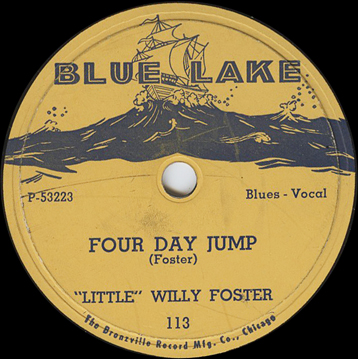
Little Willie Foster is a harmonica player with just three recording sessions to his credit. He was born in Clarksdale, Mississippi, on April 5, 1922. He came to Chicago in 1941 and learned his harmonica from Big Walter Horton. Al Benson discovered Foster performing at Vi's Lounge, on the West Side, and teamed him up with guitarists Floyd Jones and Eddie Taylor and pianist Lazy Bill Lucas to produce the superb "Falling Rain Blues." The usual story has Foster being backed by Lucas, Jones, and drummer Ray Scott. But a listen to the instrumental that appeared on the flip side, "Four Day Jump," reveals a pianist, two guitarists, and no drums. Foster made just two usable sides, which were released twice, once on Blue Lake 113 and again, in the lablel's final days, on Parrot 813.
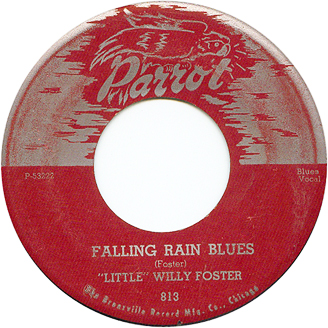
All previous sources have supplied a 1953 recording date for Foster's two released titles. We now know that there were two Little Willy Foster sessions, and both of them took place in 1955. Al Benson had gotten into the habit scheduling half-sessions (2 sides instead of 4, paying the musicians half the usual fee; several 1954 sessions for Blue Lake were probably done this way). When the musicians on the second Little Willy Foster session complained that they hadn't received all of their pay, that brought his modus operandi to the attention of Musicians Union Local 208. The whole matter was hashed out in the minutes of the Board meeting on July 21, 1955.
Members Willie [sic] Foster, Raymond Scott, Eddie Taylor and Floyd Jones appeared before the Board as notified re: their recording session for Al Benson on January 14, 1955. Mr. Benson was not present when the case was called.
The aforementioned members with the exception of Raymond Scott stated that they made the first half session on January 14, 1955, and the second session which included Scott was made on or about June 10, 1955. All admitted that they were paid per half session. Foster stated that he received $40.00 and the balance of his money was applied to an amplifier which Mr. Benson purchased for him.
Taylor stated that he was paid $15.00 at one time and $6.25 at another and then borrowed $30.00 on or about June 24. All of the members stated that they made five sides but that Benson only accepted two.
Benson was contacted by telephone and told to appear before the Board immediately, otherwise the services of musicians would be denied him. Within a few minutes he appeared and the matter was discussed with all parties concerned. It finally developed that all members stated that Mr. Benson had paid them in full for their services.
On motion, the Board dismissed the case, and instructed the Secretary to notify Willie Foster that the Local tax on the engagement must be paid immediately.
The Board also instructed the Secretary to notify Mr. Benson that all contracts for recording session must be signed and filed with the Local before the session is made. He was also to be instructed that under no circumstances were members of orchestras to get an advance or to make draws. The full amount of the recording session must be paid into Local Headquarters within fourteen days; checks made out individually. He was to be further notified that the Local would not permit half-sessions. In the event that only two sides were made, the musicians must be paid for a full session. (pp. 1-2)

Since Lazy Bill Lucas was not summoned in front of the Board, we may fairly conclude that he recorded with Foster on January 14 but not on June 10. So here is what we think happened. Two numbers ("Falling Rain Blues" and "Four Day Jump") were recorded on January 14 with Foster, Lucas, and the two guitarists, Jones and Taylor; they were given matrix numbers P53222 and 52223 and placed in tape box 3139. On the June 10 session, Foster, Jones, and Taylor were joined by drummer Ray Scott (probably "the other Ray Scott," not Walter Spriggs); they taped three numbers, and Benson rejected the lot. There was some precedent in Bensonville for parallel releases on Parrot and Blue Lake, but we don't think this one was planned. Maybe Benson had anticipated putting material from the June session on Blue Lake 113. but after the June session bombed, he had only January material on hand, and nothing left for a further release on Parrot 813. In any event, Blue Lake 113 got a review in Cash Box on July 24, 1955 (p. 42).
The release of Parrot 813, to judge from the label style and colors, did not take place until 1956, when Lawyer Burton had taken over. We would like to know exactly when, but we have found no ads for Parrot 813. Nowadays, this delayed Parrot release is definitely harder to find than the Blue Lake.
If Benson had any further interest in recording Little Wilie Foster, he lost it when Foster took his complaint to the Union. Foster would record just one more time, for Cobra in 1957, with nearly the same personnel as his June 1955 session, before a gunshot wound left him physically unable to continue in music.
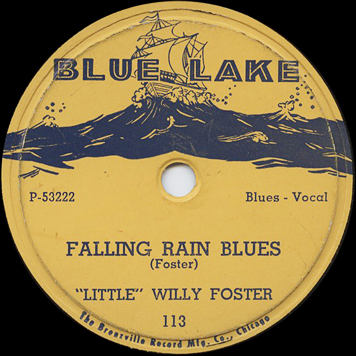
The Fortunes (whose vocal lineup is known) got to record after winning a talent contest put on by McKie Fitzhugh at the Pershing Ballroom in January 1955. Their instrumental backing (tenor sax, baritone sax, piano/celeste, guitar, bass, and drums) was not provided by Al Smith's regulars, Paul Bascomb, or Red Saunders. The tenor player sounds a bit like Harold Ousley or Von Freeman and the string bass player liked to slap. A Willie Dixon group seems most likely (notice the rhythm on "Bread"). In fact, Michel Ruppli's Chess discography lumps two of the Fortunes' sides and two by the Clouds into a Little Walter session that took place on January 25, 1955. Obviously "Love" and "Bread" were not by Little Walter! But this does help to nail down the date, and is consistent with Willie Dixon's involvement.
It looks to us as though Benson and the Chess brothers had a joint venture to record the groups that won the contest. In a note that appeared in Cash Box on February 12, 1955 (p. 33), the recent session by the Fortunes and the Clouds is mentioned and both titles laid down by the Fortunes are correctly cited. No mention of Benson or Parrot; the groups are said to have "cut their first sides for Chess." But the item also says Chess would be releasing them soon, and that didn't happen. In any event, items that Chess acquired after Parrot went out of business would not been assigned master numbers that Chess was using in early 1955.
The original tapes for The Fortunes were stolen many years ago from the Chess vaults; reissuers have had to use a bootleg Parrot LP that came out in the 1970s as a source. The Fortunes went on to make two sessions exclusively for Chess, in March and May of 1955. These led, in turn, to the group's only single, Checker 818 (released in June 1955).
Just what connection the Clouds had with Parrot / Blue Lake was a mystery for many years. One side of theirs, "Say You Love Me," surfaced on a bootleg "Parrot" LP in 1976; eventually it came out in legitimate form on a Relic CD in 1994. Another showed up in 1971 on Broadcast 1002, a 45 rpm release from a company that specialized in doowop bogosities. "Baby Wants to Rock" was coupled on the Broadcast 45 with "She's a Good One," an unissued side by The Larks from a 1959 Chess session.
It turns out that the Clouds recorded for Al Benson after participating in the same contest put on by McKie Fitzhugh. "Say You Love Me" looked like an isolated oddity because it was the only track that remained with other Parrot material.
Four sides were assigned Chess matrix numbers indicating a recording date on January 25, 1955 and remained with the Chess brothers. Chess never used them and their provenance did not been widely known until 1999, when they were mentioned in the notes to Catch the Windy City Harmonizers: Unreleased & Rare Chicago R&B Vocal Groups — The First Round (Power Vine 6082), a bootleg CD of Chess doo-wop that was purportedly made in Indonesia. The band on "Say You Love Me" appears to be the same one that backed The Fortunes; it's almost certainly the same guitarist. "Baby Wants to Rock," the only track included in the Power Vine collection, frustrates investigators because it also lacks instrumental solos. The Clouds went on to record for Cobra in 1956.
With hit record now in hand, J. B. Lenoir returned to the studio for a third time on March 14, 1955. The first order of business was to record a sequel to "Mama Talk to Your Daughter"; the Chess tape list shows that four tracks were done in all. Prrot 814, with "Mama Your Daughter Is Going to Miss Me" was out in May 1955 but didn't catch a review in Cash Box till August 13 (p. 24).
According to a recent MCA reissue CD, "Give Me One More Shot" was done with a personnel of Alex Atkins (alto saxophone), Ernest Cotton (tenor sax), Joe Montgomery (piano), Lenoir (vocals and guitar), Willie Dixon (bass), and the inimitable Al Galvin (drums). Both saxes can be heard, and there's no doubt about Galvin's presence. But no string bass is audible; Dixon would begin appearing on Lenoir's sessions only in 1956, well after Lenoir signed with Checker later in the year.

The same day, Al Benson recorded a vocal group called the Fascinators. They had their beginnings in Detroit around 1949 or 1950. The group consisted of Jerry Potter (second tenor and lead); Donald Blackshear (lead baritone), Bob Rivers (bass), Clarence Smith (first tenor and main lead), and Earl Richardson (lead baritone/tenor). Before traveling to Chicago to record for Benson, the Fascinators had only done some very amateurish recordings (four sides in all) for a tiny Detroit operation called Your Copy. From the Fascinators' session at Universal Recording, two jumps were selected for release: "Can't Stop" and "Don't Give My Love Away." Jerry Potter's recollection is that the other two tunes recorded were "But I'll Remember" and "My Beauty, My Own." The Chess tape list includes "My Beauty, My Own" as P 55230 and omits "But I'll Remember" (we have included it in our table without a matrix number). The Chess list actually leaves off the vocal group's name (someone has scratched off the ditto marks next to a couple of the Fascinators' titles, to indicate that whoever is on these tracks, it isn't J. B. Lenoir!)

"Don't Give My Love Away" is a faster and more jumping remake of a piece that the Fascinators had done for Your Copy. The original title was "Don't Give It Away"; Benson changed that because he thought "it" sounded suggestive. "Can't Stop" is led by Richardson and "Don't Give My Love Away" by Blackshear, and the group gets nice support from the good swinging combo of session men; as out of towners, the Fascinators had no idea who they were, but auditory evidence indicates another Al Smith group, with no less than Willie Jones on piano, Quinn Wilson on bass, and Vernel Fournier in the drum chair. Red Holloway's tenor sax breaks are terrific. Potter recalled the recording date (at Universal Recording, Studio A) as taking place in the early fall of 1954. However, the matrix number and tape box evidence (J. B. Lenoir and the Fascinators under file number 3168) say March 14, 1955.
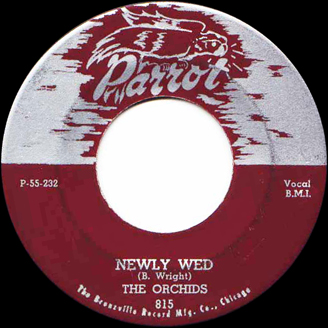
The Orchids, in the 8 titles they cut for Parrot, have to rate as one of the most splendid doowop groups to come out of Chicago. All of them were from the South Side. Gilbert Warren was the principal lead and composer; he had matured considerably since his days as lead singer for the Five Thrills. Bass Buford Wright wrote and sang lead, and second tenor Robert C. Nesbary also played piano for the group. The two remaining members were Ashley Farr and Hubert White. At one point the group was reduced to four, because during the week of September 2, 1955, they appeared as the Four Orchids on a Benson-sponsored package show at the Regal Theater with LaVern Baker, the Spaniels, the Four Fellows, J. B. Lenoir, Lou Mac, and Buddy and Ella Johnson. In its blurb for the production, Cash Box had billed them as the Five Orchids (September 3, 1955, p. 21), so something must have happened not long before the show started.
On their first session, the Orchids put down two splendid tracks in "You're Everything to Me" and "Newly Wed," which take several steps away from deep R&B doowop toward rock and roll. The evidence of the tape box numbers (3168 for J. B. Lenoir and the Fascinators, 3283 for these four sides, 3366 for the Johnny Griffin LP, 3384 for the Five Chances and Lou Mac) puts this session in April 1955. Al Benson obviously thought their work was significant, because he released both sides promptly in June. Parrot 815, continuing the tardy pattern, was reviewed in Cash Box on August 6, 1955 (p. 29).
We used to think that "Hey Miss Fine" and "Fine Sweet Woman" came from the Orchids' second session in September, but the 1959 tape list gives us P 55234 for "Fine Sweet Woman" and P 55233 for something that the compiler called "Please Don't Leave Me" (far from a unique title for a doowop number... but each verse of "Hey Miss Fine" ends "Please don't leave me, no, no, no, no, no"). Sterling accompaniment on hand from an Al Smith group with Red Holloway on tenor sax, probably Norman Simmons at the piano, Lefty Bates on guitar, Quinn Wilson on bass, and Vernel Fournier on drums.
An unexplained oddity is how the original tapes from The Orchids' Parrot sessions ended up with Vee-Jay material. The four Orchids sides not released during the lifetime of Parrot/Blue Lake first saw the light of day in 1993—on a Vee-Jay reissue CD. The Vee-Jay CD used the same titles that were on the Chess brothers' list of Parrot tapes. All of the Orchids tapes were subsequently returned to Relic Records, which included them in two of its own CDs, in 1993 and 1994.
On May 4, 1955, Al Benson undertook a session that went nowhere. It is not known how many titles were recorded, but all were rejected. (Not knowing how many, and lacking a reason to believe that Al Benson did anything with the tapes except run them through the bulk eraser, we have not counted them toward Parrot and Blue Lake's total items recorded in 1955.) The leader on the session was blues pianist Bob Call. He had assembled a quintet of two blues musicians and three jazzers, as we learn from the formal complaint that he brought before the Board of Musicians Union Local 208:
Member Robert Call appeared before the Board as notified re: his claim against Mr. Al Benson of the Parrot Record Company for a session made at Universal Studios May 4, 1955.
Mr. Benson failed to appear as notified.
Member Call stated that he rehearsed three times with one of the rehearsals at Mr. Benson's home. The members of his orchestra were Johnny Griffin [tenor sax], Richard Barnett [drums], Charles Parham [string bass], and Echford Cooper [electric guitar]. He futher stated that when they arrived at Universal Studios about 9:00 p.m., they made several tapes, none of which seemed to please Mr. Benson. (Board meeting minutes, May 19, 1955, p. 1)
Obviously Benson had declined to pay Call et al. for their work on the session. Echford Cooper, by the way, normally went as Lee Cooper.
The case was continued at the next Board meeting.
Al Benson and member Robert Call appeared before the Board as notified. Mr. Benson requested that the case be reopened due to the fact that he was out of town at the last Board meeting and was not able to give his side of the question...
Mr. Benson stated that Robert Call did not give him the musicians that he asked for. When they arrived at the studio Call had changed the arrangements completely with the result that the vocalists whom he was to accompany were never able to come in or do the record as it was rehearsed. He further stated that he wanted Call to do two numbers with one set of vocalists [and two with another]... (Board meeting minutes, June 2, 1955, p. 1)
We don't know how the beef was resolved, but in cases like these the Local 208 Board normally supported the musicians.
From late May through July, Al Benson turned his attention toward the 12-inch LP. This was a bold gesture for the proprietor of a small independent. The fiscally conservative Chess brothers would put out their first LP for another few months, and Vivian Carter and Jimmy Bracken of Vee-Jay would hold off till 1957. Benson had recorded enough Coleman Hawkins sides back in August 1953 to fill an LP, but apparently lost interest in the project after issuing two Parrot singles on Hawk. Now he would record three LPs, though just one actually saw issue on his own label, and one has never been issued at all.
The first Parrot LP has been ignored in every previous discography. It appeared under the title Ahmad Jamal Plays. We don't know the exact release date, but it was after October 1955 (Parrot 818, "Excerpts from the Blues," was advertised in Cash Box on October 8, p. 25) and before March 1956, when Al Benson sold the company. According to Zeno Okeanos, some copies of this LP, which was pressed on very thick vinyl, have no serial number; according to Robert Javors, other copies went by Parrot LP100.
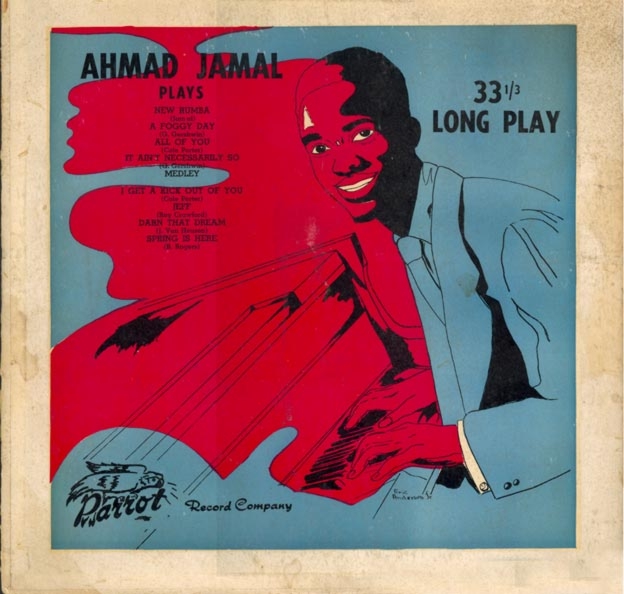
The Parrot Jamal LP contains 9 titles, all of which the existing sources say were recorded on May 23, 1955. Jamal was still working with a piano-guitar-bass trio, but Israel Crosby had replaced Richard Davis on bass. A source of confusion has been the discrepancy between the Side A label and the jacket concerning one track. According to the jacket, the first track on Side A is "New Rhumba"; according to the label it is "It Could Happen to You." The album actually plays "New Rhumba." Apparently at some point Al Benson planned to use "It Could Happen to You" (P 53187 from the January 1954 session, recorded after all with the same personnel) but changed his mind and left it off the LP. On the Chess tape list, "It Could Happen to You" is identified as coming from tape box 3367, even though its session mates from January 1954 are said to reside in box 2266. We are reasonably sure that box 3367 was used for the LP (the May 23, 1955 tracks aren't included on the 1959 list because Chess had bought them in 1956).
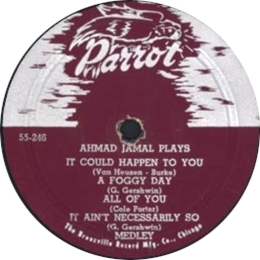
According to Robert Javors, who once owned a copy, the original Parrot LP is quite rare and copies have sold for $600 or more. Dr. Robert Stallworth provided further information about the LP, including the matrix numbers for each side. (The 1959 tape list is of no help here, because Chess already owned the LP.) Parrot followed a pretty common practice in the early days of LPs by giving each track on the Jamal LP a matrix number and then attaching separate ones to the Side A master and the Side B master. We've listed the tracks in order of their appearance on the LP: Side A began with "New Rhumba" and Side B with "I Get a Kick out of You." The matrix numbers could have gone in a different order, but we are confident that they belong to the correct block in the 55200 series.
The Chess brothers bought the Jamal LP tracks in 1956. The same 9 tracks that made up Ahmad Jamal Plays would be reissued twice under a new title: Chamber Music of the New Jazz. "Lawyer" Burton, who bought Parrot and Blue Lake in March 1956, was making noises to the trades in June about starting a label called Burtone that would put out all three Parrot LPs, including the Ahmad Jamal (Cash Box, June 30, 1956, p. 26). But in July there were no Burtones and Burton was busy with his new Sapphire label instead. Then on August 11, 1956, Cash Box announced that "Argo Releases First Jazz LPs" (p. 24). These were Argo Creative LPs 602 through 605; Chamber Music of the New Jazz was LP 602.
The Chess brothers had first opened a label called Marterry in December 1955, putting out two singles and LP-601, Melodies by Al Hibber, under this logo. But they yanked the new name in March 1956, when society bandleader Ralph Marterie, who recorded extensively in Chicago for Mercury, complained about it. The new label was hastily rebranded as Argo, a name that would stay in use until 1964, when it was changed to Cadet.
However, Neal Umphred's Goldmine Guide to Collectible Jazz LPs, 1949-1969, 2nd ed., 1994) claimed that album first saw release as Creative LP-602; Umphred interpreted this as a different name for the label that was briefly adopted as a stopgap.
The solution to this mystery is now at hand. An ebay auction in December 2009 featured a copy of Argo LP 602 with a wordy logo on the front cover: "Creative High Fidelity Modern Music Produced by Argo." The Argo label on this release was the silver on black "ship" design also used on the first Argo singles. And the labels on each side of LP 602 still carried their Parrot master numbers.
Three other LPs were out briefly in this early Argo series: 603 by James Moody and 604 by one Pinky Winters (both are advertised on the back of the "Creative" Argo 602). Creative Argo LP 605, in the same batch (see also Cash Box, September 1, 1956, p. 20), was by Dick Lane. In the August 11 article, Phil Chess had proclaimed, "We have a new sound which we call 'Creative Hi-Fidelity Modern Music.'" At some point in the fall of 1956, un-Creative Argo LP 606 was released, and on subsequent pressing runs 602 through 605 were replaced by LPs without the Creative version of the Argo logo, and labels with "Argo" laid out in large block letters down the left side. The rarely seen "Creative" Argo releases were dimly remembered as coming from a different label.
When LP 602 was rereleased in the later Argo LP series some changes were also made to the back cover.
Chamber Music of the New Jazz was a highly influential record; Miles Davis recorded several of the numbers that Jamal played on it. In 1999, jazz critic Terry Teachout singled out Chamber Music in a New York Times article about important jazz LPs not yet reissued on CD. However, Ahmad Jamal would enjoy his greatest popular success after moving to the piano-bass-drums format and signing with Argo.
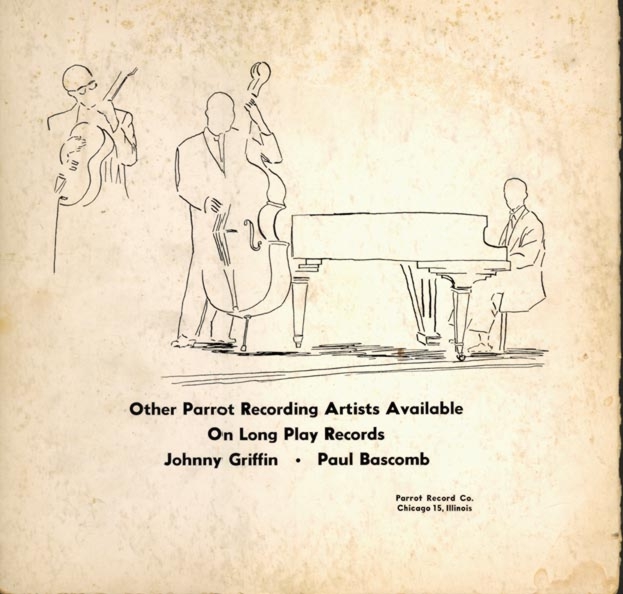
When issued, the Ahmad Jamal LP carried an advertisement for an LP by jazz tenor saxophonist Johnny Griffin. Born in Chicago on April 24, 1928, the "Little Giant" was already an established name outside his home town, having served with Lionel Hampton from 1945 to 1947, with Joe Morris from 1947 to 1949, and made a number of New York City recording sessions. The Parrot LP was to be derived from the same Johnny Griffin Quartet session that appeared in 1958 as J G on Argo LP-624 (three tracks reappeared on a Chess Vintage Series LP CHV-414 in November 1971, and the whole album was reissued in Japan in the late 1970s on Baybridge UPS2202).
Argo LP-624 was done with a rhythm section of Julian "Junior" Mance (piano), Wilbur Ware (bass), and Wilbert "Buddy" Smith (drums). Discographies have always given the recording date of Argo LP-624 as "c. 1956." But from the Chess tape list, we learn that the LP tracks were given master numbers consistent with a recording date in May or June 1955, after the sessions for the Jamal LP and before the Bascomb LP sessions. However, Griffin stated in an interview that he and his quartet actually cut the record at the end of the Coleman Hawkins session for Parrot; he also recalled that Al Benson was drunk and let the band play whatever they wanted, as long as they didn't run past the end of the studio time Benson had reserved. The Hawk session was all the way back in August 1953, and around that same time Mance, Ware, and Smith were the house rhythm section at the Bee Hive. So if Griffin's recollection is correct, the sides sat around for the better part of two years before Benson thought about issuing them.
Perhaps, then, the Griffin LP was actually done at the tail end of the Ahmad Jamal session of May 23, 1955? (Tantalizingly, the 1959 tape list puts the Griffin LP master tapes under file number 3366—and a copy of Jamal's P 53187 version of "It Could Happen to You," which was apparenly being considered for use on his LP, under file number 3367.) We also know that Griffin was in town and recording for Parrot less than three weeks earlier, on the abortive session of May 4 that was led by Bob Call. Obviously there are discrepancies still to be resolved here. At least we now know the original matrix numbers for the tracks (the 1959 tape list doesn't give matrix numbers for Side A and Side B—did Benson never get this far in his plans for the LP?). We have listed the tracks in the order they appear on the LP, so the first two matrix numbers are out of order.
Johnny Griffin went on to make several sessions for Blue Note, in 1956 and 1957, then recorded heavily for Riverside, Jazzland, and Prestige through 1963. He then moved to Europe, residing in France till 1978, in the Netherlands till 1984, finally making his home again in France. He compiled a lengthy discography, becoming one of the elder statesmen of jazz (he played his last concert at the age of 80). He died in Mauprévoir, France, on July 25, 2008.

We're willing to bet that on the ill-fated session of May 4, Bob Call was supposed to be backing Lou Mac and the Five Chances. Call got joint composer credit for Lou Mac's "Baby," which got recorded on the Lou Mac/Five Chances session that has survived. The tape box number (3384) puts that session not too long after 3366 and 3367 (the Johnny Griffin and Ahmed Jamal LPs)—in other words around the end of May 1955. So Al Benson took the titles that fizzled on May 4 and had them remade with the the crack Al Smith combo that had worked the Fascinators' session.

As one might imagine, the Five Chances first recorded for the Chance label. After a personnel change or two, the group that recorded for Blue Lake consisted of Johnny "Chubby" Jones, Darnell Austell, Reggie Smith, Howard Pitman, and Harold Jones. For Benson, the Five Chances recorded the best single of their career, "All I Want." Without histrionics or exotic stylings and mannerisms the group created a vocal harmony classic. Austell's evenly modulated lead is nicely echoed by fine chorusing and counterpointed by Jones' high tenor alternate lead on the bridge (which creates a dramatic tension in the song). Though entire group was credited as writers, we should note that the song was originally sung by the Five Thrills on an unreleased recording for Parrot back in October 1953. The flip, "Shake-a-Link," is a catchy, appealing jump written and led by Jones. Released in the summer of 1955, the record, alas, never hit nationally and is one of the harder Blue Lakes to find today.
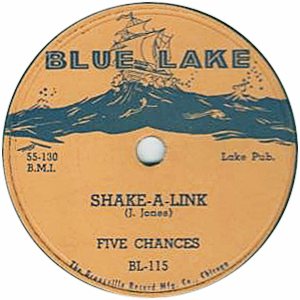

The Five Chances shared their session with Lou Mac, who was making her second completed session for Benson. "Baby" gives unflattering exposure to her vocal shrillness; the Cash Box reviewer thought she was trying to sound like Eartha Kitt. But the rollicking "Slow Down" balances her lead against sonorous responses by another doo-wop group, the Palms, and a searing tenor sax solo by the ever-dependable Red Holloway. And the rhythm section of Willie Jones, Quinn Wilson, and Vernel Fournier really outdoes itself.
We'd thought that Blue Lake 114 was released in July 1955, but Cash Box for June 11 (p. 29) was already referring to it. On the other hand, the review tagged along on August 13, 1955 (p. 24). By this point, Benson was less than prompt providing review copies to the trades.
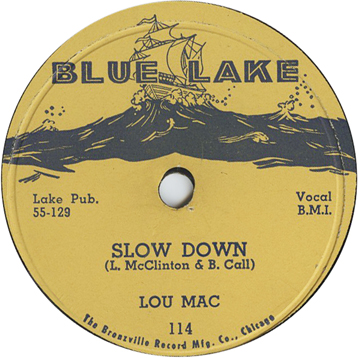
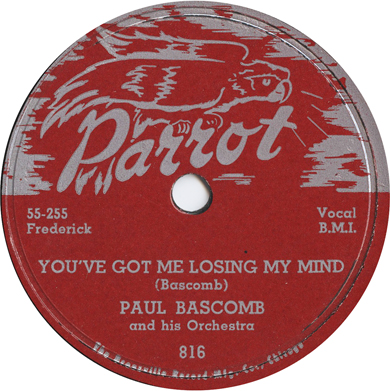
Finally, the back of the Jamal LP promises a Paul Bascomb LP. Along with his wife, singer Gloria Valdez, and a doowop group called the Five Arrows who had been imported from New York City for the occasion, Paul Bascomb returned to the studios for Parrot in July 1955. A writer in the Defender who attended this session described the instrumental lineup as trumpet, Bascomb's tenor sax, piano, bass, drums, and bongos. This lineup tallies with what we hear on the four issued sides, but the keyboardist plays organ on them. We don't have any idea who the other musicians are; more detailed information about Paul Bascomb's later Chicago bands would be much appreciated! Also, there was some kind of affiliation between Bascomb and Bud Brandom, a shadowy presence in the local music business who would soon be buying half of Leonard Allen's publishing company and going into some kind of collaboration with Joe Brown. Frederick Music was Brandom's outfit, and it is credited on all four sides that were released from this session.

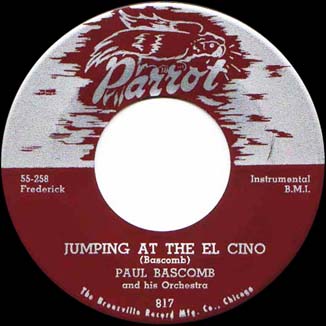
The article, which ran in the Chicago Defender in August, gave a moderately detailed description of a session on a Thursday night in July on which Bascomb cut an entire LP. It was to consist of 10 tracks (two of which the writer announced were to be simultaneously released on a Bascomb single). Obviously the two vocal numbers were not included in the plans for the LP. No fewer than 12 tracks were laid down that night. The writer mentioned just one unreleased item by name: "Danny Boy," which he said was the last tune done. (If the matrix numbers on the Chess tape list reflect the order of recording, instead of the intended programming of the LP, "Danny Boy" was actually followed by two more.) The master tapes for each of the tracks, as well as ready-to-go masters for Side A and Side B of the actual LP, were still extant in 1958 or 1959 when they were dealt to Chess. But Benson never went through with his plans to issue it. Judging from the four sides that appeared on singles, Benson and the engineer kind of got carried away with the reverb on this session. But Bascomb was a reliable performer and an LP from this period, made up mostly of his performances of standards, has to be worth hearing.
What Bascomb did get out of the session were two releases on singles, Parrot 816 (featuring Gloria Valdez and the Five Arrows) and Parrot 817 (two instrumentals). These were advertised in Cash Box on October 8, 1955 (p. 25). Also getting its launch in that advertisement was a new Ahmad Jamal release (Parrot 818, "It Could Happen to You" b/w "Excerpts from the Blues"), which was not from Jamal's recent album session but from his second session for the company back in January 1954.

In 1956 Paul Bascomb would end his association with McKie's Disc Jockey Lounge. In April 1956, he was leading the house band at Roberts Show Lounge (indefinite contract accepted and filed by Local 208 on April 19; he filed a new contract on September 6). Bascomb moved around for another year or so, but then settled into a 15-year residency at the Esquire Lounge (95th and Wentworth) with an organ trio. Bascomb's luck ran out in the early 1970s, after his Esquire Lounge gig ended; for a while, he had to support himself by working as a garbage man. But in the mid-1970s Bascomb was able to tour Europe and in 1979 he was inducted into the Alabama Jazz Hall of Fame in Birmingham. He was basically retired when he made his final appearance on record in 1982, on a session for an Yves François Smierciak LP on the Pinnacle label. According to his death certificate (in the files of the Chicago Federation of Musicians), Paul Bascomb died in Chicago on November 25, 1986.
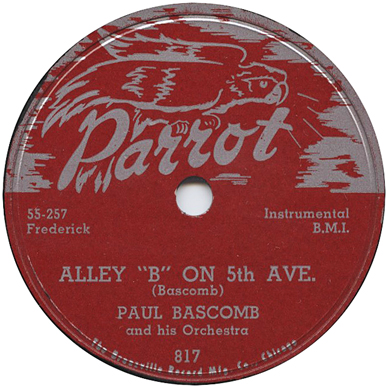
On June 30, 1956, John Henry "Lawyer" Burton, who had bought the Parrot/Blue Lake operation, told Cash Box (p. 26) that he was going to go ahead and release the LPs by Paul Bascomb and Johnny Griffin on his Burtone label—and he was going to reissue the Ahmad Jamal LP on Burtone. Nothing materialized. Talk about missed opportunities...
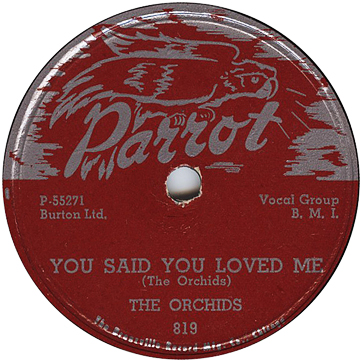
The Orchids returned in September of 1955 for a second session, which yielded another hit, "You Said You Loved Me." Another outstanding side, "You Have Two (I Have None)," had to wait until the 1990s to see release on a Relic CD. "Met a Girl on the Corner," also left unreleased till years later, features a unusual solo by pianist Willie Jones. We made that judgment by ear, but without incurring much risk, as no one else in Chicago, not even Willie's follower Louis Carpenter, sounded like this in 1955—and Vernel Fournier concurred with our findings.
The 1959 tape list gives us P 55270 as the matrix number for "Met a Girl on the Corner"; the title of P 55272 appears on the list as "Happiness." The words to "You Have Two (I Have None)" refer to hearts, not to happiness, but the "I Have None" part definitely applies. The other members of the Al Smith on this session were Red Holloway (playing more bebop than usual on his tenor sax), Quinn Wilson on bass, and either Paul Gusman or James Slaughter on drums.
Parrot 819, "You Said You Loved Me" b/w "I Can't Refuse," was released in November, along with Parrot 820 by Dusty Brown and 821 by J. B. Lenoir. On November 12, 1955 (p. 27), Al Benson was talking all three up to Cash Box. Ads ran for all three on November 12 (p. 26), November 19 (p. 34), and December 3 (p. 31). By December 10, it was clear that Parrot 819 was a hit (it would be the company's last), and it got an ad all to itself (p. 38).
This would be the last recording session for The Orchids, and the last vocal group session for the company. Another sign that things were going downhill was the change in music publishers. Benson's in-house operation, Lake Publishing, had been mentioned on the labels of most Blue Lakes and some Parrots. Parrots 816 through 818 showed credits to Frederick Music, run by Bud Brandom. Starting at Parrot 819, the house publisher was Burton Ltd., run by the man who would soon be buying the record company as well.

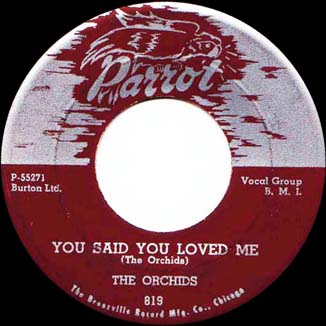

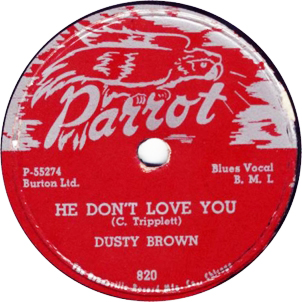
Harp player Dusty Brown was born C. W. Triplett in Tralake, Mississippi, March 11, 1929. He had been in Chicago since 1946, working as a cab driver until he took up music in 1953, playing in various West Side clubs. He made his Parrot session on October 1, 1955 (the precise date was handwritten on the Chess list of tapes obtained from Parrot, by someone who had gone through the tape box that contained his sides). The session was the first of his career. Blowing gritty Little Walter-type harp, Brown benefits from the driving support provided by Henry Gray on piano, Joe Little on guitar, and drummer Johnny Sturdivant. Parrot 820 was released in November 1955, in a batch with 819 by The Orchids and 821, the last J. B. Lenoir single for Parrot. All three were promoted in Cash Box on November 12, 1955 (pp. 26, 27), and advertised together on November 19 (p. 34) and December 3 (p. 31).
Brown's next session would not happen until 1959, when he recorded for Bandera. Although Dusty Brown made no further studio recordings that we know of, he remained active as a performer for many more years, until at least 2000; on March 11, 2014 he celebrated his 85th birthday.
We got the matrix numbers for the tracks that Parrot did not issue—"Hurry Home" and "Rusty Dusty"—from the Chess tape list. Failing to give a boost to Al Benson's reputation for exactitude, they duplicated the matrix numbers on two J. B. Lenoir sides that Parrot released around the same time.
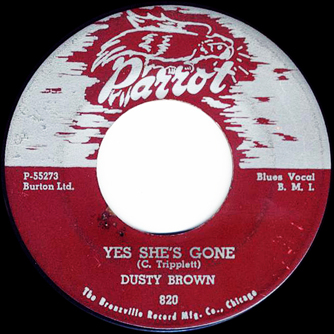

Parrot put out one last single on J. B. Lenoir in November 1955. According to a handwritten notation on the 1959 tape list, "Fine Girls" and "I Lost My Baby" were done at a session on October 6, 1955. This, however, is an obvious error; both sides feature the same band that Lenoir used on his 1954 session. Obviously they had been recorded on October 6, 1954, then given matrix numbers that made them appear to be brand new recordings (to heighten the confusion, the numbers had already been allocated to the two unissued Dusty Brown sides). The publisher credits to Burton Ltd. further indicate that the release came out late in the life of the company.
![J. B. Lenore [sic],](parrot821arc.jpg)
Lenoir had been lured away from Parrot by the Chess brothers; he cut no less than 9 titles for Checker on September 14, 1955. On December 3, Al Benson, then trying to recruit new artists, reminisced to Cash Box about "how he discovered J. B. Lenore [sic] working in a small tavern on Wentworth Avenue here in Chi" (p. 33). Leonard and Phil Chess must have understood that the last Parrot release consisted of old stuff They made no fuss about it. They delayed the release of their first Lenoir single till July 1956 (Parrot was essentially gone by then), and they kept the artist on their roster: four-tune sessions followed on December 19, 1956, May 16, 1957, and April 14, 1958. After his contract with Checker ran out, Lenoir cut a single session for Vee-Jay in 1960.
After a slack period during which Lenoir kept performing regularly but recorded hardly anything, the demand for topical songs picked up in the 60s, and a major blues revival got under way. Lenoir cut two strong LPs for the German L+R label with unusual "African hunch" rhythm accompaniment, and an LP for Polydor that was supervised by his English admirer John Mayall. Unfortunately, J. B. Lenoir was unable to benefit from renewed interest in his protest songs, or from his Beach Music potential; he died in 1967, of untreated complications after suffering apparently minor injuries in an auto accident.
In November 1955, Ahmad Jamal's trio came back to make four more titles for Parrot. Like his first session for the label, from November 1953, his last one was unknown to discography until the Chess tape list became available; we hope that the tracks haven't been lost. The material may have been overlooked because it postdated Jamal's LP session. It may have been that Jamal was now under contract to to Columbia's Epic subsidiary; on October 25, his trio with Ray Crawford and Israel Crosby had done a marathon session in New York City, laying down 16 tracks that formed the basis for two LPs. In any event, we have another indication that Al Benson thought highly of him.
In 1956, Ray Crawford left the trio and Jamal replaced him with a drummer, Walter Perkins. In the fall of that year, Jamal started a long-term association with the Chess brothers, recording an LP for their new Argo label in sessions on September 27 and October 4, 1956; the Chess brothers also bought his Parrot LP and reissued it. At the beginning of 1957, Vernel Fournier replaced Perkins. For some reason, Argo waited a year to record the new trio. But the decision to tape the trio live at the Pershing Lounge on January 16 and 17, 1958, proved to be golden: Argo LP 628 was a major hit.
Jamal stayed with Argo label (name later changed to Cadet), recording prolifically until his trio with Israel Crosby and Vernel Fournier broke up in 1962, then continuing at a barely diminished pace from 1963 to 1968 with different personnel. He was under contract to ABC Impulse from 1968 to 1972 and 20th Century Fox from 1972 to 1974, and has continued to record for a host of labels since then.
Pianist Henry Gray, was born in Kenner, Louisiana, on January 19, 1925. He served in the US Army from 1943 to 1946. He moved to Chicago from Alsen, Louisana, not long after returning from the South Pacific. Gray is best known for his contributions as a session musician, working with a host of notable Chicago blues artists, including Little Walter, Junior Wells, Jimmy Rogers, Billy Boy Arnold, Howlin' Wolf, and Jimmy Reed—not to mention Dusty Brown. His only previous session under his own name was an unissued one for Chess, done in 1953. This Parrot session from December 8, 1955 remained unknown for much of his career, and was not released until it came out on Relic in 1989.
Why the Gray sides were unissued remains a mystery, because the session is an especially strong one. At this time, Jimmy Reed was reaching a wide-ranging audience with his recordings on Vee-Jay. On "That Ain't Right" Gray and company display their own mastery of the Jimmy Reed lope, but that is just one of several styles at their command.
Gray said that the backup is by the Red Devil Trio: Little Hudson Shower (guitar), James Banister (drums), and Henry "Pot" Strong (harp). However, the powerful harp playing cannot be by Strong, who was stabbed to death on June 3, 1954 while working with Muddy Waters. Terence McArdle suggests that Little Willie Smith (who is shown in a photo of the Red Devil Trio in Mike Rowe's Chicago Breakdown) was the harpist on these sides; Little Willie switched instruments later on and became known (when on drums) as Willie "Big Eyes" Smith.
Not long after his lone session for Parrot, Gray joined Howlin' Wolf's band. After 12 years as The Wolf's regular pianist (supplemented by extensive session work for Chess), Henry Gray moved back to Louisiana in 1968. He recorded swamp blues tracks that appeared on anthologies on Arhoolie and Excello. In 1977, Gray recorded his first LP, in Germany; he did his first US LP in 1988, when he recorded in Chicago for Blind Pig. He recorded his last CD, titled 92 on account of his age, in June 2017. After several months of hospice care, Henry Gray died at the age of 95, in Baton Rouge, Louisiana, on February 17, 2020.
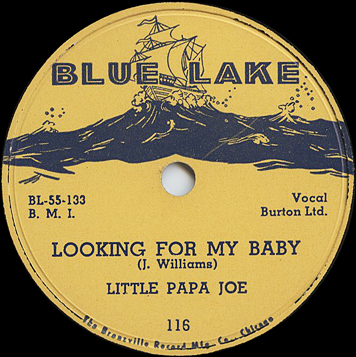
Little Papa Joe was a recording name for Joseph Leon (Jody) Williams (born in Mobile, Alabama, on February 3, 1935). The December 5 and 9 sessions produced the superb string-bending stylist's first sides as a leader. It's long been established that Williams was supported by tenor sax player Harold Ashby and Willie Dixon on bass. Recently we learned (via Scott Dirks) that Jody Williams identified the pianist as Lafayette Leake and the drummer as Phil Thomas. Ashby and Thomas were jazz musicians, and both Leake and Dixon were capable of working in a jazz context. Harold Ashby in particular is a major contributor to these four tracks. Away from the microphone, enveloped in studio echo, he creates the illusion of multiple horns. Closer in, pecking out low notes, he reinforces the rhythm. And he contributes inventive solos to the two of the sides.
The sides that Benson released, "Easy Lovin'" and the boogie "Looking for My Baby," are strong numbers, demonstrating Williams' excellent voice accompanied by marvelous picking in a style influenced by B. B. King. "Groan My Blues Away" is a suavely brilliant performance in a style like no one else's: it sounds like slide guitar even though Williams wasn't using a slide, the runs are unique, the guitar line grabs attention despite not being heavily amplified, and there is an unexpected tinge of Country and Western to Williams' vocal. Why Benson didn't rush this side out is entirely beyond us.
Taken as a whole, the session makes us wonder why Williams didn't record more on his own. Though he subsequently cut sides for Argo, Herald, Nike, and Yulando, throughout his career Williams was mainly a session man, playing during this period on releases by Howlin' Wolf, Bo Diddley, and Billy Stewart. He was an influence on Otis Rush and Buddy Guy. Williams' best known riff, originally done on a Billy Stewart song, was incorporated into a song that Bo Diddley titled "Love Is Strange" and recorded for Checker in 1956 while Williams was in his band. But, for reasons yet to be explained, the Diddley version lay untouched for years, and Atlantic ended up being the record company that profited from the song. It was Mickey Baker who did the guitar honors on the hit release of "Love Is Strange."
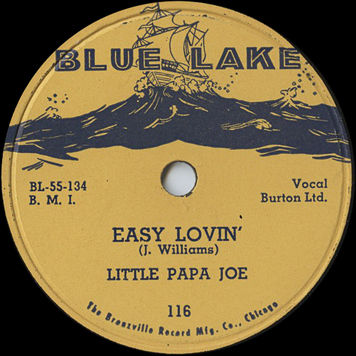
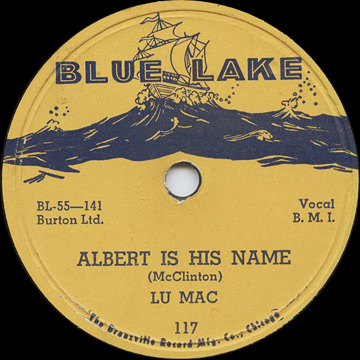
On the December 9 session, Jody Williams and company also backed Lou Mac (spelled "Lu Mac" this time around) on "Albert Is His Name" and "I'll Never Let Him Know." On her third session for Blue Lake, she benefits from the blues-band accompaniment. Jody Williams is restricted to an accompanying role, but Harold Ashby make the most of his solo opportunities on both sides.
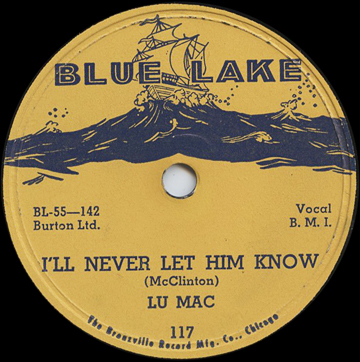
Blue Lake 116 and 117 formed a paired release, in January 1956. A "Little Papa Joe" session was mentioned in Cash Box for January 7 (p. 23), while the Little Papa Joe and Lu Mac singles were conjointly advertised in the same issue (p. 25). An ad for Blue Lake 117 appeared in Cash Box for January 14 (p. 37), then 116 and 117 were given a further push on January 28, 1956 (p. 33).

We now reach the last session done while Al Benson still owned the company. According to the Chess tape list, the tape box for the Leon Tarver/Benson-Ogletree session is numbered 4030, while the boxes for the blues sessions of December 5, 8, and 9 are numbered 3925, 3930, and 3931. So a late December 1955 date is indicated (early January 1956 is possible).
Leon D. Tarver (his name at birth was Leander; he also sometimes went as Lance) was an R&B singer, originally from Baltimore, who worked for time with a vocal group called the Chordones. Tarver and the group had recorded for Checker on two sessions, in January and April 1954; on those sides he played piano himself and was accompanied by tenor sax, electric guitar, bass, and drums. Before his time at Checker he had cut two sides for Atlantic (in 1952) as a member of the Cardinals. His Blue Lake single, made in late December 1955, would be his last. It was also his only release as a solo vocalist. On this occasion, Tarver worked with a studio ensemble that cut two instrumentals at the same session. The two sides that Benson chose to put out were slow blues sung in an incipient soul style. They provide evidence that Tarver had the potential to succeed as a soul artist.
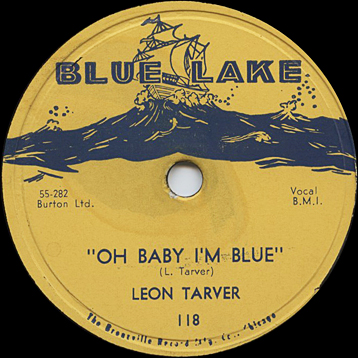

The Benson-Ogletree band was an ensemble that Lewis "Bill" Ogletree, a Swing trumpet player in Chicago, assembled in the studio to record for Al Benson. Trumpet player Lewis Ogletree was born April 16, 1914. He attended Wendell Phillips High, and played in the school's bands with Major Clark Smith and then Walter Dyett, but did not graduate. He joined Local 208 in 1932. Ogletree's first significant employment was with Erskine Tate's house band at the Regal Theater; he then worked in the bands of Johnny Long, Floyd Campbell, and Fletcher Butler. In the early 1940s, he played in the Rhumboogie house band under Milt Larkin. As Ogletree told Charles Walton, "Milt had a good band with a good book, and they played the heck out of it, but they couldn't read the show music by Marl Young." Ogletree recorded a session with Preston Jackson for Victor in 1946. In 1948, he formed a band for Al Benson, which in part recorded for Old Swing-Master. Ogletree played with Earl Hines during 1954 and 1955. In 1959, he left the music business to drive a truck.
The goal may have been to commemorate the larger band that Ogletree fronted for Benson in 1948, during the last days of the Savoy Ballroom (see the Old Swing-Master page for more about that). Apparently no one bothered to note down the personnel, but Ogletree rounded up several of the usual suspects, including Sax Mallard on alto sax, Cliff Davis on tenor sax, Earl Washington on piano, and Red Saunders at the drums. The name of the band may have been intended as a composer credit: in any event, the labels say merely "Benson-Ogletree."
According to the Chess tape list, the Benson-Ogletree tracks were included in the same tape box as the three by Leon "Travers," which indicates that they were recorded the same day. A listen to Tarver's two released sides shows that he was indeed accompanied by the Benson-Ogletree band. The three-horn front line is well recorded but restricted to R&B riffing (with a little Swing thrown in on "Oh Baby I'm Blue"). Earl Washington's piano and Red Saunders' drums are also heard to advantage, though neither gets any solos. Tarver's tunes on both sides are published by Burton Ltd.
Benson's valedictory outing was mentioned in the Chicago R&B section of Cash Box (January 28, 1956, p. 34). The story came out in ragged fragments. George Leaner of United Distributors told Cash Box a tale of Leon Tarver doing a "vocal blues" session for Benson, at which Leaner suggested cutting some instrumentals, which he thought there was a market for, "to appeal to adult public." Elsewhere, "Louis" Ogletree's "Tell It like It Is" was mentioned as something Parrot/Blue Lake was "high on." "Uptown Stomp" was mentioned, as "Uptown Storm." Cash Box also had Tarver recording for Parrot and Ogletree recording for Blue Lake, when it was the other way around.
Parrot 822 didn't draw much buyer interest, and Blue Lake 118 didn't move well enough to keep Leon Tarver in Chicago. Although they'd been mentioned in Cash Box on January 28, 1956, the singles weren't advertised till March 3 (p. 31 for Blue Lake 118; p. 30 for Parrot 822, with "Uptown" misrendered as "Liptown"). The previous week, the company had filled in with an ad for Blue Lake 117 and Parrot 817 (February 25, p. 37), which was more of an indication of terminal decline than of anything else. On October 4, 1956, "Leander Tarber" (nearly everyone had trouble with his name) was on a list of members of Local 208 (Board Meeting Minutes, p. 4) "erased" for failing to keep their accounts paid up. There's a good chance he'd already left town.
As 1955 drew to an end, Al Benson was talking bravely about more vocal group recordings. "Parrot plans to produce tunes to match The Orchids' 'You Said You Loved Me'" (Cash Box, December 31, 1955, p. 19). They weren't going to happen.

| Matrix | Artist | Title | Issue | Recording Date | Release Date |
| P-53222 on Parrot and Blue Lake BL 55-134 on Blue Lake |
"Little" Willy Foster | Falling Rain Blues | Blue Lake 113 Parrot 813 |
January 14, 1955 | July 1955 1956 |
| P-53223b on Parrot BL 55-133on Blue Lake |
"Little" Willy Foster | Four Day Jump | Blue Lake 113 Parrot 813 |
January 14, 1955 | July 1955 1956 |
| 7772 | The Fortunes | Love | Relic CD 7073, Parrot 804 [boot] | January 25, 1955 | (December 1981) |
| 7773 | The Fortunes | Bread | Relic CD 7073, Parrot 804 [boot] | January 25, 1955 | (December 1981) |
| 7774 | The Clouds | Baby Wants to Rock | (Broadcast 1002, Power Vine 6082 [CD]) | January 25, 1955 | (1971, 1999) |
| 7775 | The Clouds | Say You Love Me | (Parrot LP 2120 [boot]) | January 25, 1955 | (1976) |
| ? | The Clouds | Jealous Love | unissued | January 25, 1955 | |
| ? | The Clouds | I Do | unissued | January 25, 1955 | |
| ? | The Clouds | What You Do | unissued | January 25, 1955 | |
| P 55224 | J.B. Lenore [sic] | Mama Your Daughter Is Going to Miss Me | Parrot 814 | March 14, 1955 | May 1955 |
| P 55225 | J.B. Lenore | What Have I Done | Parrot 814 | March 14, 1955 | May 1955 |
| P 55226 | J.B. Lenoir | We Both Got to Realize (We Can't Go on This Way) | (Chess 2ACMB 208) | March 14, 1955 | |
| P 55227 | J.B. Lenoir | Give Me One More Shot | (Chess 2ACMB 208) | March 14, 1955 | |
| BL-55228 | The Fascinators | Can't Stop | Blue Lake 112 | March 14, 1955 | May 1955 |
| BL-55229 | The Fascinators | Don't Give My Love Away | Blue Lake 112 | March 14, 1955 | May 1955 |
| P 55230 | The Fascinators | My Beauty, My Own | unissued | March 14, 1955 | |
| ? | The Fascinators | But I'll Remember | unissued | March 14, 1955 | |
| P-55-231 | The Orchids | You're Everything to Me | Parrot 815 | April 1955 | June 10, 1955 |
| P-55-232 | The Orchids | Newly Wed | Parrot 815 | April 1955 | June 10, 1955 |
| P 55232 [tk. 3] | The Orchids | Newly Wed | (Relic CD 7073) | April 1955 | |
| P 55232 [tk. 8] | The Orchids | Newly Wed | (Relic CD 7053) | April 1955 | |
| P 55233 | The Orchids | Hey Miss Fine | (Vee-Jay NVD2-709, Relic CD 7053) | April 1955 | |
| P 55234 | The Orchids | Fine Sweet Woman | (Vee-Jay NVD2-709, Relic CD 7053) | April 1955 | |
| ? | Bob Call | unidentified titles | rejected | May 4, 1955 | |
| P 55236? | Ahmad Jamal | New Rhumba | Parrot LP 100 ("Creative" Argo LP-602, Argo LP-602) |
May 23, 1955 | end of 1955 (mid, late 1956) |
| P 55237? | Ahmad Jamal | A Foggy Day | Parrot LP100 ("Creative" Argo LP-602, Argo LP-602) |
May 23, 1955 | end of 1955 (mid, late 1956) |
| P 55238? | Ahmad Jamal | All of You | Parrot LP100 ("Creative" Argo LP-602, Argo LP-602) |
May 23, 1955 | end of 1955 (mid, late 1956) |
| P 55239? | Ahmad Jamal | It Ain't Necessarily So | Parrot LP100 ("Creative" Argo LP-602, Argo LP-602) |
May 23, 1955 | end of 1955 (mid, late 1956) |
| P 55240? | Ahmad Jamal | I Get a Kick out of You | Parrot LP100 ("Creative" Argo LP-602, Argo LP-602) |
May 23, 1955 | end of 1955 (mid, late 1956) |
| P 55241? | Ahmad Jamal | Jeff | Parrot LP100 ("Creative" Argo LP-602, Argo LP-602) |
May 23, 1955 | end of 1955 (mid, late 1956) |
| P 55242? | Ahmad Jamal | Darn That Dream | Parrot LP100 ("Creative" Argo LP-602, Argo LP-602) |
May 23, 1955 | end of 1955 (mid, late 1956) |
| P 55243? | Ahmad Jamal | Spring Is Here | Parrot LP100 ("Creative" Argo LP-602, Argo LP-602) |
May 23, 1955 | end of 1955 (mid, late 1956) |
| P 55244? | Ahmad Jamal | Medley | Parrot LP100 ("Creative" Argo LP-602, Argo LP-602) |
May 23, 1955 | end of 1955 (mid, late 1956) |
| P-55 245 | Ahmad Jamal | Side A | Parrot LP 100 | May 23, 1955 | end of 1955 |
| P-55 246 | Ahmad Jamal | Side B | Parrot LP100 | May 23, 1955 | end of 1955 |
| P 55253 | Johnny Griffin Quartet | I Cried for You | (Argo LP 624) | May 23, 1955 [?] | (1958) |
| P 55254 | Johnny Griffin Quartet | Satin Wrap | (Argo LP 624) | May 23, 1955 [?] | (1958) |
| P 55247 | Johnny Griffin Quartet | Yesterdays | (Argo LP 624) | May 23, 1955 [?] | (1958) |
| P 55248 | Johnny Griffin Quartet | Riff-Raff | (Argo LP 624) | May 23, 1955 [?] | (1958) |
| P 55249 | Johnny Griffin Quartet | Bee-Ees | (Argo LP-624) | May 23, 1955 [?] | (1958) |
| P 55250 | Johnny Griffin Quartet | The Boy Next Door | (Argo LP 624) | May 23, 1955 [?] | (1958) |
| P 55251 | Johnny Griffin Quartet | These Foolish Things | (Argo LP-624) | May 23, 1955 [?] | (1958) |
| P 55252 | Johnny Griffin Quartet | Lollypop | (Argo LP 624) | May 23, 1955 [?] | (1958) |
| 55-129 | Five Chances | All I Want | Blue Lake 115 | late May 1955 | August 1955 |
| 55-130 | Five Chances | Shake-a-Link | Blue Lake 115 | late May 1955 | August 1955 |
| BL-55131 [55129 on label] |
Lou Mac | Slow Down | Blue Lake 114 | late May 1955 | June 1955 |
| BL-55132 [55130 on label] |
Lou Mac | Baby | Blue Lake 114 | late May 1955 | June 1955 |
| ? | "Little" Willy Foster | unidentified title | rejected | June 10, 1955 | |
| ? | "Little" Willy Foster | unidentified title | rejected | June 10, 1955 | |
| ? | "Little" Willy Foster | unidentified title | rejected | June 10, 1955 | |
| 55-255 | Paul Bascomb and his Orch. | You've Got Me Losing My Mind | Parrot 816 | July 1955 | October 1955 |
| 55-256 | The Five Arrows | Paul Bascomb and his Orchestra | Pretty Little Thing | Parrot 816 | July 1955 | October 1955 |
| 55-257 | Paul Bascomb and his Orchestra | Alley B on Fifth Avenue | Parrot 817 | July 1955 | October 1955 |
| 55-258 | Paul Bascomb and his Orchestra | Jumping at the El Cino [sic] | Parrot 817 | July 1955 | October 1955 |
| P 55259 | Paul Bascomb and his Orchestra | I Cover the Waterfront | unissued | July 1955 | |
| P 55260 | Paul Bascomb and his Orchestra | April in Paris | unissued | July 1955 | |
| P 55261 | Paul Bascomb and his Orchestra | Summertime | unissued | July 1955 | |
| P 55262 | Paul Bascomb and his Orchestra | Time on My Hands | unissued | July 1955 | |
| P 55263 | Paul Bascomb and his Orchestra | I Love Paris | unissued | July 1955 | |
| P 55264 | Paul Bascomb and his Orchestra | Danny Boy | unissued | July 1955 | |
| P 55265 | Paul Bascomb and his Orchestra | Slo Mood Blues | unissued | July 1955 | |
| P 55266 | Paul Bascomb and his Orchestra | Mean to Me | unissued | July 1955 | |
| P 55267 | Paul Bascomb and his Orchestra | LP Side A | unissued | July 1955 | |
| P 55268 | Paul Bascomb and his Orchestra | LP Side B | unissued | July 1955 | |
| P-55269 | The Orchids | I Can't Refuse | Parrot 819 | c. September 1955 | November 1955 |
| P 55269 [alt.] | The Orchids | I Can't Refuse | (Relic CD 7073) | c. September 1955 | |
| P 55270 | The Orchids | Met a Girl on the Corner | (Vee-Jay NVD2-709, Relic CD 7073) | c. September 1955 | |
| P-55271 | The Orchids | You Said You Loved Me | Parrot 819 | c. September 1955 | November 1955 |
| P 55272 | The Orchids | You Have Two (I Have None) | (Vee-Jay NVD2-709, Relic CD 7053) | c. September 1955 | |
| P-55273, 55-273 | Dusty Brown | Yes She's Gone | Parrot 820 | October 1, 1955 | November 1955 |
| P-55274, 55-274 | Dusty Brown | He Don't Love You | Parrot 820 | October 1, 1955 | November 1955 |
| 55275 [sic] | Dusty Brown | Hurry Home | (Relic CD 7015) | October 1, 1955 | |
| 55276 [sic] | Dusty Brown | Rusty Dusty (Blue Rhythm Jump) | (Relic CD 7015) | October 1, 1955 | |
| P 55277 | Ahmad Jamal | Love Me or Leave Me | unissued | November 1955 | |
| P 55278 | Ahmad Jamal | The Night Has 1000 Eyes | unissued | November 1955 | |
| P 55279 | Ahmad Jamal | Don't Blame Me | unissued | November 1955 | |
| P 55280 | Ahmad Jamal | So Beats My Heart for You | unissued | November 1955 | |
| BL-55133 tk. 4 | Little Papa Joe [Jody Williams] | Looking for My Baby | Blue Lake 116 | December 5, 1955 | January 1956 |
| BL-55134 tk. 6 | Little Papa Joe [Jody Williams] | Easy Lovin' | Blue Lake 116 | December 5, 1955 | January 1956 |
| 55-135 tk. 4 | Henry Gray | Watch Yourself | (Relic CD 7015) | December 8, 1955 | |
| 55-136 tk. 1 | Henry Gray | That Ain't Right | (Relic CD 7015) | December 8, 1955 | |
| 55-137 tk. 2 | Henry Gray | Goodbye Baby | (Relic CD 7015) | December 8, 1955 | |
| 55-138 tk. 3 | Henry Gray | You Messed Up | (Relic CD 7015) | December 8, 1955 | |
| 55-139 tk. 5 | Little Papa Joe (Jody Williams*) |
Moaning Blues (Groan My Blues Away*) |
(Relic LP 8025*) | December 9, 1955 | |
| 55-140 tk. 2 | Little Papa Joe (Jody Williams*) |
What a Fool I've Been (I Feel So All Alone*) |
(Relic LP 8025*) | December 9, 1955 | |
| BL-55-141 tk. 5 | Lu Mac | Albert Is His Name | Blue Lake 117 | December 9, 1955 | January 1956 |
| BL-55-142 tk. 2 | Lu Mac | I'll Never Let Him Know | Blue Lake 117 | December 9, 1955 | January 1956 |
| BL55-281 | Leon Tarver | Somebody Help Me | Blue Lake 118 | December 1955 | February 1956 |
| BL55-282 | Leon Tarver | Oh Baby I'm Blue | Blue Lake 118 | December 1955 | February 1956 |
| 55283 | Leon Tarver | I Know, I Know | unissued | December 1955 | |
| 55-284 | Benson-Ogletree | Tell It like It Is | Parrot 822 | December 1955 | February 1956 |
| 55-285 | Benson-Ogletree | Uptown Stomp | Parrot 822 | December 1955 | February 1956 |
As 1956 rolled around, Al Benson was in financial trouble and seeking a buyer for his record labels. On January 7, 1956 Cash Box announced that Blue Lake "will wax Johnny Angel in a few days" (p. 23). Such plans came to naught. An ad for Blue Lake 116 and 117, in Cash Box, January 7, 1956, p. 25, gives the company's address as 4858 South Cottage Grove. So does an ad for Blue Lake 117 from the following week (Cash Box, January 14, 1956, p. 37). And on January 28, 116 and 117 were plugged again (p. 33), in an ad with the Cottage Grove address. The January 28 issue of Cash Box (p. 34) also mentioned that Skeets Van Orn (referred to as "Skeets Van") had become the record distribution manager for Parrot and Blue Lake. Given Van Orn's checkered history with Al Benson, this was a clear sign that Benson wasn't trying to hold onto the company. On March 24, 1956 Cash Box announced that Parrot and Blue Lake had been sold to John "Lawyer" Burton ("John Burton Buys Parrot, Blue Lake," p. 12). Burton moved the company to his offices at 32 North State Street.
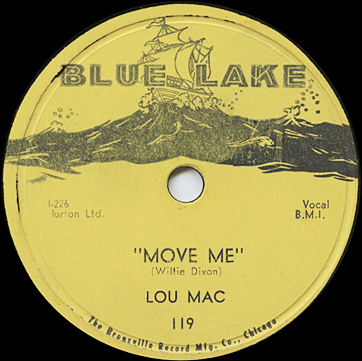
Burton continued promotion on Parrot 822 and Blue Lake 118. The first ad from the State Street address, for "Tell It like It Is" (Cash Box, March 24, 1956, p. 35) mixed Parrot 822 up with Blue Lake 118. Subsequent ads (March 31, p. 24; April 7, p. 32) got the label and release number right.
It used to be no one thought Burton had put out Parrots and Blue Lakes on his own. But Parrot 823 by St. Louis Jimmy and Blue Lake 119 started being promoted after he bought the company.
Burton turned to Red Saunders to provide backings for St. Louis Jimmy and Lou Mac (who was making her fourth appearance for the company). In place of Red's long-time tenor saxophonist, Leon Washington, another Parrot veteran, Paul Bascomb, worked the session.
Lou Mac performed a great Willie Dixon song, "Move Me," in her declamatory style, and Paul Bascomb got a brief solo. "Take Your Trouble to a Friend," a sentimental number with lots of redundant piano triplets, includes a tenor solo in the manner of Ben Webster.
The new matrix series with a B prefix signals Burton's involvement as well. (The matrix numbers in the vinyl for the B series run 823, 824, 825, 826, whereas the matrix numbers on the labels run 223-226.)

The oldest blues artist to record for Parrot/Blue Lake, St. Louis Jimmy was born James Burke Oden in Nashville, Tennessee, on June 26, 1903. He began his extensive recording career in 1932. His most famous song is "Going Down Slow," which he had recorded for Bluebird (1941), King (1945), and Bullet (1947) before cutting this Parrot session with Red Saunders. "Murder in the First Degree" is not nearly so well-traveled. It probably originated as "She's Killing Me," a never-issued side that he cut with Jump Jackson's band for Columbia on September 13, 1946 (see our Sax Mallard discography for details). The Parrot session produced St. Louis Jimmy's last commercial single. He did not give up on "Going Down Slow," however, subsequently recording it for Bluesville, Delmark, and Spivey; he also made a memorable guest appearance in 1960 on an Otis Spann album for Candid. During his declining years, St. Louis Jimmy lived in the basement of Muddy Waters' house and probably partnered for a time in one of the later editions of J. Mayo Williams' boutique label, Ebony; he died of pneumonia, in Chicago on December 30, 1977.

Burton tried to run Parrot and Blue Lake for just a few months. He recorded all of four sides—an afterthought. On June 30, 1956 (p. 26), Cash Box announced that "Burtone Records, a jazz LP line" would be putting out albums by Johnny Griffin and Paul Bascomb (both names were misspelled in the item). "Transfer of the Parrot twelve incher by pianist Ahmad Jamal to Burtone expected." But nothing came of any of this. The only other Burton-era release of Parrot material was a reissue of Ahmad Jamal on Parrot 818, which was reviewed in the trade papers in October 1956.
In 1956 Burton started his El-Bee label on which he recorded bluesman Freddy King and a vocal group, the Foster Brothers. He also started his Sapphire label. The initial release by The Nobles, on Sapphire 151, was advertised in Cash Box on July 28, 1956 (p. 126) and reviewed on August 4 (p. 30). New recording for Parrot or Blue Lake was now out of the question.
| Matrix | Artist | Title | Issue | Recording Date | Release Date |
| B 823 [B-223 on label] |
St. Louis Jimmy | Going Down Slow | Parrot 823 | May 1956 | June 1956 |
| B 824 [B-224 on label] |
St. Louis Jimmy | Murder in the First Degree | Parrot 823 | May 1956 | June 1956 |
| B 825 [B-225 on label] |
Lou Mac | Take Your Trouble to a Friend | Blue Lake 119 | May 1956 | June 1956 |
| B 826 [B-226 on label] |
Lou Mac | Move Me | Blue Lake 119 | May 1956 | June 1956 |
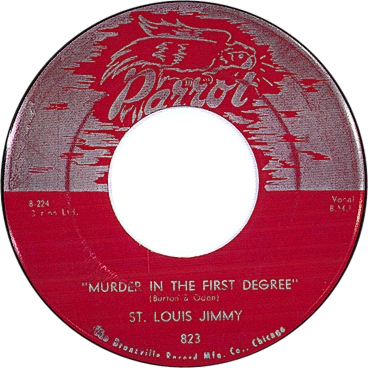
Parrot recorded 12 sides before its formal launch in June 1953, and 273 afterward. Benson leased another 10, for a total of 295 sides. We know of 40 singles released on the main Parrot series, a total of 80 sides. Since these Parrots followed a numerical sequence from 780 through 823, the following omissions are significant: 801, 803, 804, and 805. (Bootlegs numbered 801, 803, and 804 have appeared; original releases have not been reported.) The missing items may, of course, have been planned but aborted for one reason or another.
There are also Parrots in different series: 105, 106, 107, 109, 772, 775, 1000, 1001, 1050, 6000, and 7000, for a total of 11 releases and 22 sides. 1050 virtually coincided with a release on Checker; 772 and 775 occupied spots in the Checker release series but only appeared on Parrot; Benson put the others out after formally announcing the Parrot label.
Blue Lake is known to have come out with 18 singles in its main series (36 sides). These ran from 101 through 119, except that no Blue Lake 110 has been verified. We've heard talk that 110 was by L. C. McKinley, but John Tefteller, who has a nearly complete collection of Parrots and Blue Lakes, has never seen it. There was also a Blue Lake 1001, which gives us two more sides.
Two Blue Lakes (113, 1001) replicated the contents of two Parrots (813, 1001).
Through three were promised, in the end there was just one Parrot LP, Ahmad Jamal Plays. Parrot LP100 was pressed on extremely thick vinyl, according to Bob Javors and Zeno Okeanos; Bob Sladek reports that some copies were pressed on red vinyl.
Could there be Parrot and Blue Lake releases beyond those covered here? The Blue Lake 100 series and the Parrot 780 series have gotten a lot of attention in the past and further discoveries seem unlikely. But Benson's gospel releases have poorly served by discographical research and the Parrot 100 and the Parrot/Blue Lake 1000 series might warrant a further look.
As we've noted, the remains of Parrot and Blue Lake passed into the hands of John Henry "Lawyer" Burton in March 1956. Burton briefly put out one new Parrot and one new Blue Lake in June. A reissue of Parrot 818 by Ahmad Jamal, in October 1956, was his last hurrah.
Al Benson had a last fling at the record business in 1965-66 when he issued 45s by Jimmy Dobbins, Ray and Dave, The Steelers, Magic Sam, Big Moose Walker, and Shakey "Joke" (i.e., harmonica player and singer Shakey Jake) on his labels Mica, Crash and The Blues. He had left WGES in 1962 and eventually retired from DJing in 1974 because of ill health. Having moved to Michigan some years earlier, he died there in 1978.
Since John Burton was also the attorney for Chess Records, most Parrot items were leased to Chess over the years (how many of them were actually sold we have no idea). The first transaction he conducted, while he still was operating Parrot and Blue Lake, involved the Flamingos: Chess used some of their masters on Checker singles in 1956. Burton apparently also leased some of the J. B. Lenoir sides to Chess. Probably in the late fall of 1956, right after closing down the operation, Burton unloaded the Parrot Ahmad Jamal LP to the Chess brothers; it was promptly released on Creative Argo (or should we say Argo Creative?) LP-602 before the Chess brothers simplified the name to Argo.
Chess reissues in the Vintage Series of LPs (which was under way in 1969, and began its releases in 1971) have stated that various Parrot blues sides changed hands in 1959. The list of Parrot tapes has survived, but there is no legal paperwork extant from the big transaction that took place in 1958 or 1959. We have no idea why certain items were left out. Chess ended up with recording sheets for the Five Thrills session of October 1953, but not tapes; the label got nothing from the King Fleming, Sunnyland Slim, or Baby Boy Warren sessions for Blue Lake; it got some of the Parrot gospel but not Bessie Griffin, the Peace Makers, or the Veteran Singers.
The Johnny Griffin LP saw release on Argo in 1958. The long-missing Paul Bascomb LP session tapes were included in the big transaction, but Chess never did anything with them, and we can only hope they are still extant. New matrix numbers affixed to the Jimmy Rushing session suggest that Chess remastered it in 1960 or 1961, but the company used none of the material till 1972, when some of it popped up on a Vintage Series LP. Three jazz sessions from 1953 would also mined for the Vintage Series: the Leo Parker session from August, the Lonnie Simmons session of October 15, and Red Saunders' instrumentals from December 31, 1953. On the blues side, the Chess Vintage series incorporated tracks recorded for Parrot by Albert King, John Brim, and J. B. Lenoir but passed over the rest.
Meanwhile the Joe Williams session was sold to Regent/Savoy while Burton was in charge, and the Coleman Hawkins numbers went at the same time (neither was therefore included on the list of masters later dealt to Chess). Regent 6002, Joe Williams Sings, was released in August 1956 (reviewed in Billboard on August 25, 1956, p. 29). Most of what remained after the Savoy acquisitions (minus the Ahmad Jamal tapes) was bought many years later by Donn Fileti's Relic Records. In the 1980s and early 1990s Relic was quite thorough in its program of releasing previously unknown material, but is now inactive. The Parrot/Blue Lake jazz material, which drew less interest from Relic, was acquired by Empire Musicwerks and released on a CD in December 2002.
The charts that we present here began their evolution with two lists, one for Parrot and one for Blue Lake. These were originally compiled by the late Kurt Mohr (1921-2007 ) and the late Marcel Chauvard (1926-1968) some time in the sixties. Much of the dating for the doowop items is from Robert Pruter's Doowop: The Chicago Scene.
Additions come from different standard and non-standard sources. We are particularly indebted to Ferdie Gonzales (compiler and researcher of Disco-File) and Robert Ferlingere, author of A Discography of Rhythm & Blues and Rock 'n Roll Vocal Groups 1945 to 1965 (2nd ed., 2 vols., 1992), for correcting many of the release dates.
A few more recording dates, many matrix numbers, and bountiful information about unissued material, including copies of the recording sheets from Universal Recording, were graciously provided by Donn Fileti, the proprietor of Relic Records.
Dan Ferone of Beverly Records in Chicago provided us with a Chess Records in-house list of Parrot material bought or leased in 1958 or 1959 (it was part of the working papers assembled for the Chess Vintage LP series in 1969). The Chess in-house list sometimes provides titles and artists where the tape boxes and recording sheets available to Fileti did not. It also provides a file number (from Universal Recording) for each tape box. While mentioning some recordings unknown from other sources, it leaves off other recordings known to have been made for Parrot and Blue Lake. And like other lists that came from the Chess archives, it is rife with misspellings and artist identifications that apply to only some of the material in a given box.
Additional information (and in some cases, significant corrections to our release dates) comes from Galen Gart's books, and from record collectors Robert Javors, Dr. Robert Stallworth, Mike Kredinac, Brent Campbell, and Zeno Okeanos. Bob Djukic turned up the elusive first reissue of the Ahmad Jamal LP, on Argo 602 with the short-lived "Creative" logo. Many corrections from the labels were provided by Tom Kelly. Further corrections to our still underfed gospel listings were provided by gospel discographer Bob Laughton. The late Vernel Fournier and Norman Simmons provided details about Paul Bascomb's band; Shirley Klett chased down information about the still-enigmatic Herbie Fields session; Scott Dirks provided us with further information about the Little Papa Joe session; and Lewis Porter and Alexa Kinni tracked down the court order changing Fritz Jones' name to Ahmad Jamal.
We have further benefited from the series of articles by Bernd Kratochwil, "Die Geschichte des Entrepreneur Al Benson aus Chicago, oder die labels 'Old Swingmaster,' 'Parrot,' und 'Blue Lake,' " which appeared in the German magazine Rockin' Fifties in 1997 and 1998. Part 2 covers Old Swing-Master; Parts 3.1 and 3.2 cover Parrot; and Part 4 is devoted to Blue Lake.
Click here to return to the Red Saunders Research Foundation page.